Here are Iceland’s most active volcanoes and how to visit them
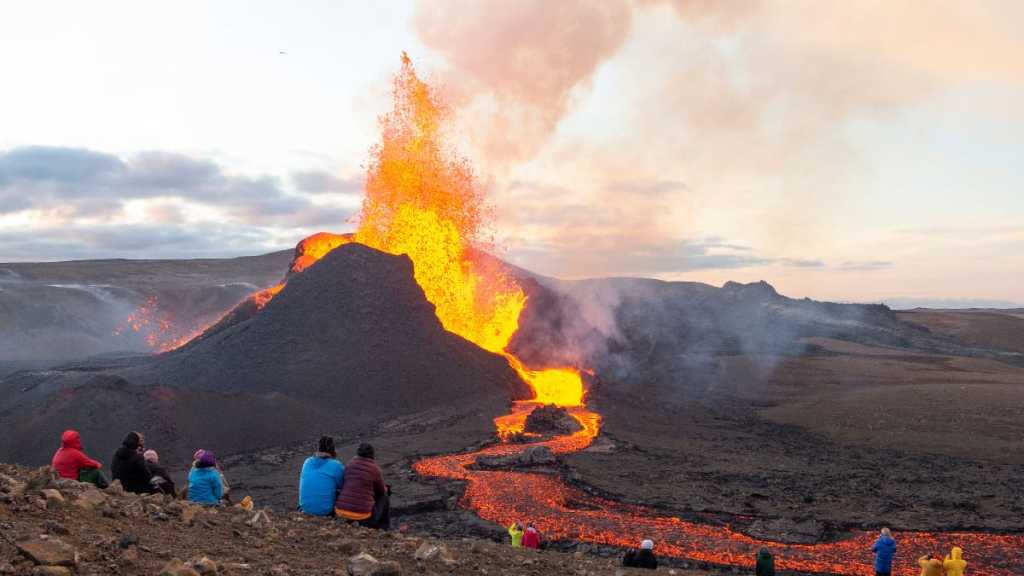
📌 Read in / Lire en : Français ( French )
In the grand orchestra of nature, Iceland’s volcanoes play a symphony of creation and destruction in a relentless rhythm. It’s on this land of extreme contrast, where fire meets ice, that a complex network of volcanoes stands, some sleeping peacefully, others murmuring softly, signalling a raw power ready to unleash at any moment. But which are the most monitored? From Grímsvötn to Eyjafjallajökull, here are Iceland’s most active volcanoes – which, nonetheless, can be visited, as it would be a pity not to.
❓ Italian threat . A common question for travellers heading to Naples, Italy: can Mount Vesuvius erupt? Here’s our answer .

Why are there so many volcanoes in Iceland?
The answer lies in its unique position on the Mid-Atlantic Ridge, a tectonic boundary where the Eurasian and North American plates are continually drifting apart. This ongoing separation, at a rate of about 2.5 centimetres per year, allows magma to emerge from the depths of the Earth, fuelling the magmatic chambers of Icelandic volcanoes and creating new land formations.
The effects of this phenomenon are not limited to spectacular eruptions and the creation of new terrain. It also shapes a rich geothermal landscape with hot springs, geysers, and fumaroles, highlighting the underground volcanic activity taking place just beneath our feet.
The seven most threatening volcanoes in Iceland
Grímsvötn volcano.
🌋 Last eruption : 2021
📍 Location : southeast Iceland ( map )
Description : Grímsvötn, nestled under the Vatnajökull glacier, is Iceland’s most active volcano, with about 65 known eruptions over the last 800 years . It’s characterized by frequent, but relatively small eruptions. The heat of the volcano causes constant melting of the glacier, creating a subglacial lake that can lead to glacial floods called “jökulhlaups” when it overflows. Grímsvötn’s eruptions tend to be explosive due to the interaction of hot lava with glacier water.
🗺️ How to visit Grímsvötn Volcano? Generally, Grímsvötn itself is not a common destination for average tourists due to its limited accessibility and potentially dangerous conditions associated with volcanic activity and glacial conditions. However, you can access Vatnajökull, the largest ice cap in Iceland and the second-largest glacier in Europe
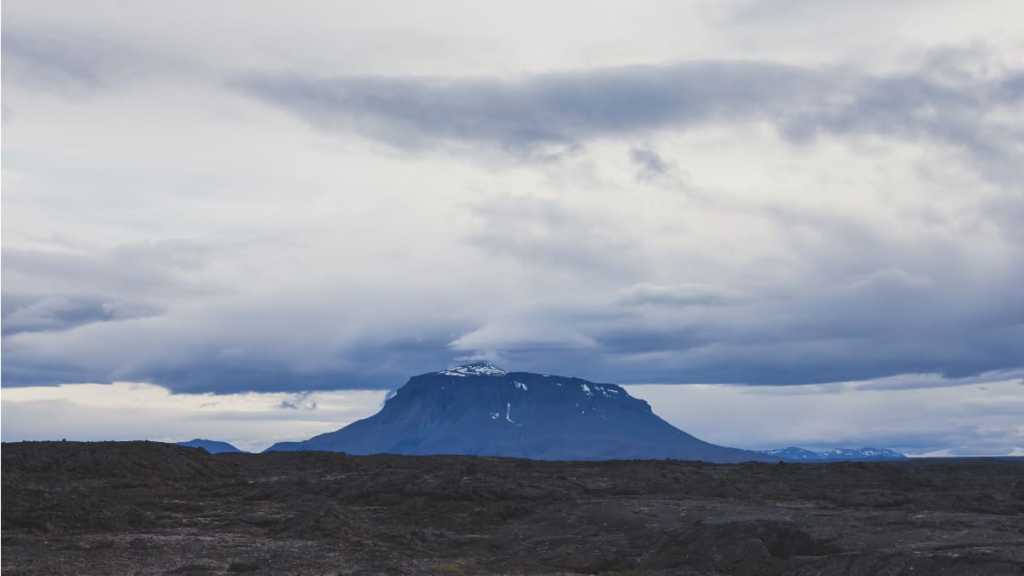
The Bárðarbunga volcano
🌋 Last eruption : 2014-2015
Description : Bárðarbunga is another giant located under the Vatnajökull glacier. Its last eruption, between 2014 and 2015, produced the largest lava flow in Iceland in over 200 years. This complex volcanic system includes a large caldera and a network of fissures extending over several kilometres. It is continuously monitored due to its potential for significant and potentially dangerous eruptions.
🗺️ How to visit the Bárðarbunga volcano ? Like Grímsvötn, visiting Bárðarbunga is a serious undertaking due to the harsh conditions and risks associated with volcanic activity. Typically, excursions to Bárðarbunga are carried out by scientific research teams, not tourists. However, specialized companies do offer guided tours to the volcano, especially when there are no signs of imminent activity. The easiest way to admire it is by opting for a helicopter tour.
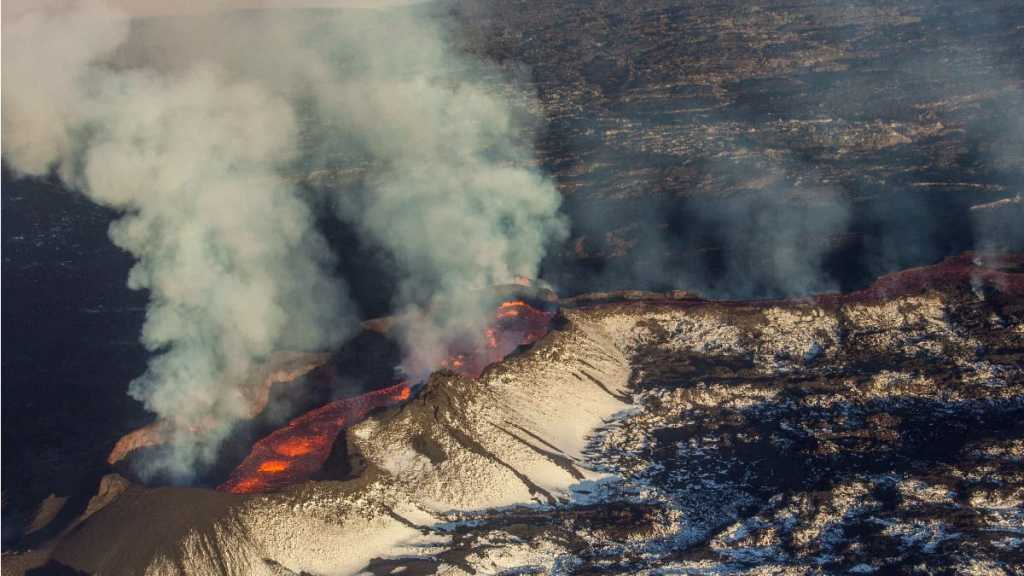
The Hekla volcano
🌋 Last eruption : 2000
📍 Location : southern south Iceland ( map )
Description : Hekla is one of Iceland’s most famous and active volcanoes. With a history of violent eruptions, some of which have thrown ashes as far as continental Europe, it’s nicknamed “The Gateway to Hell” by locals. Hekla is known for its unpredictable eruptions, with very short warning signs, making monitoring and preparation essential for the safety of surrounding communities.
🗺️ How to visit the Helka volcano? Unlike some other volcanoes in Iceland on this list, Hekla is more accessible, and there are several options for visiting this impressive site. The best way to explore it is to join a day tour from Reykjavík, with experienced guides to ensure a safe and enriching visit. The hike, taking about eight hours in total, is best undertaken in summer.

The Katla volcano
🌋 Last significant eruption : 1918
Description : Located under the Mýrdalsjökull glacier, Katla is one of Iceland’s most powerful volcanoes. Despite a period of relative inactivity since its last major eruption in 1918, the volcano has experienced a number of minor eruptions, the latest in 2011. It is constantly monitored, as a major eruption could potentially cause significant glacial floods and disperse volcanic ashes over vast areas.
🗺️ How to visit the Katla volcano? Again, this is a bit complex as it’s located under an ice cap. However, a trail allows you to walk on the glacier, always a memorable experience. Moreover, the area is traversed by ice caves that you can explore – not all of them, depending on conditions. For instance, Troll Expeditions offers tours in this truly magical place.
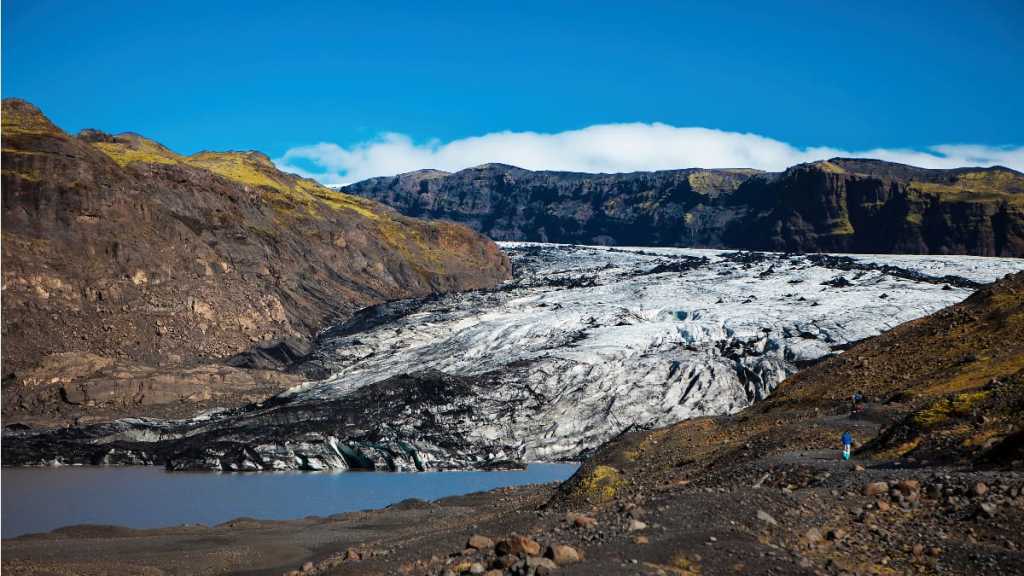
The Eyjafjallajökull volcano
🌋 Last eruption : 2010
Description : The 2010 eruption of Eyjafjallajökull brought this volcano into the global spotlight, severely disrupting European air traffic for several weeks. Located west of Katla, it is often closely monitored, as historical activity suggests that eruptions of Eyjafjallajökull can sometimes precede more dangerous eruptions of Katla.
🗺️ How to visit the Eyjafjallajökull volcano? If you still have the impressive images of the 2010 eruption in mind, rest assured: it can be easily visited by taking the south side. Tours generally start from the nearby town of Hvolsvöllur. But again, it’s best to be accompanied by professionals for a jeep or snowmobile outing.
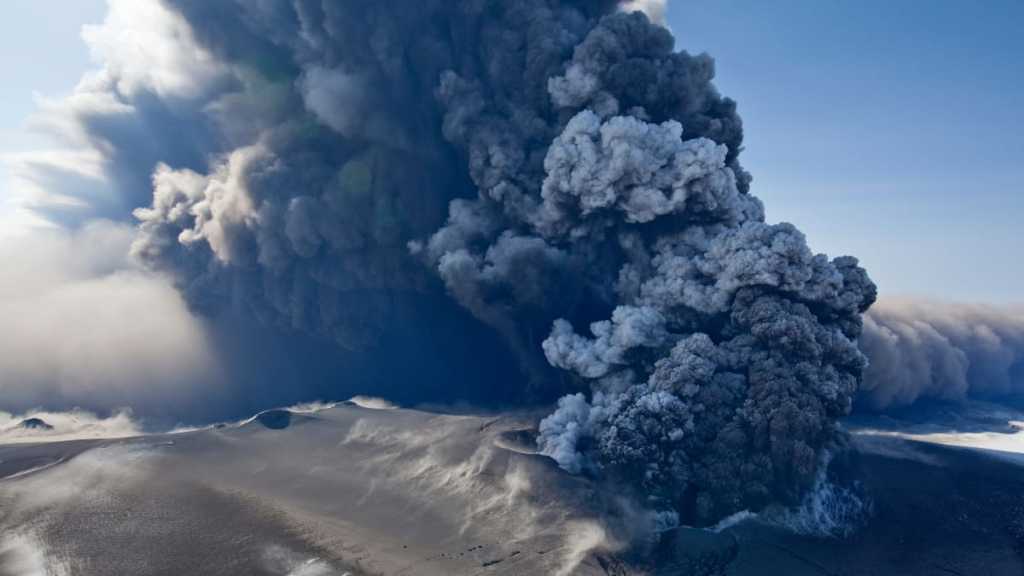
The Öræfajökull volcano
🌋 Last eruption : 1728
Description : Part of the Vatnajökull glacier system, which we’ve already discussed, Öræfajökull is Iceland’s largest active volcano and also hosts the country’s highest peak, Hvannadalshnjúkur. Its last eruption in 1728 was followed by a long period of inactivity. However, signs of increasing activity since 2017, including the expansion of a caldera and increased seismic activity, have led to heightened monitoring.
🗺️ How to visit the Öræfajökull volcano? The Vatnajökull glacier, which covers it, offers visitors unforgettable walks, organized by local agencies. You’ll find scenic trails and glacial lagoons, like the famous Jökulsárlón.

Fagradalsfjall volcano
📍 Location : southwest Iceland ( map )
Description : Located on the Reykjanes Peninsula, Fagradalsfjall captivated the world’s attention with its 2021 eruption, showcasing spectacular lava fountains. While the eruption posed no significant threat to nearby populated areas, it provided a visual reminder of Iceland’s dynamic geological activity.
🗺️ How to visit Fagradalsfjall volcano? Although it has shown recent activity, you can approach the volcano from its south side. There are several trails (A, B, and C), but they are modified depending on the lava flows of the giant. Taking a guide is, once again, a good idea. The reward? An incredible landscape of rocks and furrows shaped by fire.
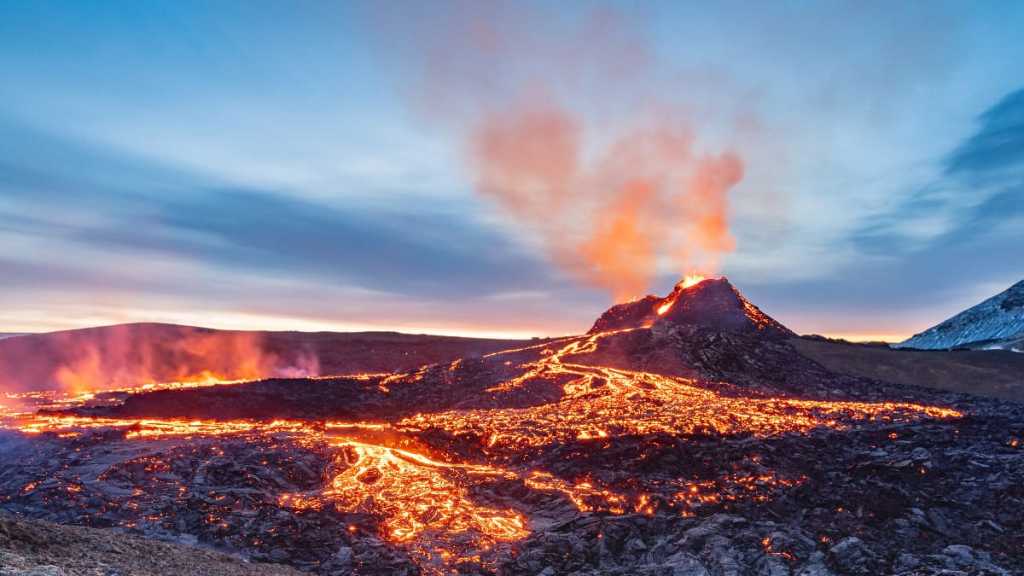
Travelling to Iceland: how to find out about volcanoes at risk?
Worried about a volcanic eruption in Iceland during your stay? First, don’t panic; most of these eruptions do not impact the lives of residents or tourists. Nonetheless, it’s important to stay well-informed.
Firstly, you can visit the Icelandic Meteorological Office’s website , where you’ll find regularly updated information on seismic and volcanic activity. Additionally, for those interested in more in-depth analyses and articles on Icelandic geology , the Iceland Geology website is an invaluable resource.
In case of activity, don’t forget to check the road conditions and driving situation on the website of The Icelandic Road and Coastal Administration . This will allow you to plan your route realistically and safely, considering current and forecasted conditions, especially in areas near active volcanoes.
Finally, for comprehensive coverage of safety measures and evacuation procedures, the Department of Civil Protection and Emergency Management is the ideal place to stay informed. It’s recommended to follow their updates and advice to ensure a trouble-free trip.
We hope this overview of active volcanoes in Iceland helps you better plan your stay or answers some of your questions. Enjoy your Icelandic journey!
Destination(s) Europe
Contenu rédigé par les blogueurs de la rédaction | Article by the Editorial Staff
Leave a Reply Cancel reply
Nous utilisons des technologies telles que les cookies pour stocker et/ou accéder aux informations relatives aux appareils. Nous le faisons pour améliorer l’expérience de navigation et pour afficher des publicités (non-)personnalisées.
Discover more from Destination(s) Europe
Subscribe now to keep reading and get access to the full archive.
Type your email…
Continue reading
Thanks for visiting nordicvisitor.com! For the very best browsing experience on our website, we urge you to upgrade to the most recent version of your browser . Some of our site features may not function properly on older versions.
- Travel Update
- Search Suggested Results View All Results
- EUR (€)
- GBP (£)
- Self-Drive i
- Privately Guided i
- Guided Small Groups i
- Northern Lights i
- Honeymoon & Romance i
- Ice & Snow Hotels i
- Multi-Country Tours i
- All Travel Styles
- Show all tours
- Best Sellers
- Special Offers
- Scandinavia
- Switzerland
- United Kingdom
- Book With Confidence i
- Why book with us i
- Booking Terms i
- Sustainability Policy i
- Manage Booking
- Privacy policy
Iceland Bíldshöfði 20 110 Reykjavík +354 578 20 80 View Map
Sweden Scotland View Details
8 Volcanic Experiences to Have in Iceland
Iceland is perhaps best known for its “Land of Fire and Ice” nickname, earned from its long history of eruptions at volcanoes with tongue-twisting names. Eyjafjallajökull, anyone?
But keep in mind that, like the northern lights, volcanic activity doesn't happen on demand. That said, eruptions do happen! You'll be able to safely visit volcanic places on your trip to Iceland , including both ancient and active sites.
Let's take a look at 8 impressive volcanic attractions you could check out in Iceland.
- Learn about the latest volcanic activity on our eruption news page
- Explore exciting volcano tours in Iceland
Good to know: At Nordic Visitor, we stay up-to-date with volcanic activity in Iceland. We also make sure our clients are informed about any potential disruptions to travel plans and take care of any itinerary changes.
1. Eruption on the Reykjanes peninsula
Located in the southwest of Iceland , this region has plenty to offer on your adventure. Here, you’ll find the Keflavík International Airport, the Blue Lagoon and the Fagradalsfjall volcano .
Before 2021, this volcano lay dormant for around 800 years. But now, the Reykjanes peninsula is active, with several eruptions in the area in recent years. This has meant the area, once seen as a sleeping giant, is now a hub of intense geological activity.
This is all thanks to its location on the Mid-Atlantic Rift, where the North American and Eurasian tectonic plates drift apart. That’s why you’ll see active volcanoes, moss-coated lava fields and cone-shaped mountains.
To stay up-to-date with the latest information about volcanic events in Iceland, check out the following sites:
- Safe Travel Iceland – for safety alerts
- Icelandic Met Office – for information on seismic activity and the weather
- Visit Reykjanes – for information on the hiking trails and where to park
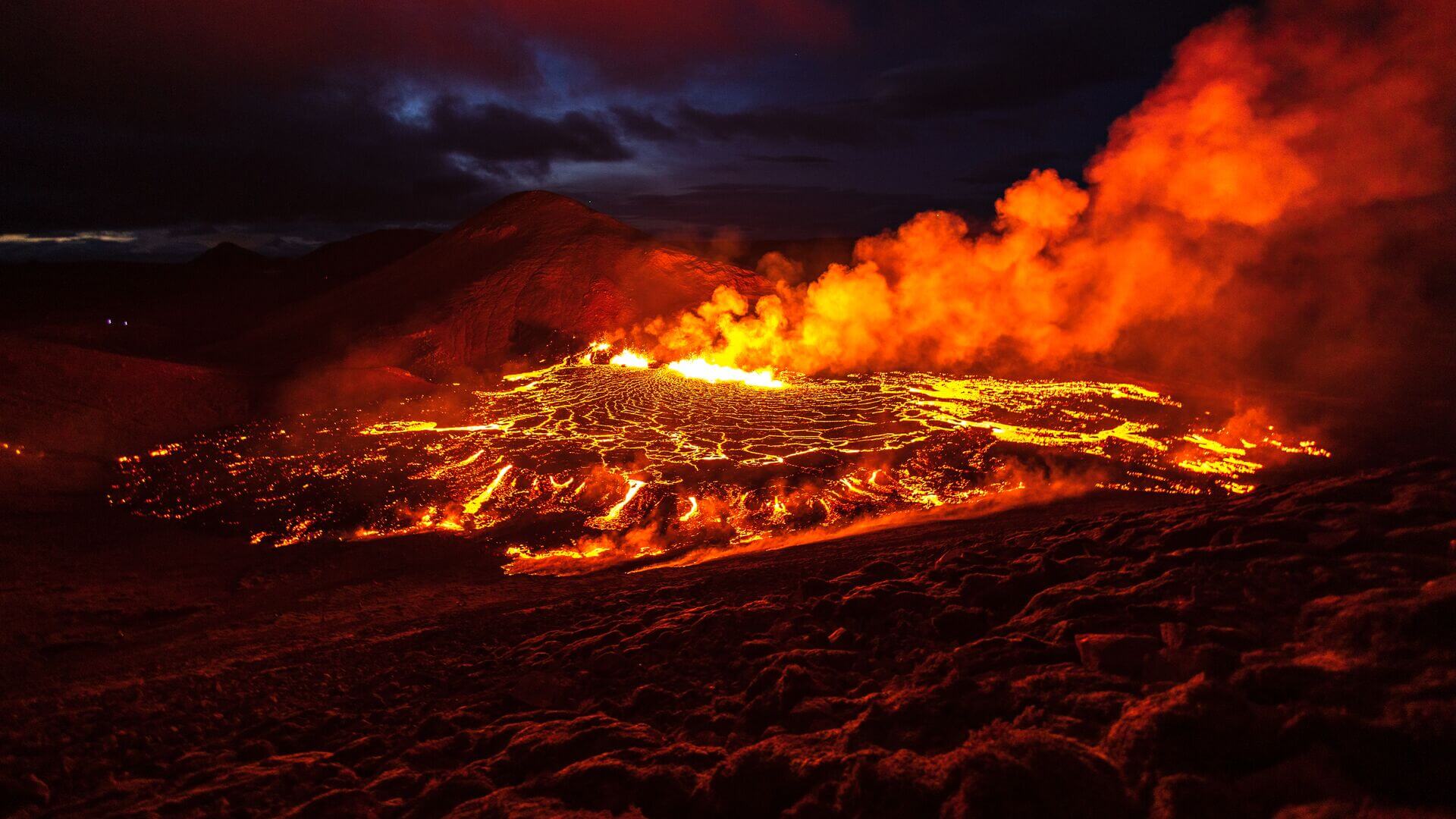
2. The Volcano House in Reykjavík
Before venturing into the Icelandic countryside to see actual volcanic sites, why not take some time to learn about volcanoes in the capital city?
Located right by the old harbour in the Reykjavík city centre, the small Volcano House museum features exhibitions on Iceland’s geological history as well as a collection of volcanic rocks (that you can touch!).
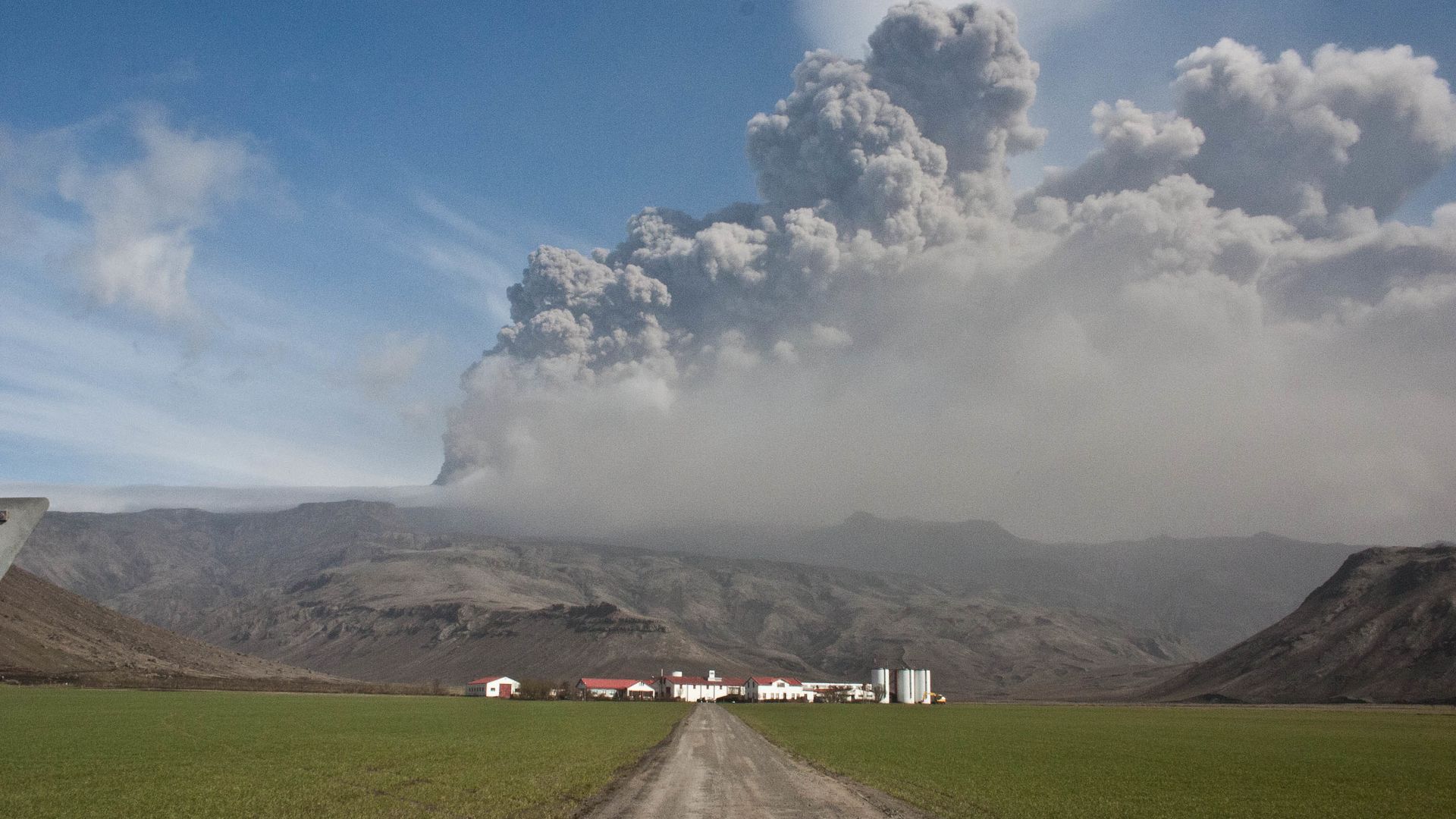
It also screens two documentaries about famous eruptions. The first one is about the sudden eruption in the Westman Islands (which you can read about below). The other covers the famous 2010 volcanic eruptions at Eyjafjallajökull and Fimmvörðulháls.
- Discover volcanoes as part of a self-drive tour in Iceland
3. The Eldheimar Volcano Museum in Heimaey
Vestmannaeyjar, or the Westman Islands , is a stunning archipelago off Iceland’s south coast. Sometimes called “Pompeii of the North,” all of the archipelago’s islands have evolved from underwater eruptions.
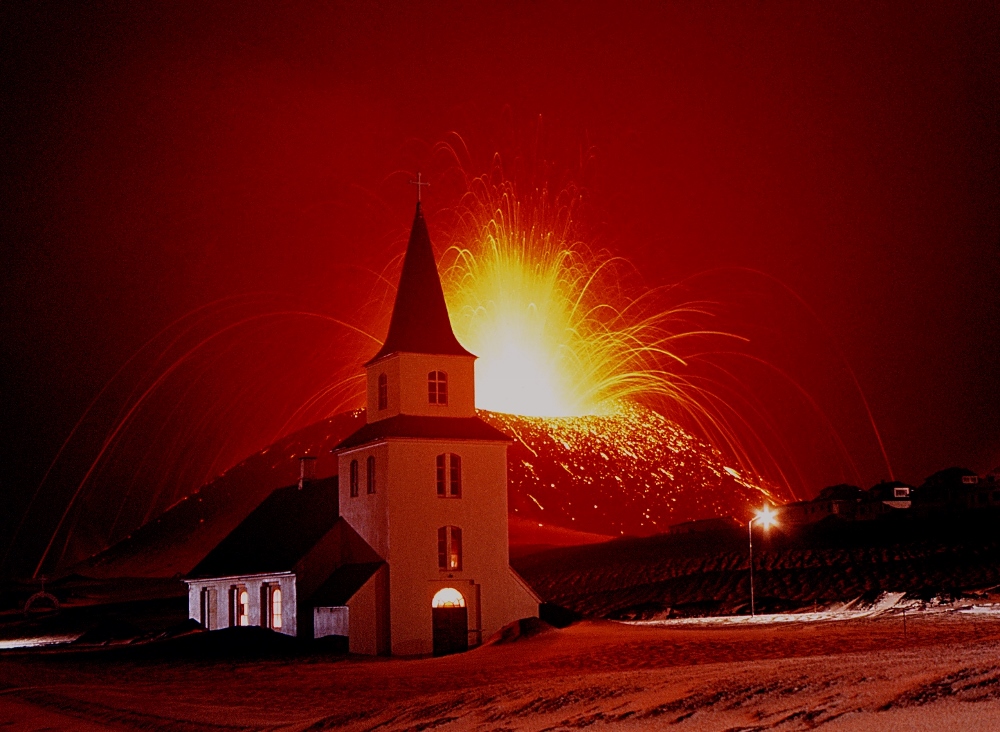
Heimaey, the only inhabited island, was the site of an eruption in 1973. It buried 400 buildings under thick lava, some of which have been partially uncovered and preserved.
The Eldheimar Volcano Museum in town focuses on this event, which is today considered one of Iceland’s largest natural disasters. The exhibit looks at the lives of the residents before the eruption that saw them evacuating their homes in the night and never being able to return.
4. The Lava Centre in Hvolsvöllur
If you came to Iceland to experience the Land of Fire and Ice, the Lava Centre museum in South Iceland is worth a visit. This innovative museum opened in 2017 not far from Mount Hekla, an active volcano that was considered to be the gateway to hell in the Middle Ages.
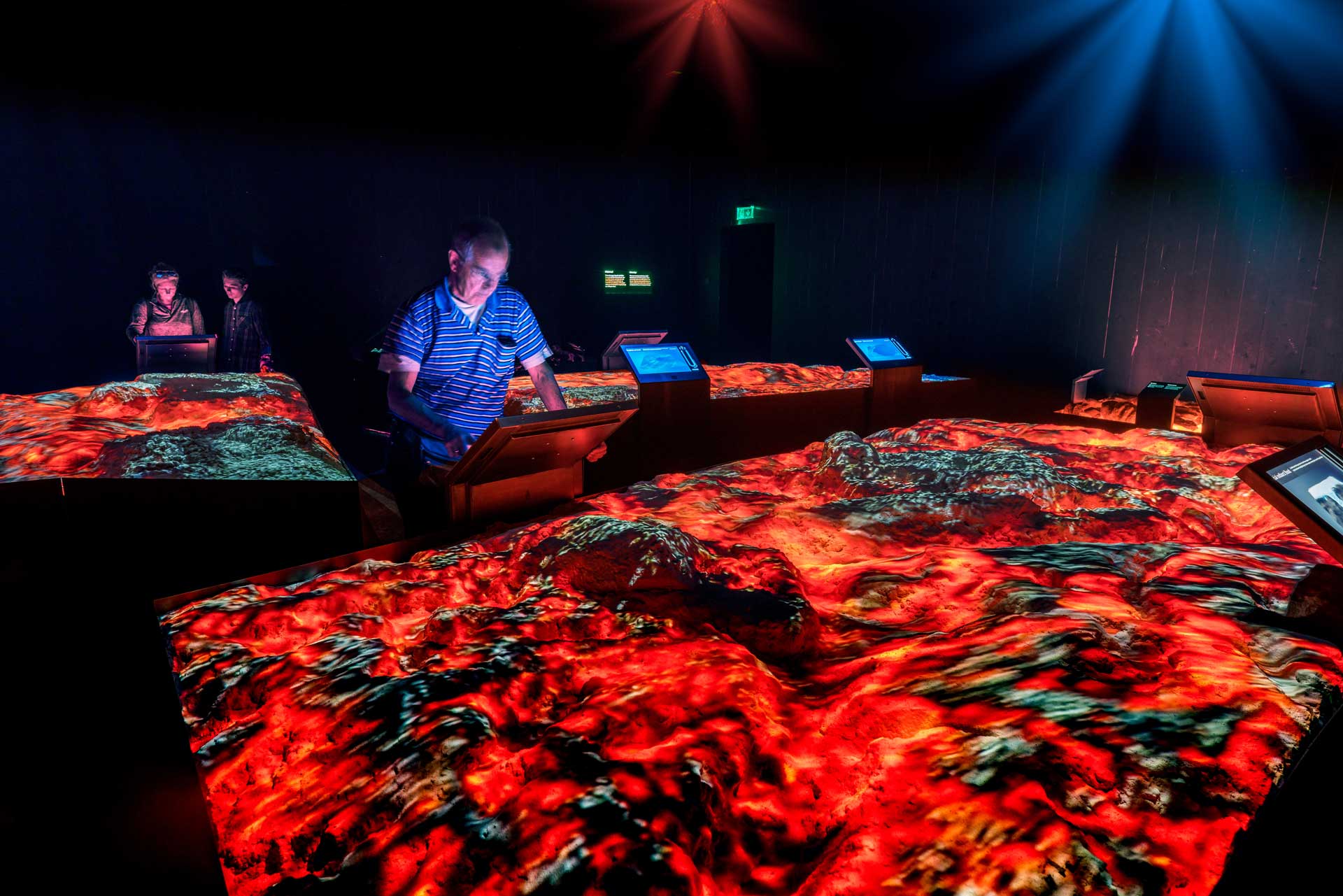
Inside, the interactive, state-of-the-art exhibit depicts millions of years of Icelandic volcanic activity. It covers earthquakes, eruptions, glacial floods, rift systems and the formation of Iceland's landmass.
If all that tectonic rumbling makes your stomach rumble, you can grab a bite at the onsite Katla Restaurant, aptly named for one of Iceland's largest volcanoes.
- See the country with a local expert on one of these privately guided Iceland tours
5. Snæfellsjökull National Park in West Iceland
Located at the tip of the Snæfellsnes peninsula in West Iceland, the terrain of Snæfellsjökull National Park looks as though it was ripped from prehistoric times.
The park is named for the prominent, glacier-topped Snæfellsjökull volcano, which Jules Verne famously used as the setting for his classic novel Journey to the Center of the Earth .
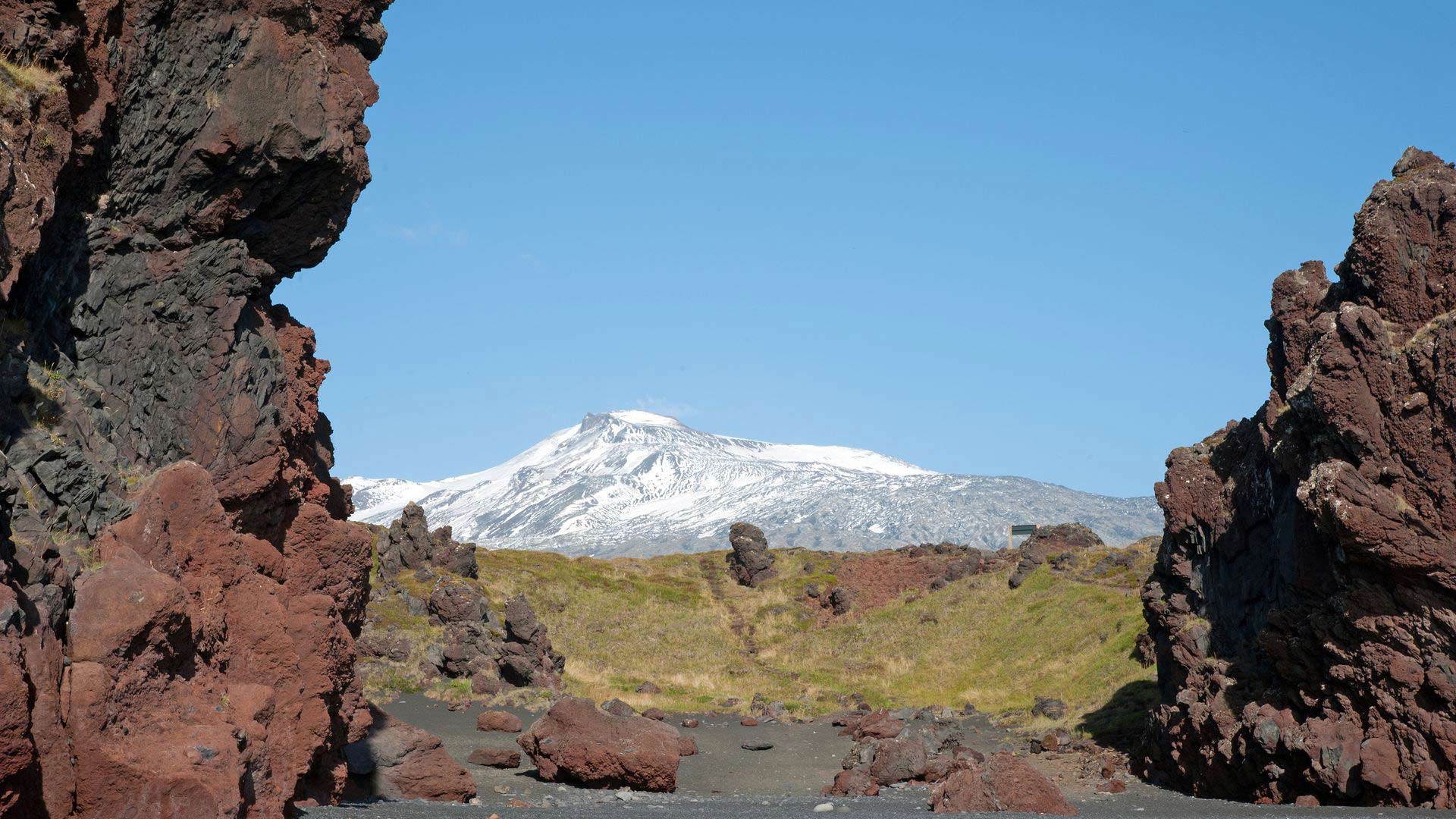
This park boasts many other unusual volcanic landforms to explore, such as Djúpalónssandur beach with its smooth black pebbles and "lifting stones", and the beautifully secluded Dritvík cove. You could also discover the jutting cliffs at Lóndrangar and the extensive lava fields surrounding the volcano.
For a closer look at the area's volcanic history, you can even join a guided tour of the Vatnshellir or Víðgelmir cave.
6. "Inside the Volcano" tour near Reykjavík
Not only can you walk into a glacier in the Land of Fire and Ice, but you can also go deep inside a dormant volcano.
The Inside the Volcano day tour is a real-life journey to the centre of the earth. You descend 120 metres (394 feet) via a cable lift into the ancient magma chamber of the Thrihnukagigur volcano. From the bottom of the cave, you’ll be able to marvel at the colourful lava-rock walls.
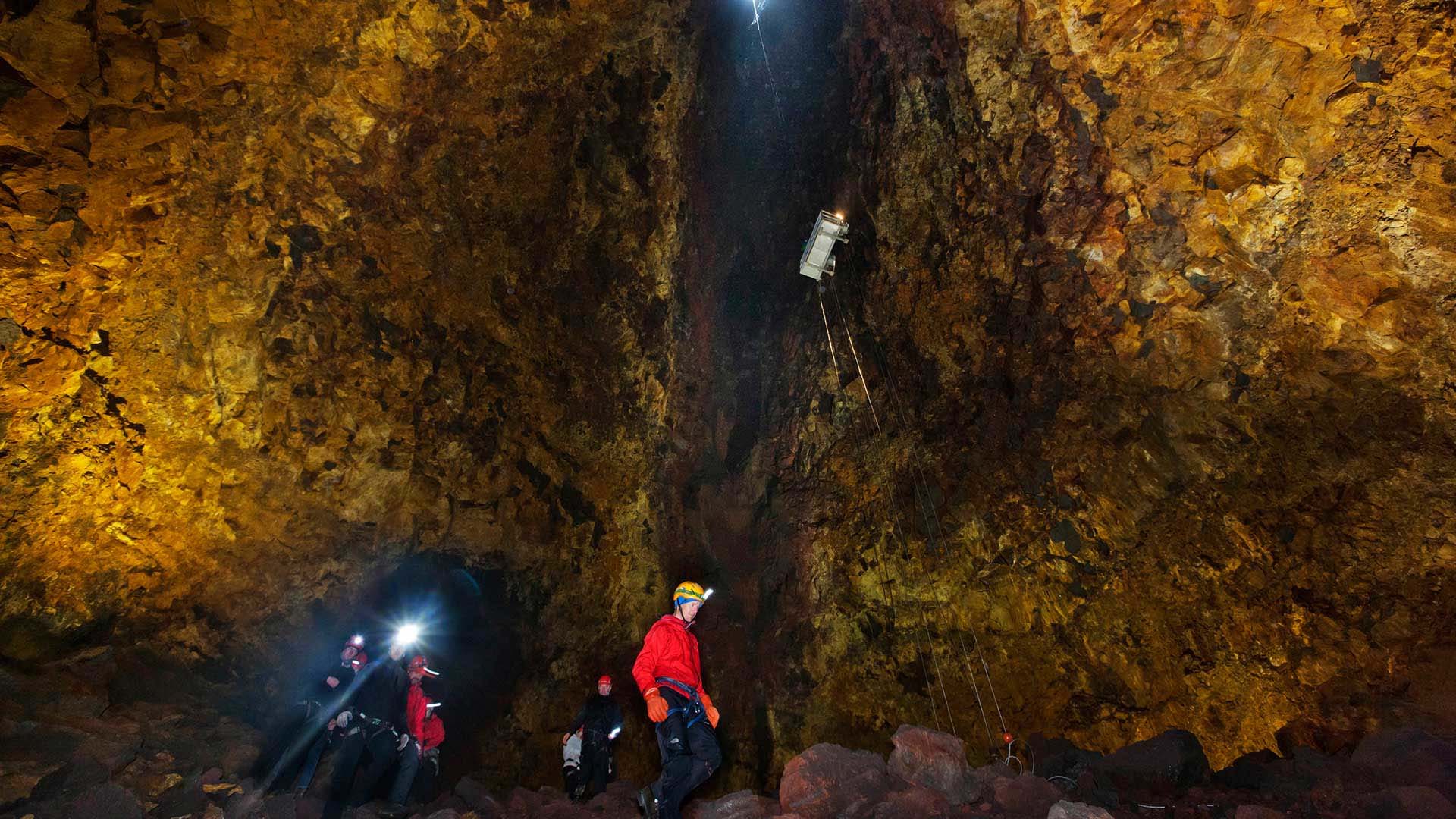
For a similarly adventurous experience not far from this volcano, we recommend a guided "Lava Tunnel" tour inside the Raufarhólshellir lava cave.
- Experience the Land of Fire and Ice on a guided small group tour of Iceland
7. Hverfell volcanic crater in North Iceland
The Lake Mývatn area of North Iceland is a hotbed of unusual volcanic terrain and geothermal activity .
At 1 kilometre (0.6 miles) in diameter, Hverfjall is probably the biggest tephra crater in Europe, making it well worth a visit. Located nearby the popular Dimmuborgir lava formations , this enormous crater was formed in an explosive eruption some 2,500 years ago.
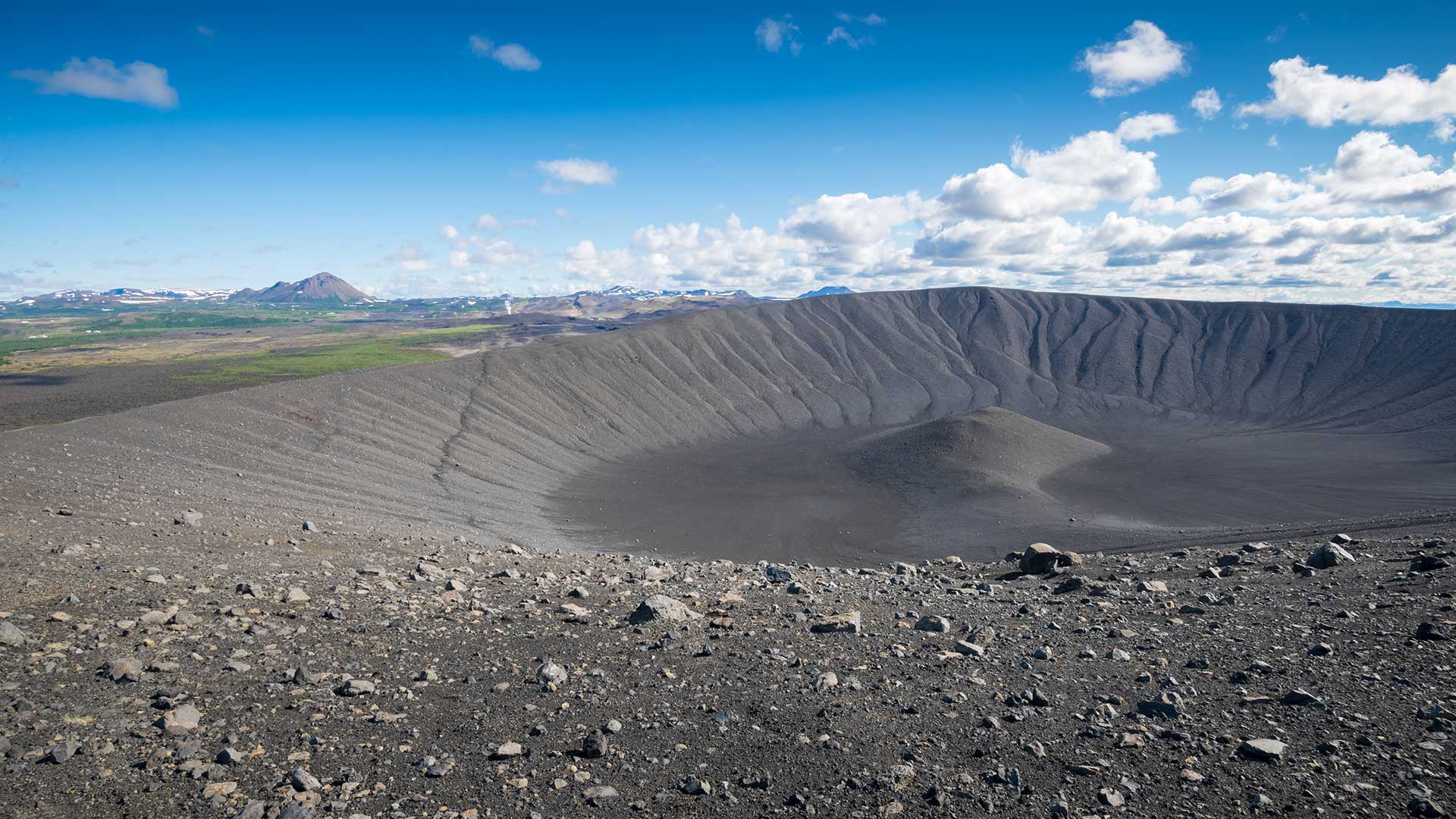
8. Krafla caldera in North Iceland
Another major Lake Mývatn area volcanic attraction is Krafla , a massive caldera with a diameter of 10 kilometres (6.2 miles) and depth of 2 kilometres (1.2 miles).
Situated along a 90-kilometre (56-mile) long fissure zone, it erupted a staggering nine times between 1974 and 1984, with 29 total eruptions in recorded history. Among these events is the “Krafla Fires,” a long-lasting eruption from 1977 to 1984.
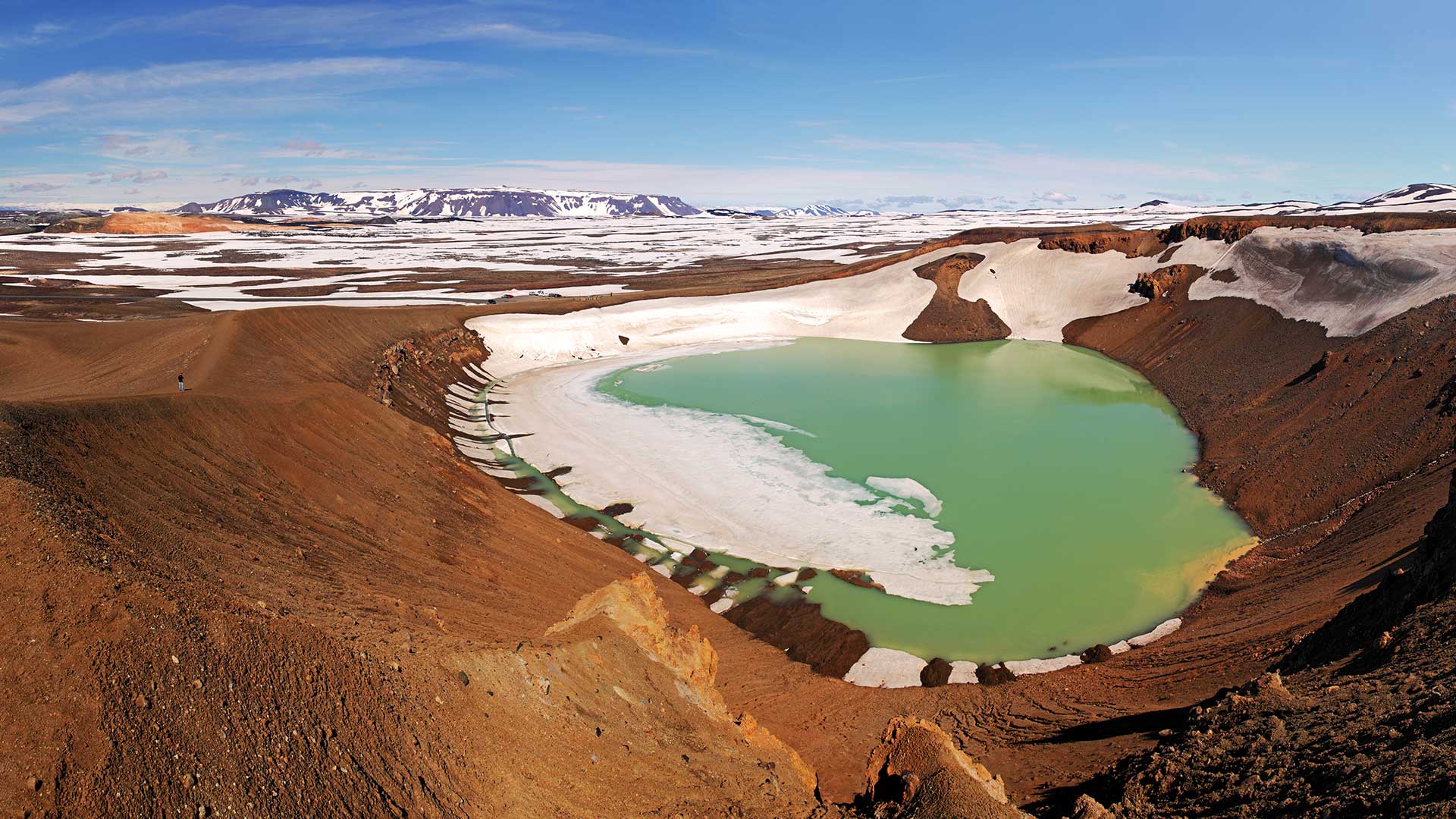
On the northwest side of the Krafla caldera is Víti, an explosion crater 300 metres (984 feet) in diameter with a greenish-blue lake inside of it. The name Víti, meaning “Hell” in Icelandic, comes from the old local belief that the underworld was located under the volcanoes in this area.
From the Krafla parking area you can walk to the edge of the rim on a marked path, guiding you through sulphur vents and rocks that are still warm to the touch from the Krafla Fires.
Want more volcanic adventures?
You could witness breathtaking natural wonders in Iceland. Imagine exploring the active Fagradalsfjall volcano on the Reykjanes peninsula, or learning fascinating stories at the Eldheimar Volcano Museum.
Each place tells a unique part of Iceland's geological history. Book an Iceland volcano tour with Nordic Visitor, and you’ll discover the incredible landscapes shaped by nature's forces.
Note: Never attempt to hike in the highlands or on glaciers without a professional, licensed guiding service.
Learn more about the Land of Fire and Ice: contact us to book a trip .

When not writing about Northern European tourist attractions, Jessica Bowe is busy daydreaming about her next trip or scouring Instagram for travel inspiration. Originally from Wisconsin (USA), she's lived in Iceland since 2008 and has since become fully immersed in Eurovision mania and Scandinavian coffee culture.
Find Jessica on LinkedIn .
Getting there
We'd love to give you the same amazing travel experiences as you read about in our blog! To visit the destinations and attractions mentioned in this post - and to discover a few new highlights along the way - check out these recommended Nordic Visitor tours.
4X4 HIGHLAND ADVENTURE IN THE SOUTH
- USD ($)
- CAD ($)
- AUD ($)
Related posts
Fagradalsfjall volcano eruptions in iceland: your guide.
Blogs , Activity , Iceland , Things to Do
8 Must-See Geothermal Attractions in Iceland
8 ways to experience glaciers in iceland, 8 incredible places to see on the reykjanes peninsula.

8 of the Best Volcano Tours in Iceland 2024
Have you been wondering the best volcano tours in iceland i’ve got you covered.
Iceland is known for its stunning landscapes, and its active volcanoes are some of the most unique geothermal attractions available worldwide. The country has over 30 active volcanoes, which can be explored through guided tours.
For those who want to witness the incredible power of nature, these tours offer an unbeatable experience. From the picturesque natural beauty to the roaring eruptions, a volcano tour in Iceland creates memories that will last a lifetime.
I’ve travelled to Iceland several times and have been lucky enough to see some of these active volcanoes. For any traveller unsure which volcanic tour in Iceland to take, this article will provide you with several options depending on your budget.
Table of Contents
My Top 3 Picks: the Best Volcano Tours in Iceland
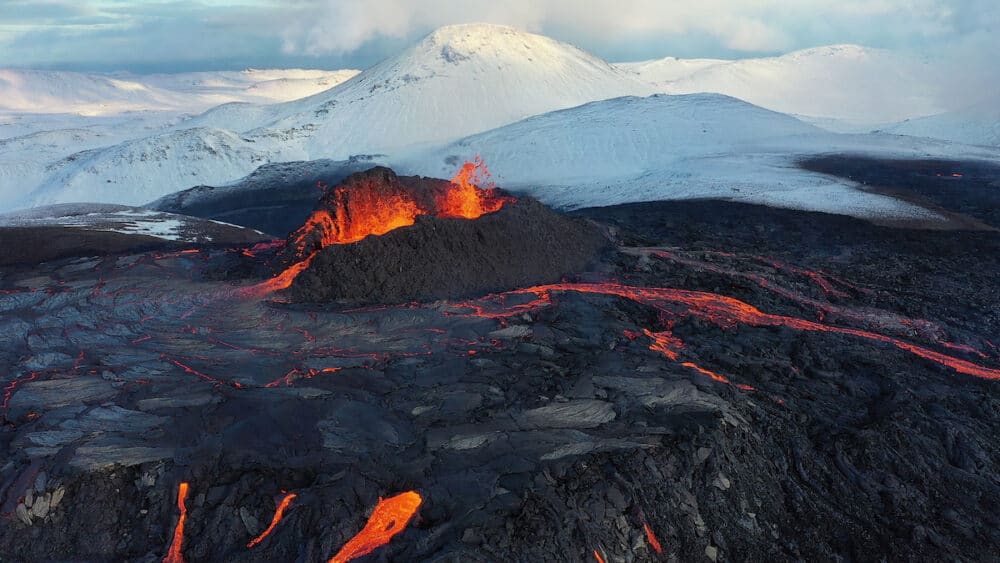
Volcano Tour- Litli Hrútur
- Best viewpoints
- Max of 19 people
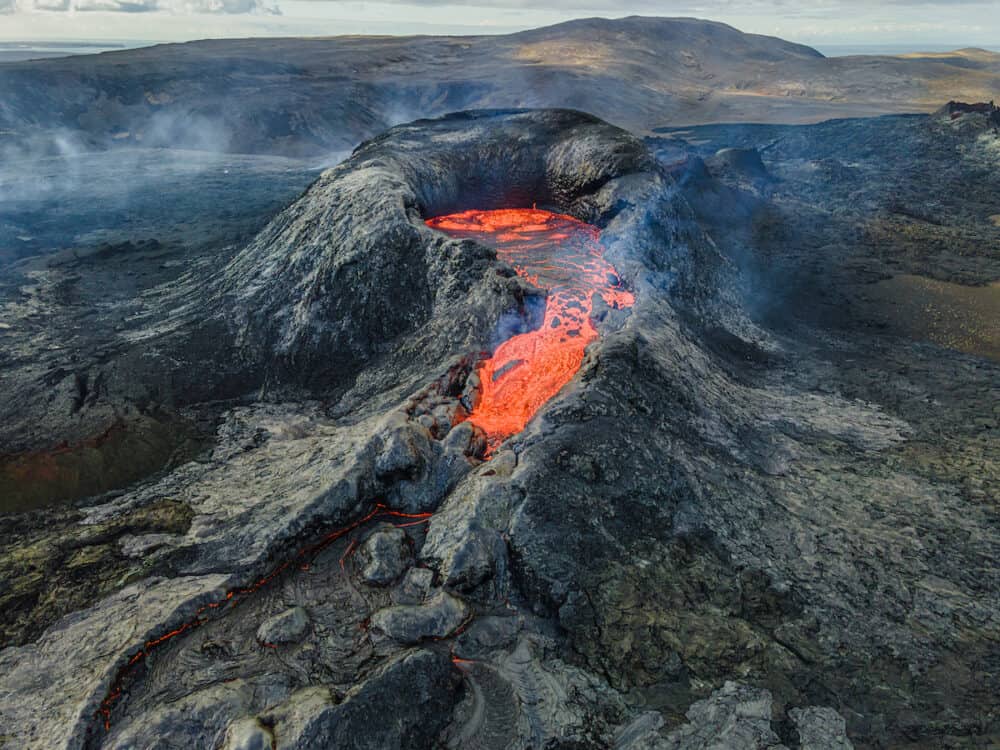
Volcanic Helicopter Tour
- 30 to 40 minutes
- Pass over Reykjavik
- Private Flight
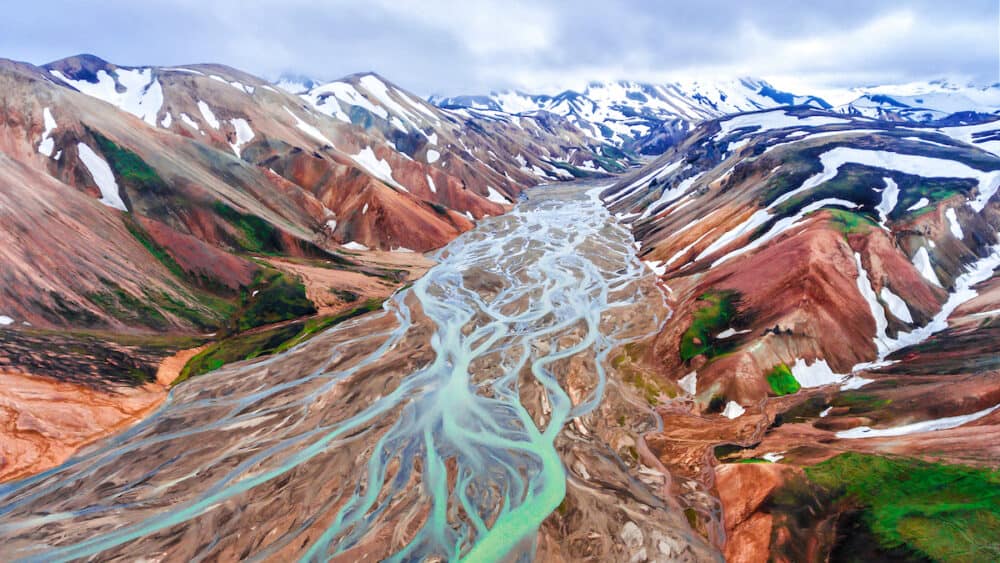
Landmannalaugar Hiking Tour
- Small Group
- Natural hot springs
8 of the Best Volcano Tours in Iceland
1. volcano tour- litli hrútur, reykjanes peninsula, icelandic snacks.
⭐️ RATING: 4/5 Stars | ⏳ LENGTH: 6-8 hours |📍 LOCATION: Fagradalsfjall | ✅ Book it!
The Fagradalsfjall Volcano began erupting in early 2021, and its fiery display continued for around six months. Despite the eruption ending, the sight of the fresh lava fields and newly formed craters shaped by volcanic activity remains a fantastic sight to behold. Suppose you are intrigued by this natural phenomenon.
In that case, an exciting tour departing from Reykjavik offers an excellent opportunity to explore these wonders up close. This tour takes you to the most advantageous viewpoints, allowing you to see the impressive Fagradalsfjall crater and the expanse of lava flows. However, this tour is not just limited to the volcanic sights.
In addition to seeing the volcano, the tour includes visits to nearby locations with geothermal activity. During the tour, you will have the chance to learn from your knowledgeable guide about the fascinating underground heat processes that shape Iceland’s unique landscape.
One of the places you will visit is Seltún, a location renowned for its bubbling mud pools and incredibly hot springs.
These natural wonders give you a firsthand glimpse into the powerful forces beneath the Earth’s surface. It is an experience that can help you appreciate the dynamic processes that have shaped Iceland’s environment over thousands of years.
Emily says: “Brilliant tour with absolutely stunning views! Johannes was our tour guide, and he was really friendly and informative. A few stops on the way, of which the scenery was beautiful. A good hike up to the volcano (I didn’t realise how much of a hike!) and you could see all the formed lava, still smoking! All in all, the views, tour and Johannes was amazing and would definitely recommend.”
This Volcano Tour Iceland begins with a hassle-free and efficient pick-up service. You will be conveniently picked up from a hotel in the centre of Reykjavik or from various other pick-up spots around the city. This eliminates the stress of finding transportation and ensures a smooth start to the adventure.
Throughout the tour, knowledgeable guides share their insights into the geological and geothermal features of the region. The tour takes you to the volcanic landscapes of the Reykjanes Peninsula. This region is situated along the Mid-Atlantic Rift, a significant geological boundary between tectonic plates.
The experience of witnessing this unique landscape, shaped by tectonic forces, offers a deeper understanding of the Earth’s dynamic processes. You will then get to see the aftermath of the Fagradalsfjall volcano eruption that occurred in 2021. This eruption was remarkable because it had been 800 years since any volcanic activity had been recorded in the area.
You can see the aftermath up close, observing the black, twisted lava still warm to the touch (please don’t actually touch it!). This provides a rare opportunity to witness the power of nature. One of the tour’s highlights is the opportunity to see a live volcanic eruption and molten magma at the Litli Hrutur Active Volcano.
The journey to the eruption site might be physically demanding, but the reward is insane. You get to experience sceneries of vast lava fields and ongoing volcanic activity. The tour also includes visiting the Seltún Geothermal Area, where you can witness bubbling mud pools and boiling hot springs.
You will also drive by Kleifarvatn Lake, the largest lake on the Reykjanes Peninsula. In summary, this tour offers a combination of educational experiences and sights, allowing you to witness the aftermath of a volcanic eruption, explore geothermal wonders and learn from expert guides.
Important details
- Start time and location: 8:30 am from one of the hotels in the center of Reykjavik or from one of the many pick up spots dotted across the city.
- Duration: approximately 6 to 8 hours
- Includes: Parking fees and fuel surcharge
🤩 Check Prices and Availability!
2. New Volcanic Eruption Area: Helicopter Tour in Iceland
⭐️ RATING: 4.5/5 Stars | ⏳ LENGTH: 30 to 40 min |📍 LOCATION: Fagradalsfjall | ✅ Book it!
When you find yourself in Reykjavik, prepare for an extraordinary experience by taking a helicopter ride over the Fagradalsfjall Volcano. This adventure promises an up-close encounter with some of the most vigorous and dramatic fissure openings Iceland offers.
As you embark on this 20-minute flight, the helicopter will lift you above the heart of the volcanic activity, granting you a bird’s eye view. Your journey will also include the insightful commentary provided by your expert guide.
They will share their knowledge about the geological forces and the region’s volcanic activity history. This educational element adds a layer of depth to your experience.
Not only will you witness the raw power of the volcano itself, but you will also have the privilege of admiring the cityscape of Reykjavik from an entirely new perspective.
With its distinctive architecture, the urban landscape takes on a different charm when viewed from the air. Lastly, you will fly over Faxafloi Bay, an expanse of aquamarine waters stretching out to the horizon.
The helicopter ride will carry you over this natural wonder, offering a unique vantage point to appreciate its beauty.
As you prepare for this unforgettable journey, ensure your cameras are ready. The sights you will encounter during this helicopter ride are the stuff of dreams and the makings of exceptional photographs.
Carmen says: “Flying next to the area where the volcano erupted was simply amazing! My granddaughter and I (9 yo & 75 yo) had an incredible experience. Everything worked well with ground operations team. Despite changing weather conditions and closure of air-space we managed to get on the air and enjoy the view! Thank you team!”
On this Fagradalsfjall Volcano tour, you can witness the Fagradalsfjall Volcano Eruptions of 2023, 2022 and 2021. You will soar over Iceland’s most sizzling fissure openings, where you can take in the striking panorama of the cone-shaped tuya, recent streams of molten lava and traces of cooled magma.
On your 20-minute-long helicopter flight, you can also fly over Reykjavik and Faxaflói Bay. It provides you with many insights into Iceland and its different types of landscapes. Do not miss the opportunity to capture some stunning Instagram-worthy shots of the aftermath of the August 2022 eruption.
- Start time and location: Book your time and head to Ace FBO Reykjavík
- Duration: approximately 30 – 40 minutes in total
- Includes: Fuel surcharge
3. Landmannalaugar Hiking Tour – Highlands of Iceland
⭐️ RATING: 4.5/5 Stars | ⏳ LENGTH: 5 Hours |📍 LOCATION: Landmannalaugar | ✅ Book it!
Join a full-day Landmannalaugar hiking excursion and Volcano tour from Reykjavik, where an accredited hiking expert will accompany you.
You will get to hike across rugged trails through the heart of the Fjallabak Nature Reserve, where you will admire sprawling lava fields, glacial lakes, and peaks that have formed high into the sky.
On your journey, you will go through the Vondugil Canyon, a striking passage that leads you further into the heart of the reserve before then ascending the slopes of the Brennisteinsalda Volcano. This iconic summit is where vigorous geysers send columns of scorching steam soaring into the air.
Next, you will explore the Grænagil Canyon as you descend towards the base of Mount Bláhnúkur. Here, the option to climb this ancient volcano is presented, provided that time and weather conditions permit.
Afterwards, you will enjoy a moment of well-deserved rejuvenation as you indulge in a soothing soak within the natural hot springs of Landmannalaugar. You will get to soothe your muscles after the memorable hike.
Darya says “We had an awesome hike in Landmannnalaugar! Our guide Biggi offered fantastic information throughout our drive down from Reykjavík, and guided us on a great and beautiful hike throughout the region. It takes about 4 hrs to get there, with 2 on the highway and the other 2 on a bumpy lava field, which had great views too! The soak in the hot springs at the end provided a great ending to the hike.”
Embark on a 4-hour hiking experience leading you through Landmannalaugar’s highland area and nature reserve. The landscape you will encounter is like an artist’s canvas brought to life, where vibrant colours blend and merge, creating a beautiful visual that you will not forget.
Landmannalaugar has long held its place as a magnet for adventurers and nature enthusiasts. Its reputation is well deserved for a world worth exploring within its borders. The terrain offers both challenge and reward, with each step leading to a new view.
You can enjoy a natural hot pool after your hike and adventure through the rugged terrain. The sensation of the warm water against your skin is both rejuvenating and relaxing, a perfect ending to your experience.
- Start time and location: Meet at 11:30 am in front of the Main Hut in Landmannalaugar Camping. Please note that you will require a 4×4 Jeep that is permitted to drive on F-roads to drive to Landmannalaugar. Alternatively, you can request a pick up from several locations.
- Duration: approximately 5 hours
- Includes: Small group guarantee, transport to and from Reykjavik and an expert hiking guide
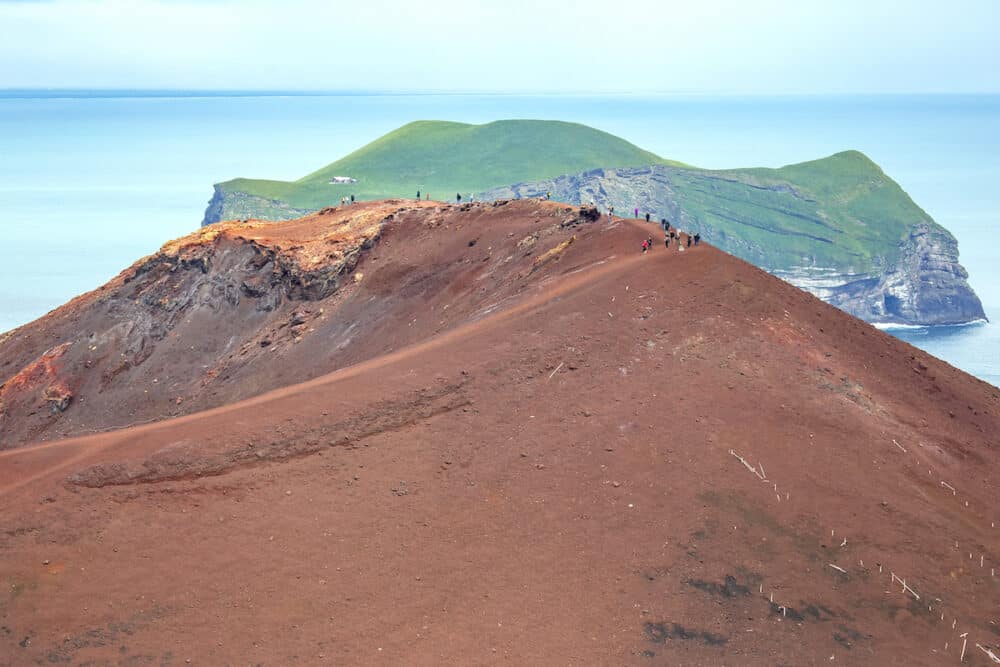
4. Volcano ATV Tour
⭐️ RATING: 5/5 Stars | ⏳ LENGTH: 1 Hour |📍 LOCATION: Heimaey Island | ✅ Book it!
This ATV tour is an exciting adventure where you explore the Eldfell Volcano and the scenic Heimaey Island coastline. Alongside a small group (14 participants max), you will also be accompanied by an experienced guide.
You will be taken on a comprehensive journey across the island, uncovering its hidden gems and unique features. Witness the beauty of Prestvik Beach and learn about the founding tale of these islands.
The ATVs that are used are comfortable, and each accommodates two riders. They are easy to drive and therefore offer an accessible driving experience that does not require advanced driving skills.
All drivers must have a valid driver’s license to take the wheel. This excursion is suitable for ages six and above, making it a family-friendly adventure.
Miroslav says “Awesome tour. Island is pretty small and this ride let us explore the most recent volcanic activity. Our guide Christof was great and shared funny stories. Recommend to all visitors as one of the most fun things to do in Heimaey”.
This ATV tour takes you to Prestvik Beach, where you will see the stranded fishing ship Pelagus. You will learn the story of its fate and how it stands as a testament to maritime history.
Additionally, you will explore the site where Guðlaugur Friðþórsson’s remarkable story unfolded after he had to swim 5-6 km through the dark and cold sea after the sinking of Hellisey VE 503.
The main event of the adventure is driving through the lava fields and delving into the heart of the Eldfell volcano, where you can drive right into the middle of it.
This tour is an ideal fit if you seek a blend of historical exploration and thrilling ATV riding. The automatic and user-friendly ATVs require no prior experience, making them accessible to all.
- Start time and location: Book your time slot and meet at Strandvegur 65. This is located 2-3 minute walk from the ferry Herjólfur.
- Duration: approximately 1 hour
- Includes: Overalls, gloves and helmet
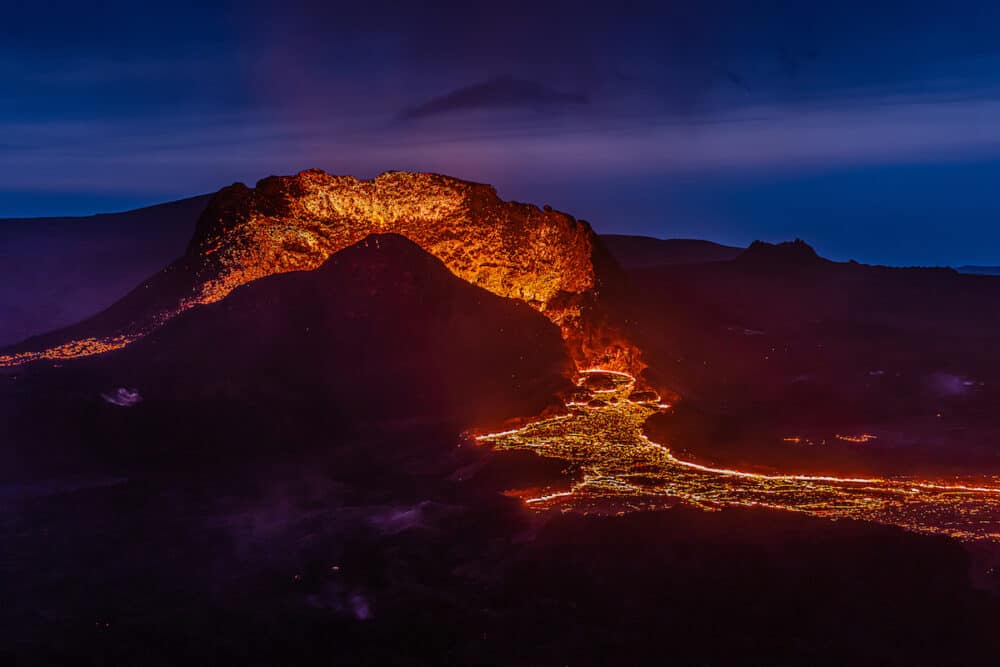
5. Litli Hrutur active Volcano
⭐️ RATING: 4.5/5 Stars | ⏳ LENGTH: 10 Hours |📍 LOCATION: Geldingadalur | ✅ Book it!
Experience the adventure of a lifetime on this Iceland Volcano trip and see an active volcanic eruption and flowing molten lava! Your expert guide will greet you in Reykjavik before you leave for the trip.
The trek to the Litli Hrutur Active Volcano is challenging due to its considerable distance of up to 9 kilometres each way. So ensure you are physically fit enough to endure this hike and enjoy it. However, the rewards are tremendous.
Once you reach the volcano’s summit, you can witness expansive lava fields and a continuously erupting volcano. Upon reaching the volcano’s location, you will see the lava fields, where you can observe fresh lava coming out of the Earth and cascading everywhere.
While spending time at this natural wonder, your guide will take you to a safe spot to sample some Icelandic chocolate called Hraun, which translates to “lava.”
It’s advisable to bring ample snacks and water for the trip to ensure your comfort. It is also mandatory to wear sturdy hiking boots. These are available for rental if you do not have any.
A Trip Advisor reviewer says “Quite possibly the highlight of my trip. 11+ miles round trip to see it erupting. We parked at Parking 2 but this may change. Great views. The hike had a lot of flat spots but one particular incline was a bit tough because it was dry. Definitely take hiking poles if you have them for this part of the hike. The view from the very top is well worth it! We could see the volcano erupting – when we first got there it was good, but we spent about ½ hour or more there and it increasingly got higher. You couldn’t hear anything but you could smell it. A lot of people on the hike but because the hike is so long they are spread out. This was amazing to experience.”
Prepare for a truly once-in-a-lifetime encounter as you step into the extraordinary realm of Geldingadalur. It’s home to the magnificent Litli Hrutur Active Volcano. In the middle of untouched natural beauty, you will have the privilege of witnessing a real-time volcanic eruption that will leave you with incredible memories.
As you stand on the threshold of the volcano, you will be greeted by the sight of red magma and flowing lava. You might even be able to feel the Earth beneath your feet hum with the energy of the molten lava as it makes its way down the slopes.
On this tour, you will be accompanied by a guide who will be well-versed in the stories behind the volcanic landscapes. Therefore, you will not only witness the eruptions but also delve into the science behind the eruptions
- Start time and location: Pick up will be at 9:00 am and will be from either hotels or bus stops
- Duration: approximately 10 hours
- Includes: There is WiFi on board, snacks and a first-aid kit is available
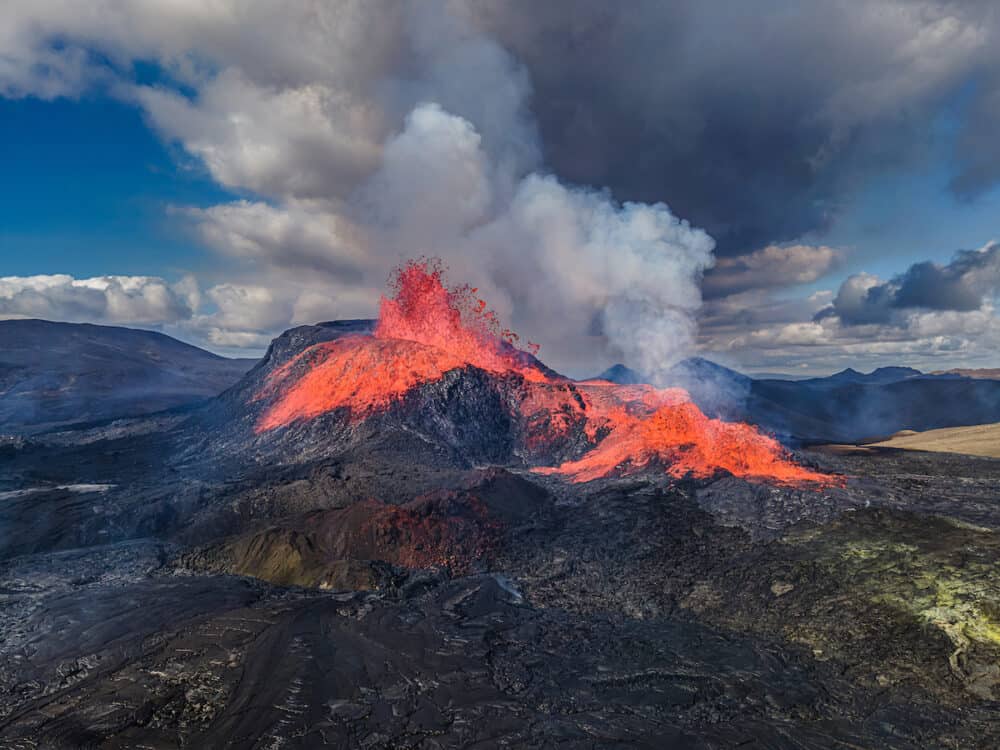
6. Small Group Volcano Hike with a Geologist
⭐️ RATING: 4.5/5 Stars | ⏳ LENGTH: 6 Hours |📍 LOCATION: Fagradalsfjall | ✅ Book it!
Embark on this fun adventure to Iceland’s freshest volcano with this small group tour (max 6) from Reykjavik. Accompanied by an experienced geologist and volcanologist guide, you will explore the fascinating story of the 2021 eruption at Fagradalsfjall.
Walk across the lava-strewn landscape and observe the forming of new terrain from the lava flows. You will gain insights into how the lava’s composition moulds the characteristics of the rocks it forms.
During the group hike, you will ascend to the vantage point of the crater, where you will see breathtaking views of the sprawling lava.
This unique Iceland volcano tour – Fagradalsfjall presents the chance to stand at the foot of Iceland’s most recent volcano while learning comprehensive knowledge about the eruption from your knowledgeable geologist guide.
With the group size limited to a maximum of six participants, you will receive a truly personalised trip.
Benjamin says “Aside from being a highly educated geologist, Jasmin was extremely friendly and personable. The tour was absolutely breathtaking, and very educational about the volcanic history of Iceland and recent events. We highly recommend this tour to anyone, as well as any other tours Jasmin offers.”
On this trip, you will learn about Fagradalsfjall Volcano’s eruptions across multiple years, including 2023, 2022 and 2021. The journey to the eruption site on the Reykjanes peninsula goes through ancient lava fields, offering an initial glimpse into the creation of Iceland and the gradual shaping of the local terrain.
The hike commences with an overview of the volcanic history within the Reyjanes peninsula and the initial indications of renewed activity at this site. Within the lava field, you will then admire the creation and composition of the different lava rock formations before you hike to the volcano vantage point.
You will then get to admire the views of the extensive lava fields in front of you and get an idea of how expansive they are. The return journey to Reykjavik does not mean the tour is over, as you travel through landscapes flanked by hot springs, lakes and mountains.
Please note that the eruption’s activity can swiftly change, so the visibility of the molten lava’s radiant glow cannot be guaranteed. Please ensure you have approximately 2 to 3 hours to enjoy this experience.
- Start time and location: The tour starts at 10:00 am with a pick up in Reykjavik at Bus stop 8 (Hallgrimskirkja).
- Duration: approximately 6 hours
- Includes: Air-conditioned vehicle and parking fees. Crampons and headlamps are available if needed.
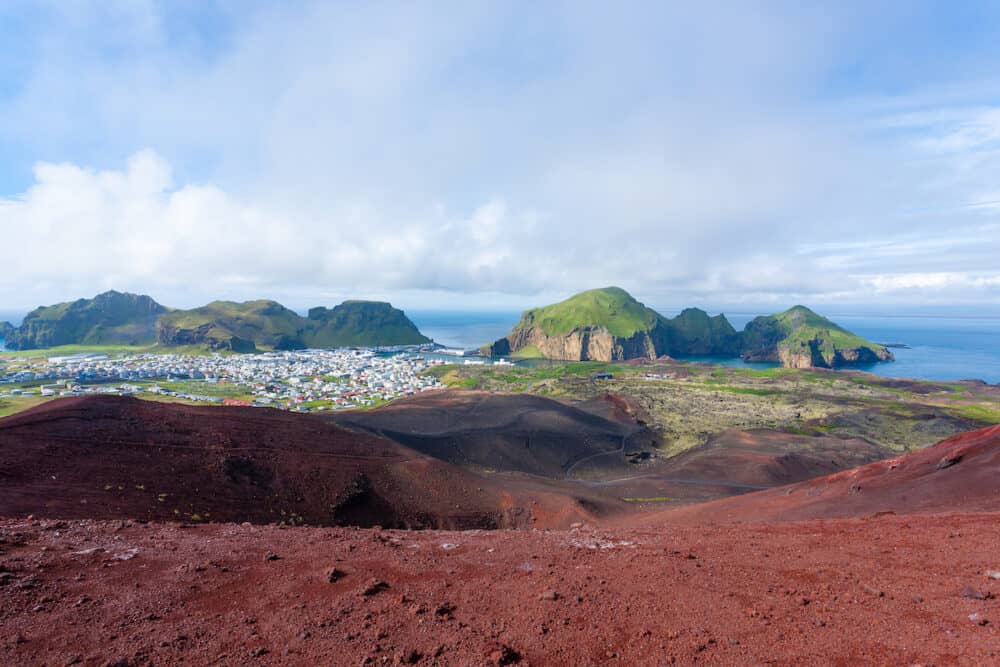
7. Puffin and Volcano Tour in Vestmannaeyjar
⭐️ RATING: 5/5 Stars | ⏳ LENGTH: 1.5 – 2 Hours |📍 LOCATION: Vestmannaeyjar | ✅ Book it!
This guided tour takes you on a fun journey through Iceland’s Westman Islands, where you will learn about its rich history, vibrant culture and charming wildlife. Your first stop is the picturesque Herjólfsdalur and Kaplagjóta, where a lovely and peaceful puffin colony will greet you.
Next up, explore the surrounding landscape by heading into the heart of the Eldfell crater, a site once transformed by the volcanic eruption. Continuing the wildlife encounter, witness another delightful puffin gathering at Stórhöfði.
The tour does not stop there; you also enter the exclusive Herjólfstown, the original Viking settlement. Here, you will gain access to learn about the island’s early inhabitants and their fascinating way of life.
Other elements of the Icelandic Volcano tour include going to Elephant Rock, where you can capture photos and watch your knowledgeable guide demonstrate the art of Sprangan, a traditional rope swinging technique.
Maryellen says “One of the best tours we have ever taken. The local operator is EYJA Tours. Be sure that they are running your trip. The gentleman who was our driver guide, I think his name was EMMY, is so authentic and so knowledgeable, and so devoted to his island. We had seven or eight different stops in our two hours, and he really could tell us about each place and he’s personally devoted a couple of years to restoring some of the sites you will see. Highly highly recommend this tour.”
You will make unforgettable memories on this tour as you explore the destinations of Herjólfsdalur and Kaplagjóta. These picturesque locations, known for their natural beauty, also host a small puffin colony.
Next up, your adventure takes you to the heart of Eldfell, the volcanic crater that serves as a powerful reminder of the island’s fiery past.
Spend time amidst the rugged terrain, where you will stand on the very ground where the eruption once began. As you journey, you will reach Stórhöfði, a cape renowned as Europe’s windiest spot. This wild and untamed landscape is home to the largest puffin colony in all of Iceland.
Find yourself surrounded by this natural wonder’s beauty and witness these beautiful creatures’ lively interactions. One of the tour’s highlights awaits you in Herjólfstown, where you will get to step back in time to the days of the first Viking settlers.
Gain exclusive access to this historic site, where you will learn about the history of the island’s earliest inhabitants. This privilege is only available through Eyjatours, making your experience even more special.
As you continue, your guide will showcase a local sport, Sprangan, adding cultural insight to your journey. Watch as your guide skill-fully demonstrates this traditional rope activity. On tour, you will also catch sight of the famous Elephant Rock, a natural formation that has captured the imagination of many.
- Start time and location: Book your time slot and then you need to take a ferry to get to Vestmannaeyjar. Then head to Eyjatours – Puffin Tours in Iceland.
- Duration: approximately 2 hours
- Includes: Admission to Herjólfstown, the first Viking family that settled in Vestmannaeyjar. Plus a local guide and an air conditioned vehicle.
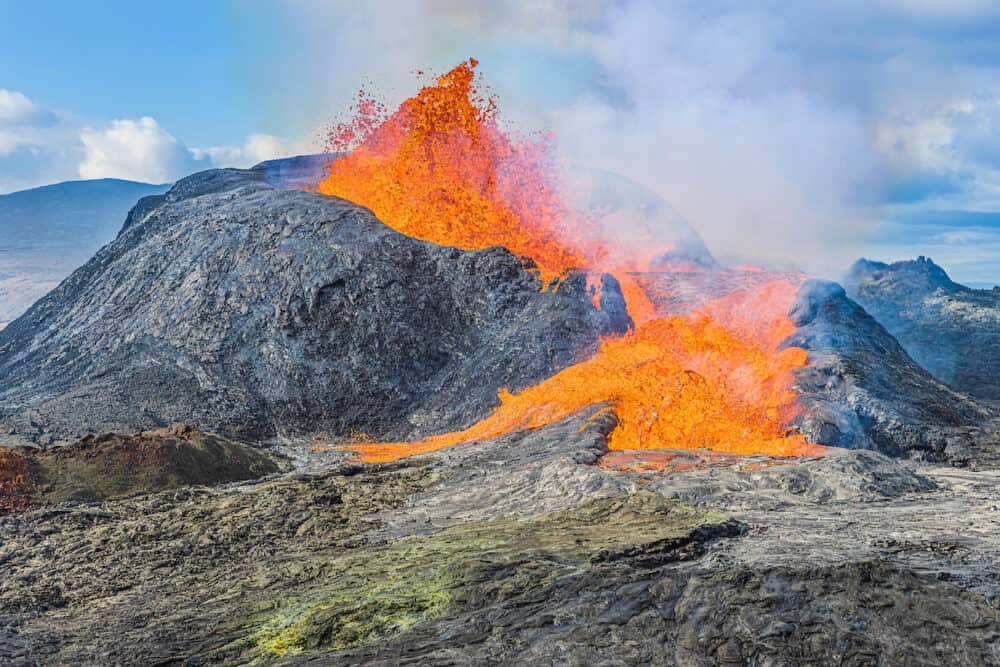
8. 7-Hours Hiking Tour in Geldingadalir Volcanoes in Reykjanes
⏳ LENGTH: 7 Hours |📍 LOCATION: Geldingadalir | ✅ Book it!
On this Geldingadalir Volcano tour, you will get to experience volcanic activity’s influence on Iceland’s landscape. You will create memories on this unforgettable journey through the Reykjanes Peninsula, a short drive from Reykjavík.
Positioned along the mid-Atlantic ridge’s fissure line, this peninsula has been shaped by eruptions, earthquakes and seismic activity for centuries.
The focal point of this tour is undoubtedly the exploration of the Fagradalsfjall and Meradlir volcanoes within the Geldingadalir Valley, where recent eruptions have occurred.
You will get to witness Iceland’s most recently active volcano up close. This remarkable opportunity has only presented itself due to the scarcity of easily accessible and safe-to-visit active volcanoes in the country’s recent history.
This tour a new tour on Viator and is Idea for groups of up to 7 People
The first activity on the tour includes taking a stroll between the American and Eurasian continental plates at the Bridge Between Continents before heading over to discover the mysteries of Kleifarvatn Lake, the third largest and one of the deepest lakes in the South of Iceland.
The southern part of the lake is subject to geothermal heat, rumored to be the dwelling place of a worm-like monster. Next up on this tour, you will pass the Seltún Geothermal Area, filled with mud pots and fumaroles.
The vibrant hues stem from mineral deposits left by geothermal solutions, creating beautiful colours. Afterwards, you will drive over to the Reykjanes Peninsula, where you will explore the mid-Atlantic ridge’s fissure line.
Witness the incredible history of the region’s most recently active volcano, Fagradalsfjall, which has erupted in recent years, including 2023, 2022 and 2021. You will also encounter the fascinating Gunnuhver Hot Springs, where steam from geothermal reservoirs combines with surface water.
This gives birth to mud pools and accompanying gases like carbon dioxide and hydrogen sulphide. The last part of the tour showcases the history of the Reykjanes Lighthouse.
The first lighthouse stood on Valahnúkur in 1878, yet earthquakes and powerful waves destroyed it. Since then, a new lighthouse has been built on Bæjarfell Hill, serving as a testament to resilience and change in the area.
- Start time and location: 10 am pick up time most hotels in Reykjavik .
- Duration: approximately 7 hours
- Includes: Snacks, lunch and free Wifi
🤩 Check Prices and Availability
FAQs About visiting volcanoes in iceland
What is the best time of year to visit a volcano in iceland.
The best time of year to visit a volcano in Iceland is usually during the summer months, from June through August. During this period, the weather is warmer and more stable than other times of the year, making volcano visits easier and more comfortable.
How do I get to an Icelandic volcano?
The easiest way to get to an Icelandic volcano is by car or bus. Many tour companies offer trips that will take you right up to the edge of a volcano.
If you don’t have your own vehicle or don’t want to join a tour group, there are also public transportation options available. Buses and taxis can take you directly from Reykjavik to many major volcanoes in Iceland.
Are there any safety regulations when visiting an Icelandic volcano?
Yes, it’s important to follow all safety regulations when visiting an Icelandic volcano. Visitors should stay on marked paths and trails at all times, as off-trail exploring can be dangerous due to unstable ground and hazardous gases emitted from the volcano.
Additionally, visitors should keep a safe distance from lava flows and volcanic craters for their own safety.
where to see lava in iceland 2024
Iceland is a land of geothermal power and active volcanoes. In 2024, you can visit some of the most remarkable volcanoes in the world. Reykjanes Peninsula, located near the capital of Reykjavik, is home to several active volcanoes.
You can visit two hiking trails on the Peninsula—Krýsuvík and Seltún—which will provide you with amazing views of the mountains and bubbling lava fields.
Mýrdalsjökull glacier in the southern part of Iceland also has an active volcano underneath it—Katla Volcano—a must-see for adventurous travelers. For those looking to take things a step further, there are helicopter tours available that will take you right above these volcanoes!
do you need a tour to see the volcano in iceland?
Yes, a tour is necessary to see the volcano in Iceland. Hiring a licensed tour guide or joining an organized tour is the best way to safely view the sights and learn more about the volcano.
Tour guides are knowledgeable and can provide insight into the geological environment around you as well as offering helpful safety tips when exploring up close.
With their help, you can get an unforgettable experience of this incredible natural wonder.
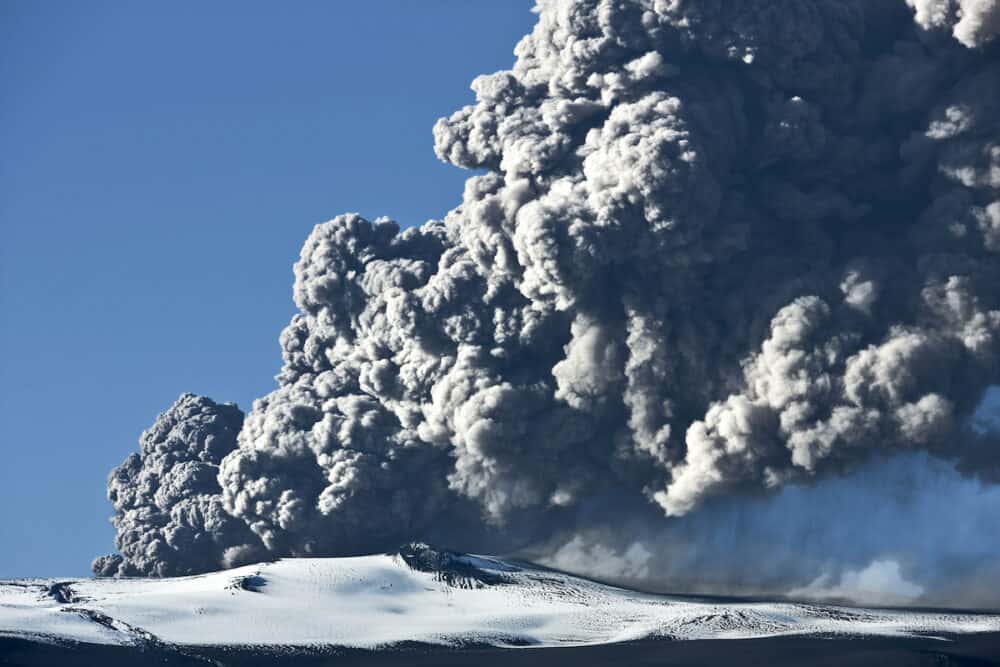
Final Thoughts: volcano tours iceland
You’ll discover the incredible power of nature as you make your way to the volcanoes of Iceland. With these amazing day tours, you will be able to explore a landscape that is both unique and mesmerizing.
Along with stunning landscapes, you will also witness incredible eruptions from active geysers and hot springs. These experiences are nothing short of spectacular!
The beauty of Iceland’s volcanoes is something that should not be missed. So don’t wait – book one of these great tours today and explore the wonder and power of these majestic places for yourself! Don’t forget to take plenty of pictures, because these memories will last a lifetime.
Read More about Iceland:
- Iceland ring road accommodation
- Top 10 Budget Friendly Hotels in Iceland
- 15 Remarkable Things to see and Do in Iceland
- 48 Hours in Iceland – A 2 Day Itinerary
- 10 Day Itinerary for Iceland
- The Best Day Trips from Reykjavik
- 7 of the Best Golden Circle Tours in Iceland
- 9 of the Best Iceland Glacier Tours
- 9 of the Best Iceland South Coast Tours
Budget Guide to Iceland
Luxury travel guide to iceland.
- Guide to Visiting Iceland
- Is a Tour to Iceland’s South Coast worth it?

Sam, a seasoned traveler across four continents and 49 countries, is a leading authority in travel planning. Her website, Travelling King, offers tailored itineraries and expert guides for seamless trips. Sam's expertise in luxury travel, fast travel, and destination guides keeps her at the forefront of the travel community.
Similar Posts
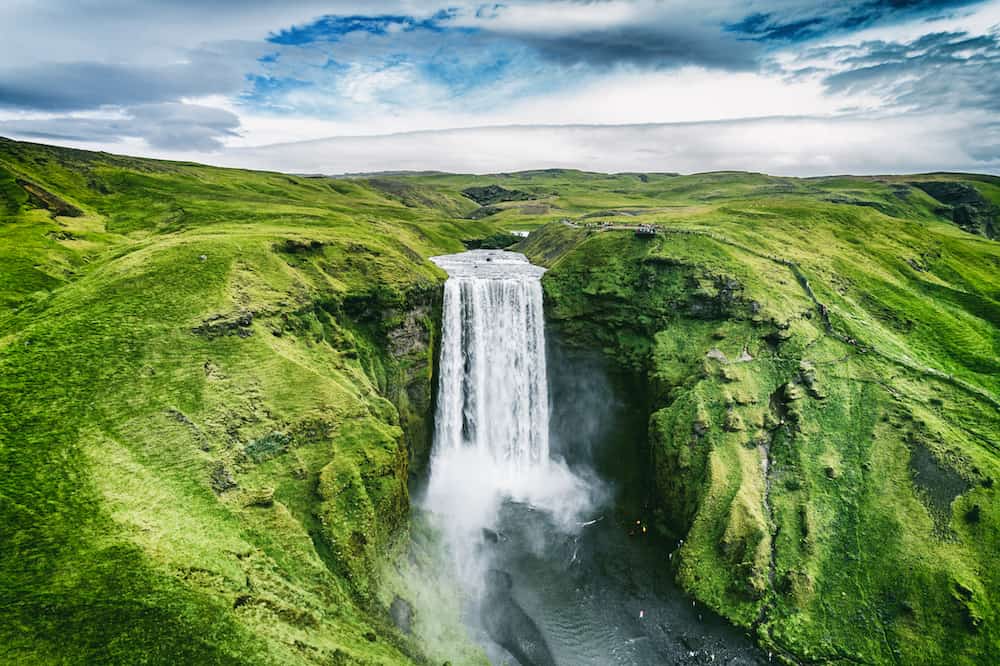
48 Hours in Iceland – A 2 Day Itinerary
I have been going to Iceland for years and it is hands down my favorite place to visit. I’m…
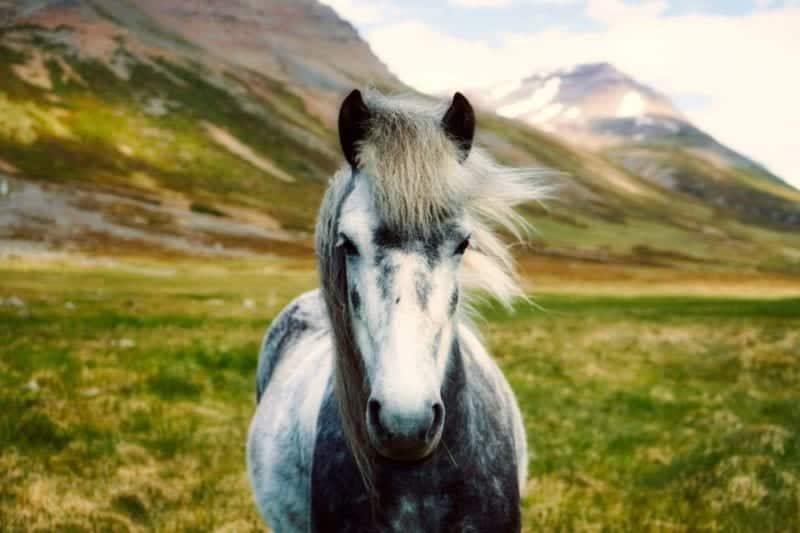
How to Travel in a Campervan across Iceland
Not only is Iceland one of the most visually stunning countries that you are likely to visit, but some…
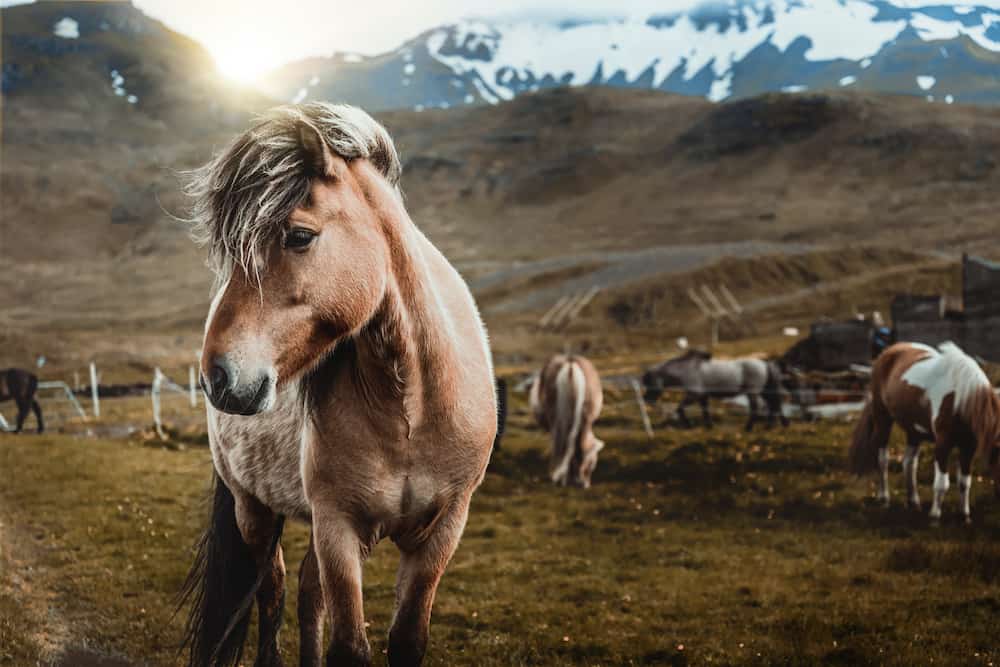
Iceland will capture your heart with its breath-taking natural beauty. Situated just below the Arctic Circle, it is the…
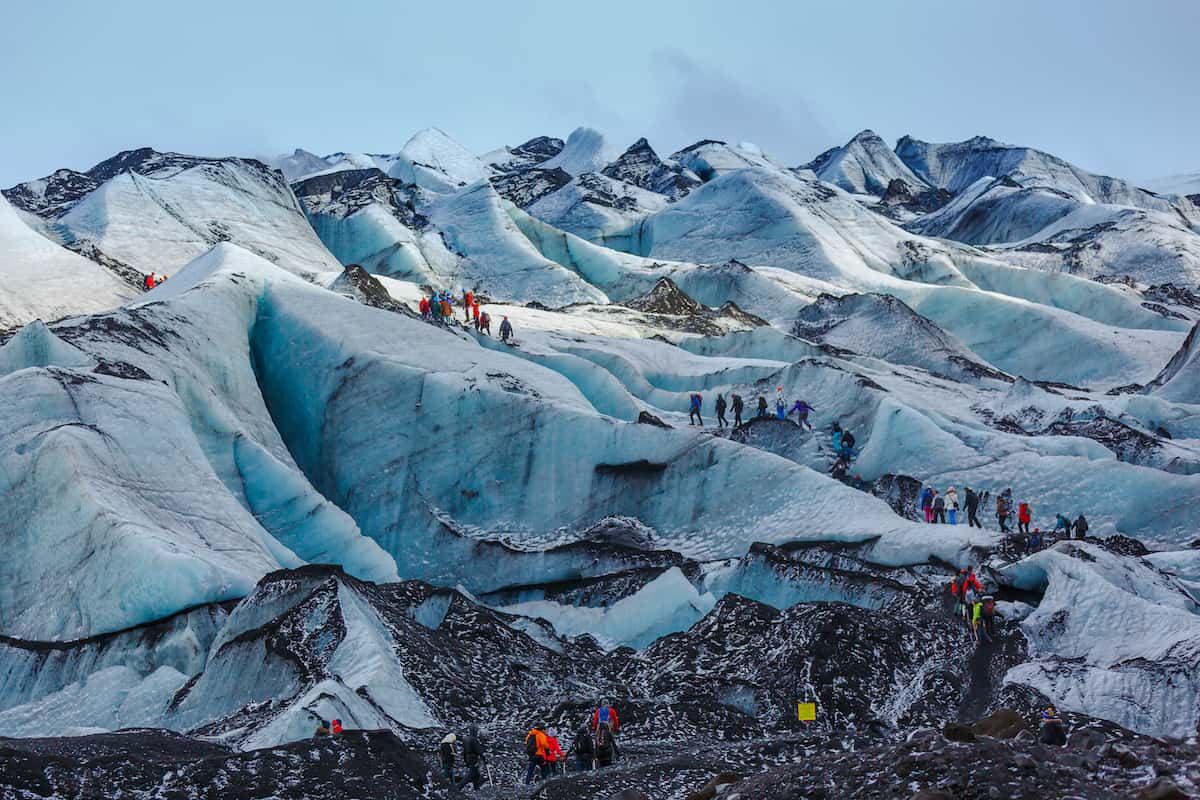
9 of the Best Iceland Glacier Tours 2024
Have you been wondering the Best Iceland Glacier Tours? I’ve got you covered! I’ve lived in Europe for the…
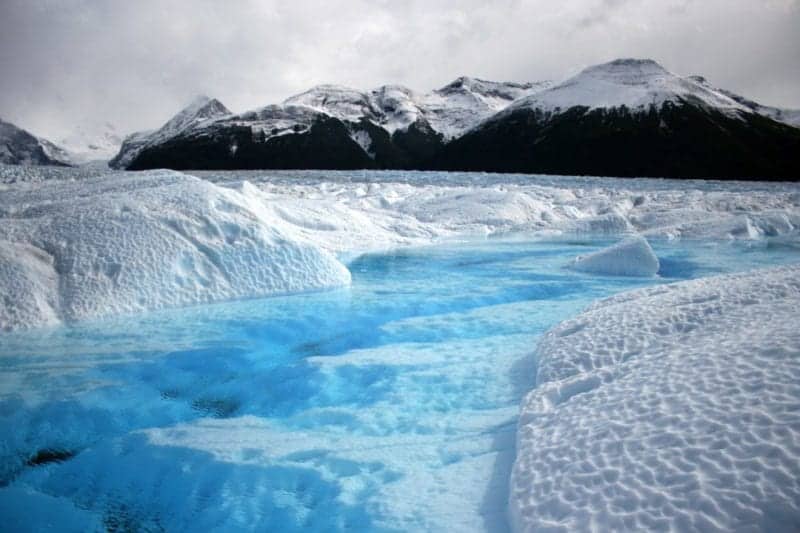
Plan A Cool Trip To Iceland With These Essential Dos and Don’ts
Iceland is a beautiful and mysterious country. It has a very low population density, which means there are only…
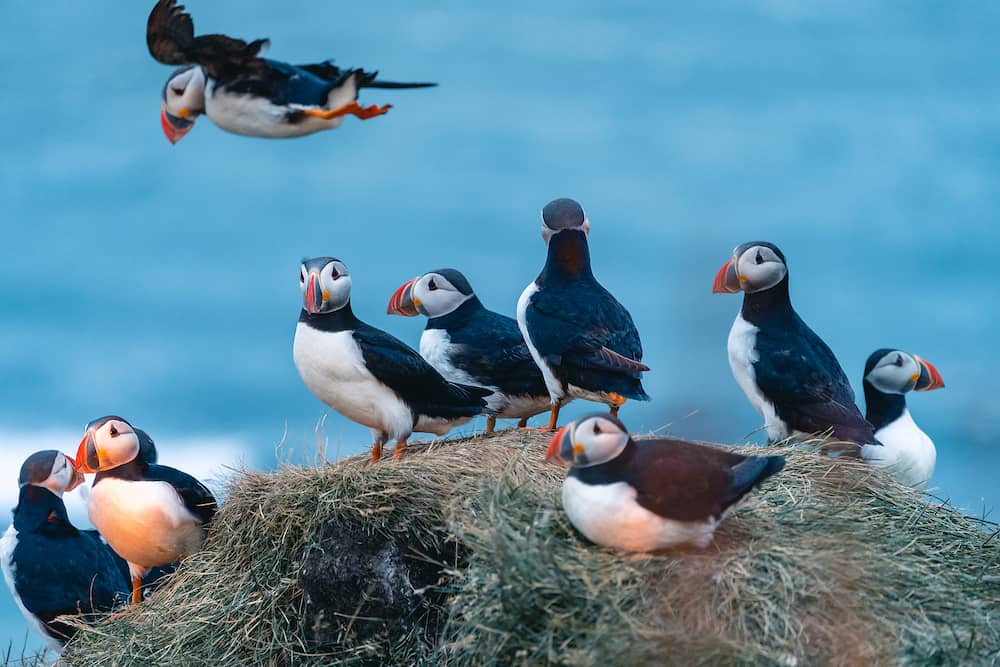
Iceland, a country known for its dramatic landscapes, volcanoes, erupting geysers, lava fields, and soothing hot springs, is located…
- All Tours & Activities
- Northern Lights Tours
- Golden Circle Tours
- South Coast Tours
- Blue Lagoon Tours
- Sky Lagoon Tours
- Hvammsvík Hot Spring Tours
- Hot Springs & Pools
- Volcano Tours
- Adventure Tours
- Reykjavik City Tours
- Super Jeep Tours
- Special Offers
- Private Tours
- Meet on Location
- Highland Bus
Your Cart is empty
Looks like you haven’t picked any tours yet!
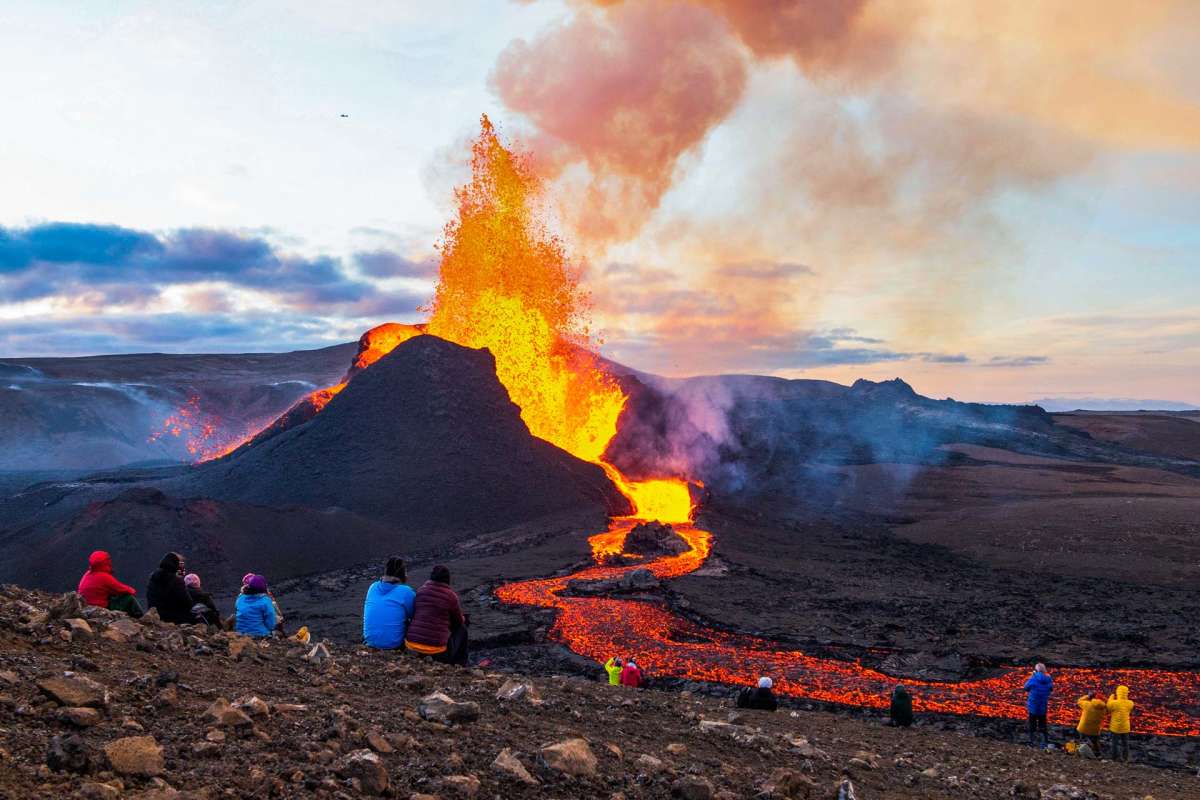
Best Volcano Tours and Experiences in Iceland - Your Guide
As one of the most volcanically active countries in the world, there’s no better place to take a volcano tour than iceland. discover some of the best.
July 12, 2023
Iceland is celebrated as one of the most volcanically vibrant nations on the globe. Boasting 30 active volcanic systems and a chronicle of colossal eruptions, there are few places better to experience the breathtaking force of the Earth's innate energy.
In the past three years, the Reykjanes peninsula, just a stone's throw from the capital, has become a particular hotbed of activity. This region has witnessed three volcanic eruptions within this short timeframe, a demonstration of nature's raw power that is both awe-inspiring and scientifically significant.
Yet, this type of volcano does not pose a threat to human life or travel. In a somewhat paradoxical twist, it has earned a reputation as one of the most tourist-friendly volcanoes in the world, providing an unparalleled experience of geothermal phenomena for adventure seekers.
By embarking on volcano tour in Iceland , you can witness these astounding phenomena first-hand. With expertly guided tours, you have the opportunity to approach some of the world's most potent and active volcanic systems.
Rest assured, the tours are conducted with the utmost safety in mind. Experienced guides, who are trained to scrutinize and adapt to ever-fluctuating conditions, will educate you about the wonders of Iceland’s volcanoes while ensuring your safety.
Continue reading to explore some of Iceland's most renowned volcanoes, and learn how you can sign up for a tour to experience them personally.
Volcanoes in Iceland: 6 you need to see
Located on a tectonic plate boundary and in the middle of a volcanic hotspot, it’s no surprise that Iceland is an incredibly active volcanic area.
In fact, the very land that is Iceland was produced by volcanoes only extremely recently. That’s why, alongside being one of the most volcanic areas, Iceland is also known as the youngest country in the world.
Out of Iceland’s 30 active volcanic systems, 18 have erupted since the tenth century, when the country was first settled.
The most recent eruption has been that of Reykjanes, which treated us with a series of gentle eruptions since 2021. The eruptions were named Fagradalsfjall, Geldingadalir and Litli-Hrútur, named atfer the locations where the fresh lava occurred.
But the most famous in recent years has no doubt been Eyjafjallajökull, whose eruption in 2010 brought international air travel to a halt.
Discover six of the most famous volcanoes in Iceland that you can visit on a volcano tour.
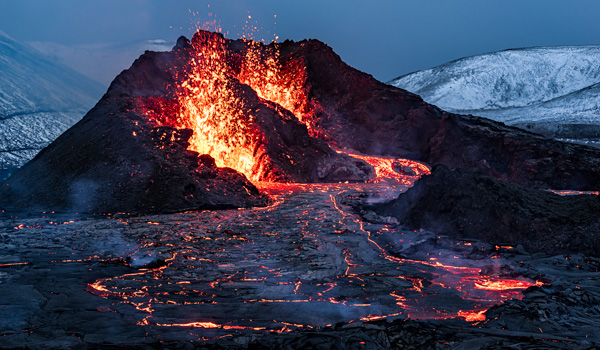
1. Fagradalsfjall
Of all of Iceland’s volcanoes, Fagradalsfjall is the one that erupted most recently. It erupted three times within three years and is predicted to procudes more eruptions during the next years or even decades.
The Mount Fagradalfsjall volcano is only a short distance (55 kilometres, or 34 miles) from Reykjavik, making it the perfect destination for a volcano tour.
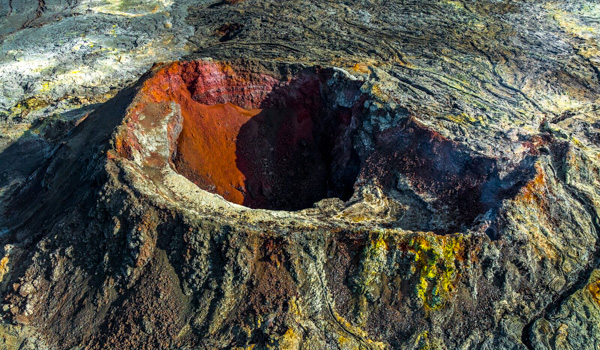
You’ll find Fagradalfsjall on the Reykjanes peninsula , which translates as something like the “smoking peninsula”, so-called because of its geothermal activity. Recognised as a UNESCO site, the Reykjanes Geopark is full of lava formations, volcanic black-sand plains, and other geothermal landforms.
It’s an incredible place to see the power of volcanoes.
2. Eyjafjallajökull
Do you remember back in the summer of 2010, when flights were disrupted across the world? That was because of Eyjafjallajökull, the mischievous Icelandic volcano with the unpronounceable name.
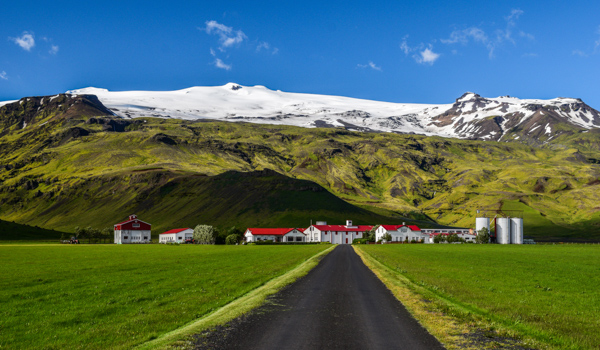
While the volcano has since stopped erupting, you can still visit Eyjafjallajökull today. Located in the heart of the south coast of Iceland, the volcano itself is buried beneath the ice cap of the same name. But that doesn’t prevent it from being a stunning sight, as the volcano towers over the surrounding area.
Back in 2010, it was precisely the fact that Eyjafjallajökull was erupting beneath a glacier that posed such a risk. Glacial flows, caused when lava melts ice, have been very dangerous in previous Icelandic eruptions. Luckily, no one was harmed in 2010 and today it is perfectly safe to visit. You’ll find a visitor centre in the nearby village of Hvolsvöllur.
- Find out more in our guide to Eyjafjallajökull
Enter a volcano
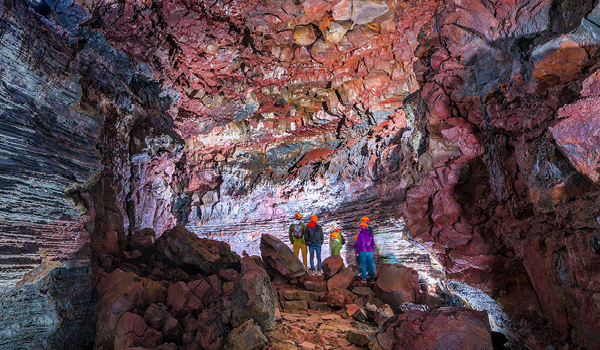
Take a trip along Iceland’s south coast and you’ll see volcanoes, both active and dormant, along the way. However, there’s only one place where you can go inside a volcano —and that’s at the Lava Tunnel.
The Lava Tunnel is one of the Reykjavik area’s best kept secrets, less than half an hour from the city centre. Here you’ll walk in the path of lava that flowed thousands of years ago, carving out a space underground that’s 30 metres wide and 10 metres high. Go as far as 350 metres underground, to see captivating rock formations and strange plays of light.
One of the largest volcanoes in Iceland, Katla is truly a fearsome thing. It’s exceptionally active, having erupted 20 times between the tenth century and 1918. Each time, Katla had huge impacts on Icelandic life and land, even extending the south coast by as much as five kilometres.
Given that Katla usually erupts every 20 to 90 years or so, we’re overdue for an eruption. What’s more, every time that Eyjafjallajökull has erupted in history, Katla hasn’t waited long to kick into action. Over the last decade, tremors have been repeatedly felt in the surrounding area.
Like Eyjafjallajökull, the Katla volcano is hidden beneath a glacier, Mýrdalsjökull. That said, you can see its powerful shape from the south coast or from a trip into the Icelandic highlands.

4. Fimmvörðuháls
Before 2010, Fimmvörðuháls was simply known as one of the most magnificent hiking routes in Iceland . The so-called “five cairns pass” separated the two glacier-covered volcanoes, Eyjafjallajökull and Katla, providing a spectacular itinerary for anyone who fancied the challenge.
But then, in 2010, just before Eyjafjallajökull’s enormous eruption, Fimmvörðuháls had its own volcanic event. On the mountain pass, a fissure opened up, pouring out lava towards the nature reserve of Þórsmörk.
The following month, Eyjafjallajökull erupted, and the rest is history. But Fimmvörðuháls has been changed ever since.
If you want an active adventure that reveals the creative destruction of Iceland’s volcanoes, this could be the experience for you. What’s more, you’ll see waterfalls, glaciers, and breathtaking mountain views along the way.
For centuries, Mount Hekla, one of Iceland’s most active volcanoes, was known as the “gateway to hell”. Stories told of its fiery cauldron of lava, where witches were thought to gather.
Now, it’s safe to say that Hekla isn’t the entrance to the underworld (that would be Snæfellsjökull on the Snæfellsnes peninsula , according to other theories). But it’s a pretty awe-inspiring thing nonetheless. 10% of all the volcanic material in Iceland is estimated to have originated from Hekla, perhaps the largest volume of lava of any volcano in the world.
Like other volcanoes in Iceland, you can see Hekla in tours of the south coast of Iceland. It’s weather-permitting, though. The name “Hekla” comes from the word for a hooded cloak, a likely reference to its frequent covering in mysterious clouds.
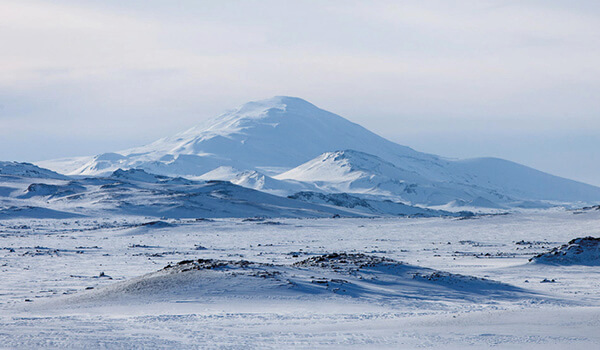
6. Grímsvötn
In the heart of the Vatnajökull National Park, you’ll find Grímsvötn, Iceland’s most frequently erupting volcano. However, it’s also probably the most inaccessible volcano in Iceland, as it is completely covered by the Vatnajökull glacier, one of the biggest in Europe.
While it is far away from any settlement, Grímsvötn has been known to affect the life of Icelanders. For example, during an eruption in 1996, part of the glacier melted, flooding Iceland’s Ring Road and washing part of it away. Luckily, no one was hurt, thanks to continued monitoring of the volcano.
Volcanoes in Iceland
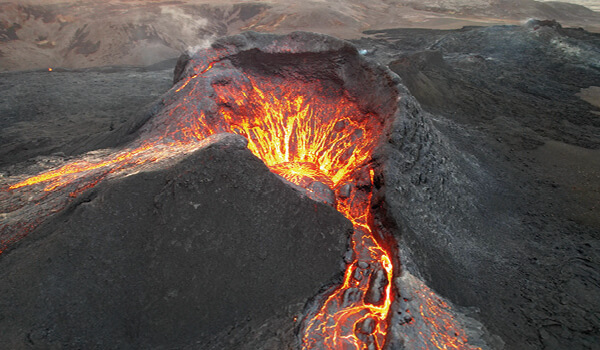
Volcanoes are one of the most awesome things you can see on planet Earth. With their power to destroy, disrupt, and create things anew, they have a huge impact on our lives. It’s no wonder that getting up close to a volcano has become a top item on many people’s bucket lists.
Iceland is the best place in the world to do it. With 30 active volcanoes and one hundred more dormant or extinct ones, there’s a huge variety to experience. What’s more, some are only a short distance from the capital city, making them incredibly easy to visit. Find out more in our guide to volcanoes in Iceland.
How to dress for a volcano tour
When visiting a volcano, it’s important to come prepared. Volcanoes are rugged, mountainous locations that defy human intervention. If you’re joining a volcano tour, come with clothes that are robust and comfortable to walk in.
Firstly, that means that trainers or sneakers are not a good idea. These can be torn on the sharp rocks that you’ll find in these volcanic areas. Instead, sturdy walking shoes, preferably with ankle support, are recommended.
As this is Iceland, we’d also suggest that you come prepared for the cold and any possible rain or snow. Warm layers are a good idea, along with a waterproof jacket. Some spare layers can be wise too.
- Find out more in our packlist for Iceland
LAVA Centre: Iceland’s best volcano exhibition
Want to learn more about the fascinating science of volcanoes? Head to the LAVA Centre , an interactive, high-tech educational exhibition depicting volcanic activity, earthquakes and the creation of Iceland over millions of years. It is the most awarded exhibition in Iceland both when it comes to design and technology.
Nestled on Iceland's South Coast near Hvolsöllur, the center stands as an essential destination for those captivated by the country's stunning geological marvels.
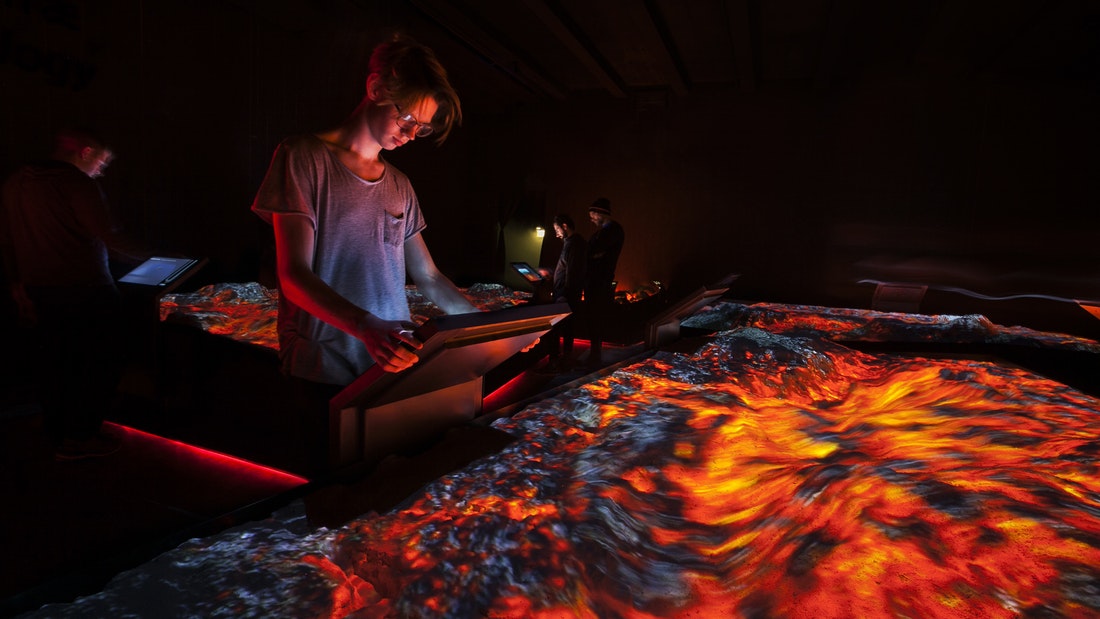
The unique Lava Show
The unparalleled Lava Show is a riveting fusion of education and thrill, where visitors witness genuine lava in action. The show recreates a volcanic eruption by superheating real lava up to 1100°C (2000°F) and then pouring it into a showroom full of people.
As the lava meanders over ice, it bubbles and crackles, painting a dramatic contrast. This is more than just a show; it's an unmatched sensory experience that will linger in your memories.
Frequently asked questions about volcano tours in Iceland
Still have questions about Iceland’s volcano tours? Here we offer some answers.
What is the best active volcano to visit?
The best active volcano to visit in Iceland is Fagradalsfjall. It was last seen erupting in August 2022, and there’s a good chance it will spurt out more lava in future. Even if it doesn’t erupt on your visit, you’ll see fresh tracks of lava and brand new craters.
Fagradalsfjall also has the benefit of being very accessible. If you want to see a volcano up close, this is probably your easiest and safest option. What is the safest volcano to visit?
Iceland’s safest volcano to visit is Fagradalsfjall. Don’t think of it like a cone volcano, shooting out enormous clouds of smoke and pyroclastic clouds. Rather, it’s a tuya volcano, with a flat top where lava has been bubbling away.
Its recent eruptions have so far been gentle and limited, though no less fascinating. But to stay safe on a visit, you should take some basic precautions. For example, don’t touch the lava, as it can still be hot.
Can you tour the active volcano in Iceland?
It’s possible to tour Fagradalsfjall, the recently active volcano in Iceland. You can either visit by yourself or join a guided group, led by an expert. The guided tour has the benefit of helping you to understand what it is you’re seeing.
Whichever you choose, visits to the volcano require a hike that can take as long as two or three hours. The route will take you right up to the lava.
How much does it cost to go inside a volcano in Iceland?
You can go inside a volcano at the Lava Tunnel, an underground experience at Raufarhólshellir, near Reykjavik. Tickets start from 7,400 Icelandic krona.
Can I visit Fagradalsfjall without a guide?
It’s possible to visit the Fagradalfsjall eruption site without a guide. That said, it’s recommended to go as part of a guided tour. You’ll get deeper insights into the history and science of Iceland’s volcano and be sure that you’re totally safe.
How do you tour the volcano in Iceland?
There are many ways you can tour volcanoes in Iceland. You can join a guided group, book a private tour, or organise your own journey to and from the site.
Guided tours come in all shapes and sizes. For example, you can just visit Fagradalfsjall and meet your guide on site. Or, there are many options to combine your trip to the volcano with other experiences along the way.
For example, on a tour of the Reykjanes Geopark , you can see the eruption site along with other incredible destinations, such as the Bridge Between Continents.
Can I go inside a volcano in Iceland?
In Iceland, you can go inside a volcano at the Lava Tunnel, at Raufarhólshellir. You’ll venture nearly half a kilometre underground through a cavernous hole created by volcanic processes. For a full volcanic experience, combine a visit to the Lava Tunnel with an Iceland volcano tour.
Visit Iceland’s volcanoes with Reykjavik Excursions
Come to one of the most volcanic areas in the world and see Iceland’s geological wonders for yourself.
At Reykjavik Excursions, we make your experience easy. Whether you want to see Fagradalfsjall up close or join a tour across Iceland’s south coast, we can make it a reality.
Start your adventure today by exploring our guided volcano tours in Iceland .
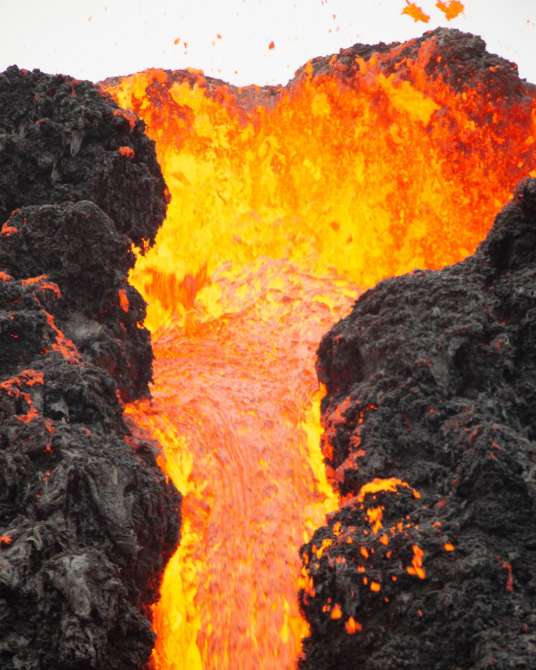
Tours in the spotlight

Volcanic Wonders & the Blue Lagoon

Volcanic Wonders of Reykjanes Geopark
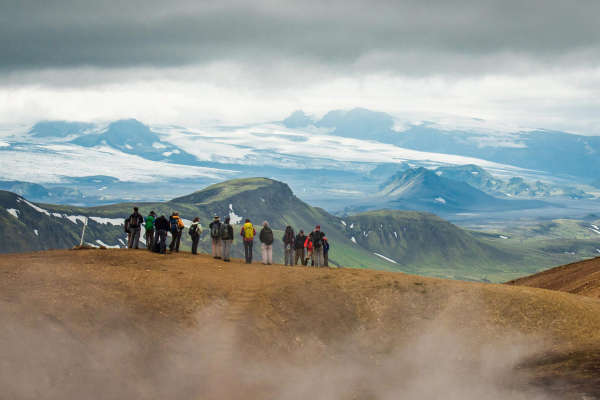
HIGHLAND BUS
Laugavegur & Fimmvörðuháls Combo Tour
284,000 ISK
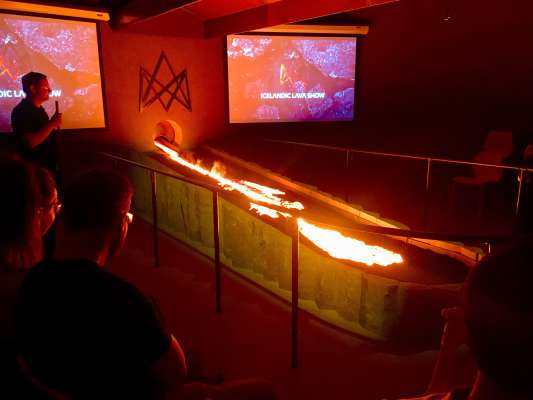
MEET ON LOCATION
Lava Show - Vík
Reykjavik excursions blog.
Get inspired! Information and tips and must see places in Iceland, fun facts, customs and more.
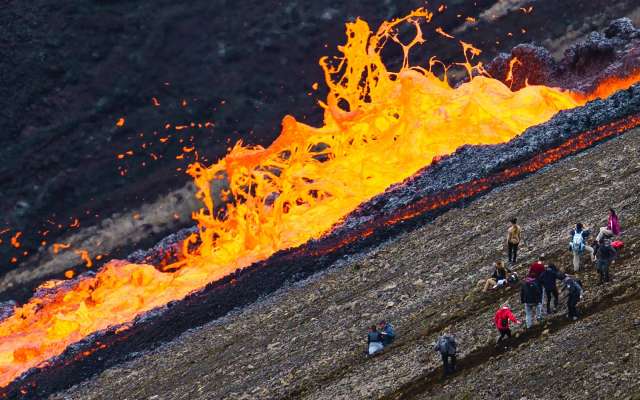
Litli-Hrútur Eruption 2023 - The New Eruption near Fagradalsfjall on the Reykjanes Peninsula
Once again, the enthralling spectacle of Iceland's Reykjanes volcano is back in the limelight! After 11 months of peaceful dormancy, the volcano is now alive and kicking, treating locals and tourists to another captivating visual performance. If you've been yearning for an adventure that's truly out of this world, this might just be your calling!
- Airport Transfer
- Shore Excursions
- Private Tours
- Groups & Coach Rental
- Special Offers
Active Volcano Tours
Active volcano tours in iceland.
A new active volcano eruption started in Iceland on the Reykjanes Peninsula on July 10th, 2023! We are now booking tours to the eruption site! Don´t miss your chance to experience the amazing beauty of an active volcano in Iceland! Learn more about active volcanos on the Reykanes Peninsula .
Volcano Tours
Active Volcano in Iceland: A Thrilling Encounter with Nature's Fury
Volcanoes have always captivated our imagination, with their raw power and awe-inspiring beauty. And when it comes to volcanoes, Iceland boasts an impressive collection, making it a dream destination for adventure seekers and nature enthusiasts. From exploring lava caves to witnessing volcanic eruptions up close, Iceland offers an array of experiences that will leave you in awe of the earth's forces.
Unveiling the Mysteries Underground: Exploring Lava Caves and Tunnels
Have you ever wondered what lies beneath the surface of a volcano? In Iceland, you can venture into the depths of the earth and explore lava caves and tunnels that were formed during volcanic eruptions. These natural wonders provide a glimpse into the fascinating world beneath our feet.
One of the most remarkable experiences is the Inside The Volcano Tour at Thrihnukagigur Volcano. This unique journey takes you inside the magma chamber of a dormant volcano, where you can witness the vibrant colors and intricate formations created by centuries of volcanic activity. Descending 400 meters into the heart of the volcano, you'll be immersed in a surreal environment that few have had the privilege to witness.
For those seeking a more adventurous underground experience, caving tours offer a chance to explore Iceland's vast network of lava tunnels. Raufarholshellir Lava Tunnel Tour takes you deep into tunnels that were carved by rivers of lava thousands of years ago. As you navigate through the underground passages, you'll be amazed by the otherworldly shapes and colors that adorn the walls. And if you visit during the winter months, you might even encounter beautiful icicles hanging from the ceiling, adding an extra touch of magic to your journey.
Shaping the Landscapes: The Impact of Lava on Iceland's Scenic Beauty
Iceland's dramatic landscapes are a testament to the power of volcanic activity. Over the centuries, eruptions have shaped the country's terrain, creating breathtaking vistas that seem to belong to another world. From towering mountains to expansive lava fields, each landscape tells a story of Iceland's fiery past.
One such iconic location is Dimmuborgir, known as the "Dark Castles" in Icelandic folklore. This volcanic rock formation is said to be the home of mythical creatures and offers a glimpse into the rich mythology of the country. As you explore the labyrinthine paths of Dimmuborgir, you'll be surrounded by towering rock formations and eerie silence, creating an atmosphere that feels both mystical and enchanting.
Iceland's Mighty Volcanoes: A Journey into Fire and Ice
Mount hekla: the queen of iceland's volcanoes.
Mount Hekla is undoubtedly the crown jewel of Iceland's volcanic wonders. With a history of frequent eruptions, this majestic volcano is a sight to behold. Hekla last erupted in 2000, and since then, scientists have been closely monitoring its activity. The pressure inside the volcano is rising, indicating that another eruption may be imminent. As you gaze upon the towering peak of Hekla, you can't help but feel a sense of anticipation and awe.
Hiking to the summit of Hekla is a dream for many adventurers. The 1491-meter trek offers breathtaking views of the surrounding landscape, as well as a chance to witness the raw power of nature up close. However, it's important to note that hiking Hekla requires careful planning and preparation. The weather conditions can be unpredictable, and the terrain can be challenging. It's recommended to join a guided tour to ensure your safety and make the most of this extraordinary experience.
Katla Volcano: A Sleeping Giant
Located beneath the icy expanse of Mýrdalsjökull Glacier, Katla Volcano is one of Iceland's largest and most active volcanoes. With a history of frequent eruptions, Katla is closely monitored by scientists for any signs of activity. Although there have been no recent major eruptions, the volcano's long dormancy period raises the question of when it will awaken once again.
Exploring the ice caves that form within the glacier is a popular activity for visitors to Katla. These ethereal caves offer a unique perspective on the volcanic activity that lies beneath the surface. As you wander through the crystal-clear ice formations, you'll be surrounded by a world of shimmering beauty. It's a surreal experience that showcases the delicate balance between fire and ice in Iceland.
Eyjafjallajokull Volcano: A Tale of Destruction and Resilience
Eyjafjallajokull Volcano gained international fame in 2010 when its eruption caused widespread disruption to air travel across Europe. The massive ash cloud that blanketed the skies grounded flights for several days, leaving travelers stranded and highlighting the immense impact that volcanic activity can have on our modern world.
Today, Eyjafjallajokull is a popular destination for hikers and nature enthusiasts. The Thorsmork Volcano Hike takes you through the stunning Thorsmork Valley, where you can witness the aftermath of the volcano's eruption. As you traverse the volcanic paths and gaze upon the magnificent glaciers, you'll gain a newfound appreciation for the resilience of nature and the incredible forces that shape our planet.
Fagradalsfjall and Litli-Hrutur: The Latest Eruptions on the Reykjanes Peninsula
In recent years, the Reykjanes Peninsula has become a hotspot for volcanic activity. Two notable eruptions have captured the world's attention: Fagradalsfjall and Litli-Hrutur.
Fagradalsfjall erupted in 2021 and again in 2022, drawing thousands of visitors to witness the fiery spectacle. Located in Geldingadalur, just 9 kilometers from Grindavik village, this volcano offers a unique opportunity to experience an active eruption up close. Guided tours provide a safe and unforgettable journey to the eruption site, where you can witness the mesmerizing flow of lava and the expanding craters. It's a dynamic and ever-changing landscape that showcases the raw power of nature.
On July 10, 2023, at approximately 16:40, a volcanic eruption occurred near the Litli-Hrutur mountain, southwest of Reykjavik. This marks the third eruption in the region within three years. Although the eruption is classified as small and not emitting ash into the atmosphere, precautions are in place to ensure the safety of visitors. Access to the volcano has been temporarily closed due to potentially high levels of volcanic gases. However, once the site partially opens, adventurers can embark on a 20 km journey to explore the eruption site via the Meradalir Route from Suðurstrandarvegur. With proper preparation and guidance, this adventure promises to be a safe and unforgettable experience, immersing you in the dynamic nature of an active volcano.
The Legacy of Volcanoes: An Unforgettable Journey in Iceland
Iceland's volcanic landscapes have left an indelible mark on the country's culture and identity. The stories and mythology woven around these fiery giants reflect the deep respect and reverence that Icelanders have for the forces of nature. Exploring the country's volcanoes is not just an adventure; it's an opportunity to connect with the land and its people on a profound level.
As you traverse the lunar-like landscapes and witness the raw power of an active volcano, you'll gain a newfound appreciation for the beauty and fragility of our planet. Iceland's volcanoes remind us of the ever-changing nature of our world and the importance of preserving its wonders for future generations.
So, if you're ready for an extraordinary journey into the heart of fire and ice, Iceland's active volcanoes await. Join us on an adventure that will ignite your spirit and leave you with memories that will last a lifetime.
Frequently Asked Questions
Q: Are volcano tours in Iceland safe?
A: Yes, volcano tours in Iceland are generally safe as long as you follow the guidance of experienced guides and adhere to safety protocols. It's important to remember that volcanic activity can be unpredictable, and conditions can change rapidly. By joining a guided tour, you'll have the expertise and support necessary to navigate these natural wonders safely.
Q: What should I wear on a volcano tour in Iceland?
A: Dressing appropriately is crucial for a comfortable and safe volcano tour in Iceland. It's recommended to wear layered clothing to adjust to changing weather conditions. A waterproof and windproof outer layer is essential, as well as sturdy hiking boots to navigate uneven terrain. Don't forget to bring a hat, gloves, and sunscreen to protect yourself from the elements.
Q: Can I visit an active volcano on my own?
A: While it's possible to visit an active volcano on your own, it's highly recommended to join a guided tour for optimal safety and an enhanced experience. Volcanic environments can be hazardous, with potential risks such as toxic fumes, unstable terrain, and sudden eruptions. By joining a guided tour, you'll have the expertise and support of experienced guides who can navigate these challenges and provide valuable insights into the volcanic activity.
Q: How can I stay updated on volcano activity in Iceland?
A: To stay updated on volcano activity in Iceland, it's advisable to regularly check official sources such as the Icelandic Meteorological Office and the Environment Agency of Iceland. These organizations provide real-time information on volcanic activity, including alerts and safety guidelines. Additionally, reputable tour operators and travel agencies can provide up-to-date information and guidance on volcano tours.
Embark on an Adventure of a Lifetime
The allure of Iceland's active volcanoes is irresistible. From exploring underground lava caves to witnessing the fiery eruptions up close, these natural wonders offer a once-in-a-lifetime experience that will ignite your sense of adventure. With the guidance of experienced tour operators, you can embark on a safe and unforgettable journey into the heart of fire and ice.
So, pack your bags, lace up your hiking boots, and get ready to witness the raw power of nature in one of the most captivating destinations on Earth. Iceland's active volcanoes are waiting to reveal their secrets to those who dare to venture into their fiery embrace.
Iceland is open for travel: check volcano updates here
- Language/Currency EN Language EN English DE German CN Chinese $ USD ISK ISK $ USD € EUR CA$ CAD £ GBP

TOP 6 VOLCANO TOURS IN ICELAND
Top 6 Volcano Tours in Iceland
Eyjafjallajökull Super Jeep Tour
- Hekla, the Queen of Iceland
- Tour Inside A Volcano
- Mystical Underworld
- Ice & Fire Combo
- Active volcano hike
Related Tours
Related blogs.

Iceland is known as the land of fire and ice, with the country's many spectacular volcanoes give it the 'fire'! Here are 6 of the best volcano tours that you can take!
The country’s numerous stunning glaciers are where the ice part is derived from, but the fire, quite literally, comes from the many spectacular volcanoes which are dotted around the country.
Visitors flock from across the globe to see these mighty and ancient naturally occurring structures. While people generally think about hot boiling lava spewing from a gigantic mountain when they think of the word ‘volcano’, not all of Iceland’s volcanoes are active (meaning they aren’t going to erupt any time soon – fortunately for us!). In fact, there are many different kinds of volcanoes to see in Iceland, each of which offers its own unique experience.
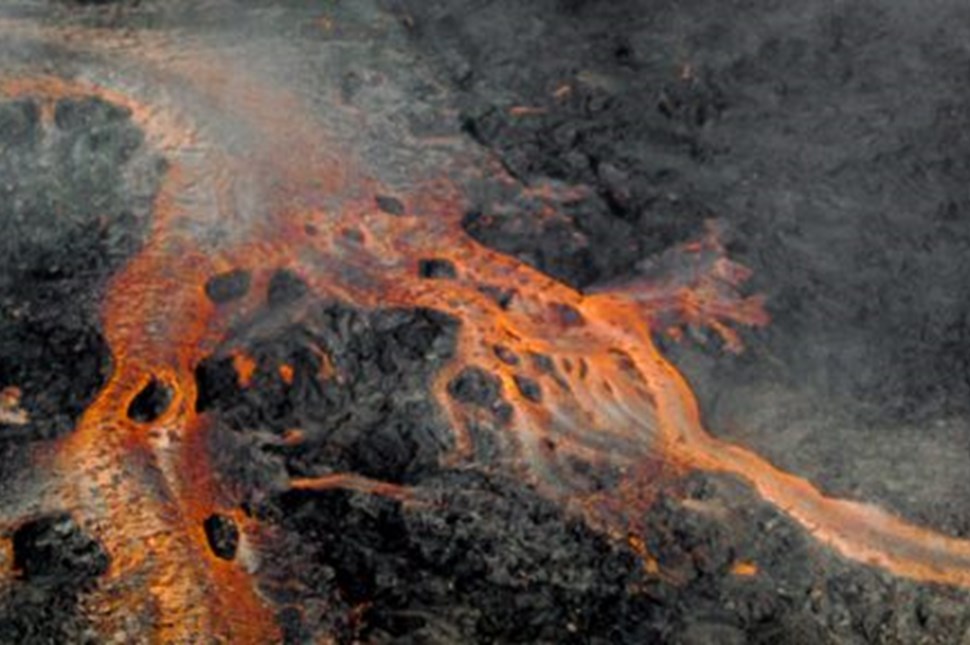
Arctic Adventures’ selection of volcano tours are as varied as the volcanoes themselves. With so much to choose from, it can be difficult to decide on which tours to go on. We’re here to help though, with five of the best volcano day tours that Iceland has to offer, as chosen by our team of professional Arctic Adventurers!
6. The Mount Eyjafjallajökull Super Jeep Tour
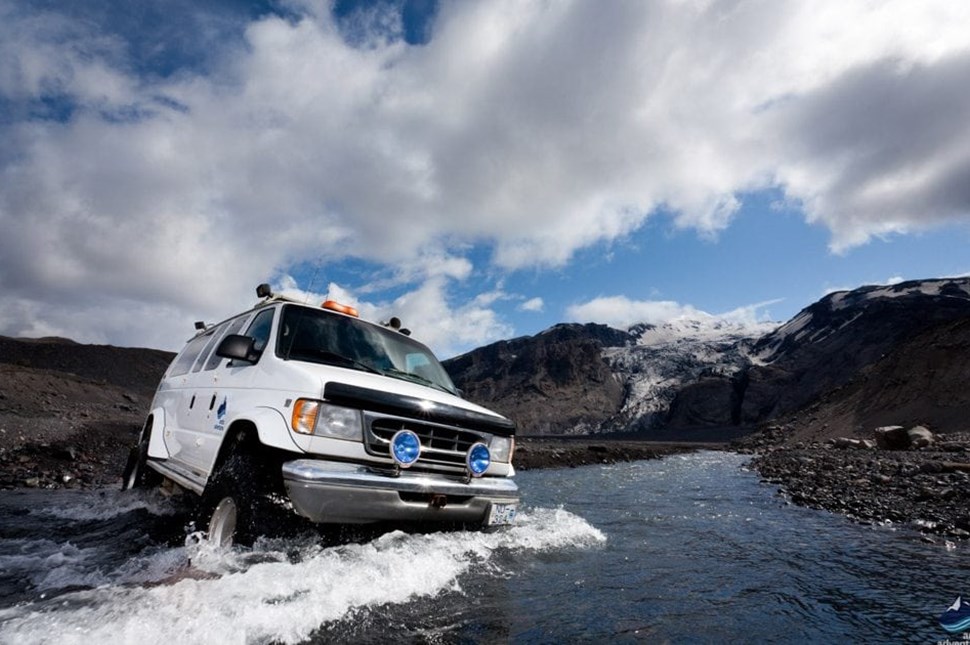
Super Jeep Tour
Sometimes known as “the volcano that caused all the trouble”, Mount Eyjafjallajokull became famous (or is that infamous?) in 2010 when a series of powerful eruptions caused absolute chaos, both in the local area and much further afield.
Intense heat generated by the volcanic activity caused the glacier at the top of Eyjafjallajökull to melt. This, in turn, created meltwater which powered through nearby rivers and led to the evacuation of 800 local people. Eyjafjallajökull also managed to spew enough volcanic ash into the air to have a huge area of important European airspace to be closed for over a week. This meant that many inter-European and trans-Atlantic flights were shut down and 5 million travelers were stranded!
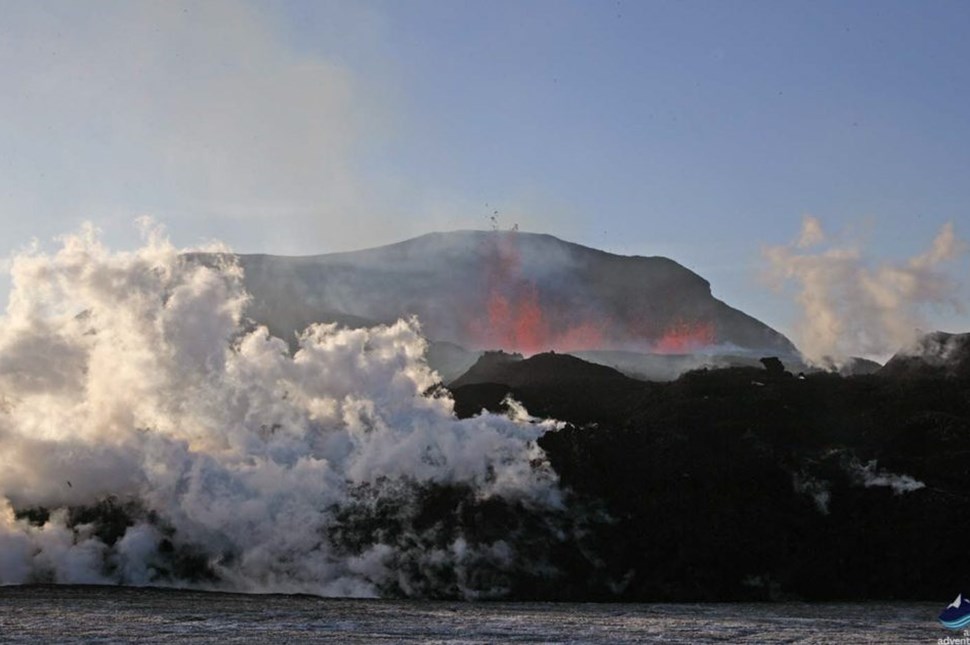
Eyjafjallajokull Eruption
Thankfully, Mount Eyjafjallajökull hasn’t caused any trouble in the best part of a decade and is unlikely to do so again for a very long time (the last eruptions before 2010 happened in the 1920s), so now would be a good time to go visit this mischievous mountain. Jeep tours are a great way to explore rugged landscapes like this.
The Eyjafjallajökull Super Jeep Tour is our favorite way to visit Mount Eyjafjallajökull as it allows you to check out other awesome natural Icelandic landmarks including gushing waterfalls and Gigjokull Glacier, one of the many striking Icelandic landscapes featured in Game of Thrones .
5. Visit Mount Hekla, the Queen of Iceland

Mountain Hekla
Hekla is referred to as “the Queen of Iceland” due to the fact that this huge volcano, located in the South of Iceland, absolutely dominates the landscape around her. Not only does Hekla strike an imposing figure, standing an impressive 1,488 meters tall at her summit, but she has also transformed the area around her.
As one of the world’s most productive volcanoes, Hekla has produced 8 km 3 of lava in the last millennium. So much so in fact, that the surrounding landscape, which was once heavily forested, is now largely covered in ash and bare rock. Life is resilient, however, and plants have started making a comeback since Hekla’s last eruption in the year 2000, with hardy mosses and grasses appearing in the shadow of the mountain. And where there are plants, animals are never far behind – life finds a way.
While many call Hekla Iceland’s Queen, in medieval times, they had a very different name for this mountain; “The Gates of Hell”. It earned this fearsome nickname after a massive eruption took place in 1341. Onlookers saw the silhouettes of countless birds fleeing from the eruption and mistook them for the souls of the damned escaping from the depths of hell!
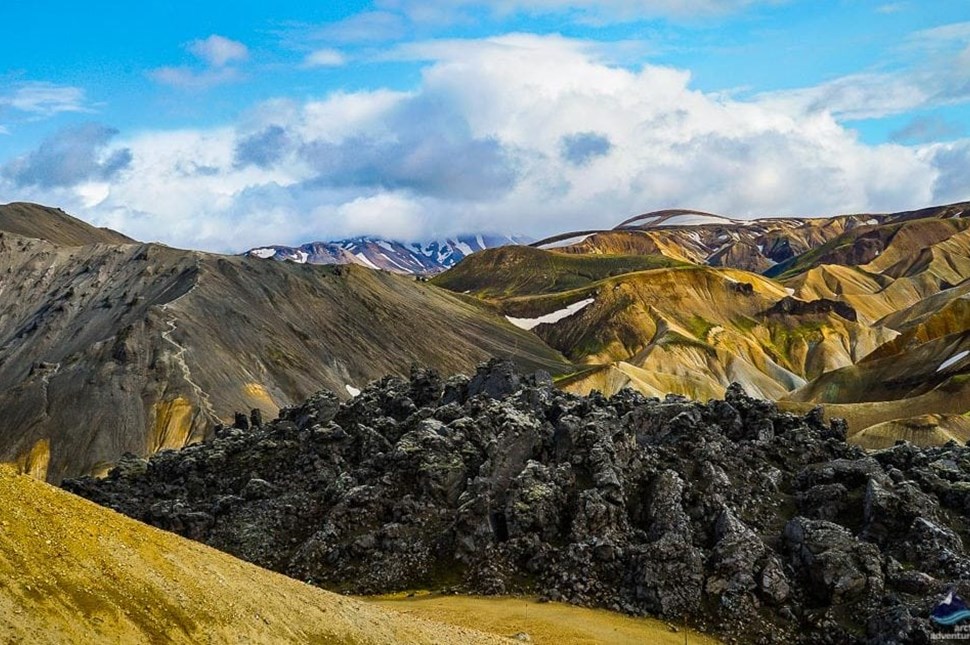
Landmannalaugar
Mount Hekla cannot be fully appreciated unless the surrounding area is taken into account as well. The best way to do this is on the Landmannalaugar hiking tour , which allows visitors to take in the extraordinary sights of the region, including lava fields, hot springs and clear blue lakes, at their own pace.
4. Take A Tour Inside A Volcano!
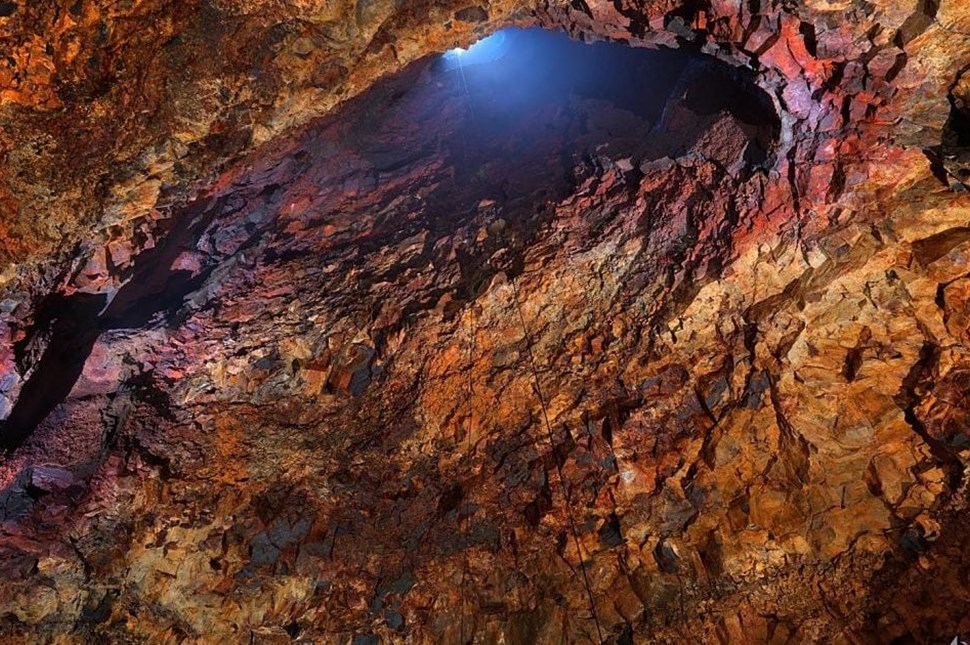
Inside the Volcano
Now that we’ve discussed a couple of different ways to see a volcano from the outside, how would you feel about climbing inside one? That’s exactly what you can do on Arctic Adventures’ Inside the Volcano Tour , a real-life Journey to the Centre of the Earth ! (Fun fact: 2008’s version of Journey to the Centre of the Earth , starring Brendan Fraser, was one of the many movies filmed in Iceland )
On this epic tour, you get to visit Thrihnukagigur Crater, the “Three Peaks Crater”, a dormant volcano not far from Iceland’s capital city of Reykjavik . This is a truly unique experience, as Thrihnukagigur is the only volcano in the world where visitors can take an elevator all the way down to the magma chamber. While that might sound scary, it is totally safe as the magma drained away long ago – the last eruption having taken place in the 2 nd Century.
This small group tour allows you to descend 180 meters down into a 4,000-year-old volcano – there is literally nowhere else on Earth where you can do this!
3. Explore Iceland’s Mystic Underworld
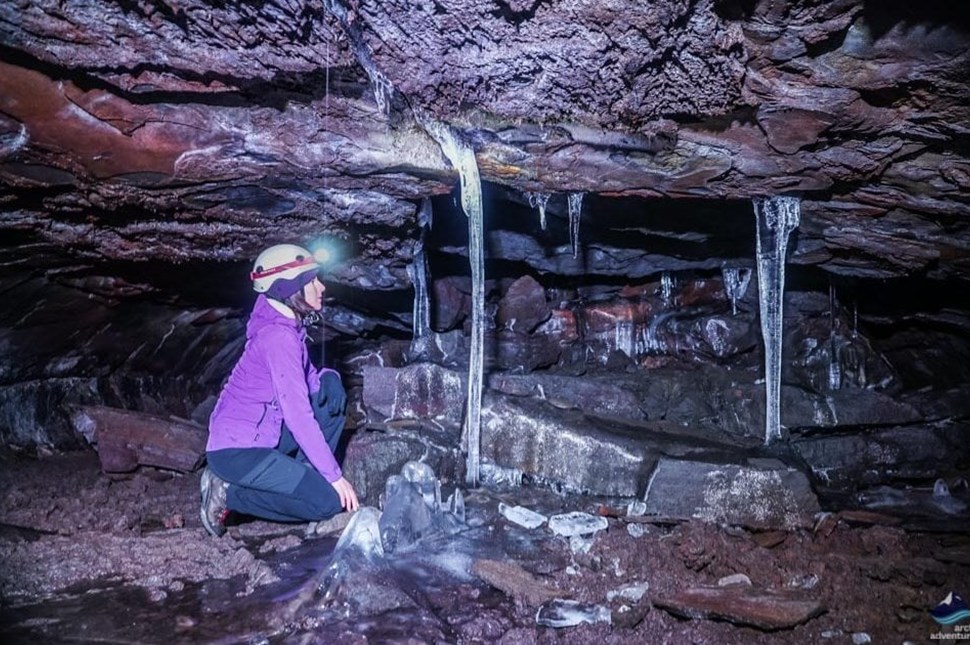
Lava Caving Tour
If you thought getting inside a volcano was a strange and wonderful experience, then what would you say about exploring what lies beneath one? On our ‘Underworld’ Lava Caving Tour , an expert Arctic Adventures guide will take you to a strange world quite unlike anything you’ve ever seen before!
This is the ultimate adventure tour for all of you budding speleologists (scientists who specialize in the study of caves and their associated rock formations). Armed with your helmet and torch (provided on arrival), you can witness the impressive stalagmites, amazing stalactites and all manner of other impressive geological features.
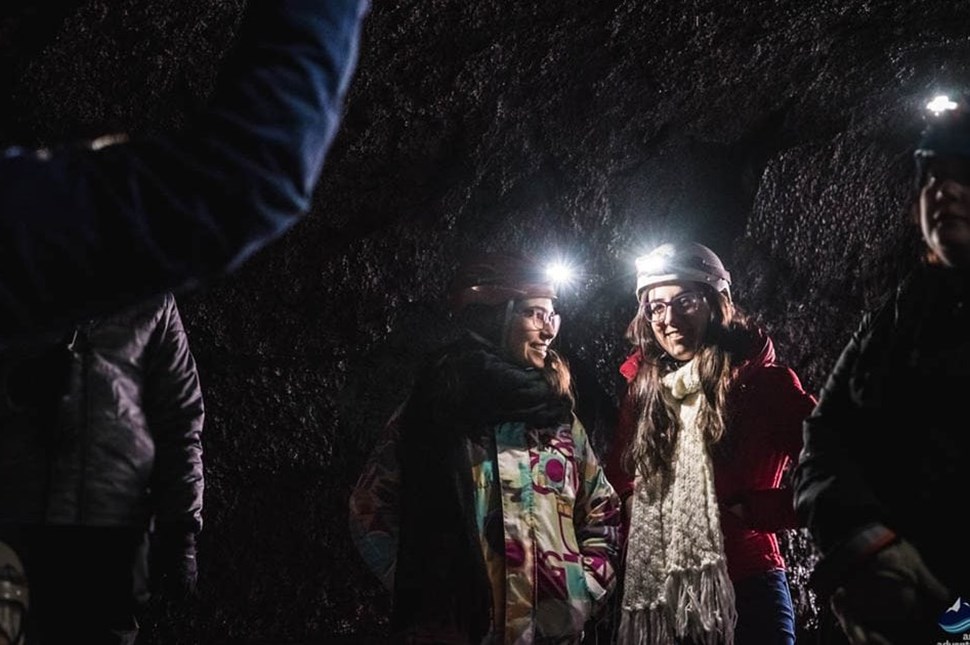
Exploring the Lava Cave
With a visitor to guide ratio of only 8 to 1, there is great opportunity to learn everything you’ve ever wanted to know about Iceland’s strange and mysterious underground. As if that wasn’t enough, there is also a private version of this tour available as part of our premium Action Weekend .
2. The Ultimate Ice & Fire Combo Deal
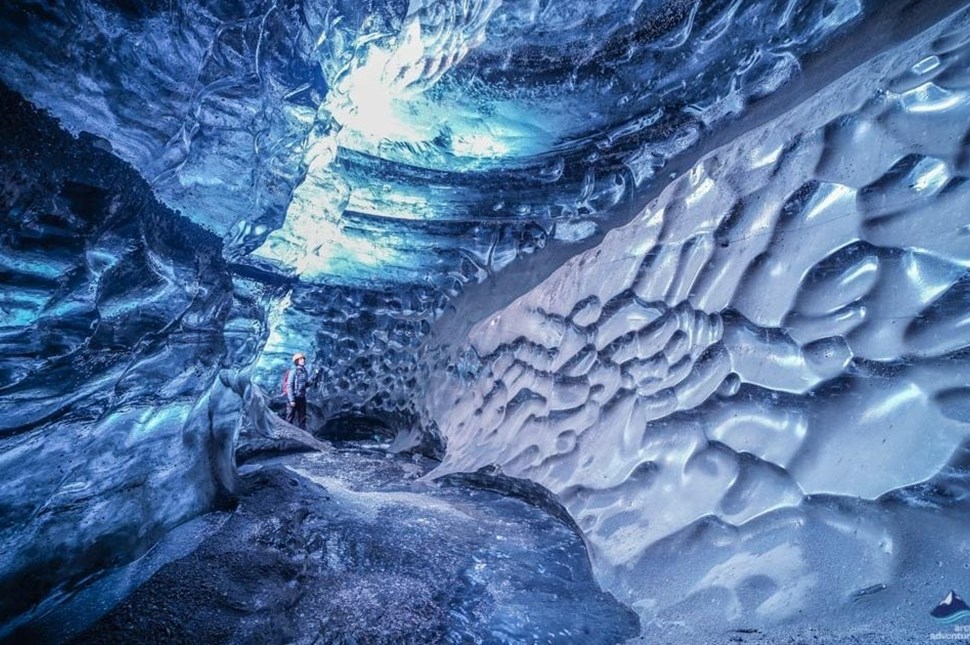
Katla Ice Cave
Those of us who want to experience the ultimate Icelandic ‘fire and ice’ experience should look no further than the Katla Volcano Ice Cave Tour , which combines the best of both worlds; a mighty volcano and a stunning glacier!
Departing from the scenic coastal village of Vík , Iceland’s southernmost populated area, this tour takes visitors a bit off the beaten track and out into a wonderful world which typifies everything people love about Iceland.
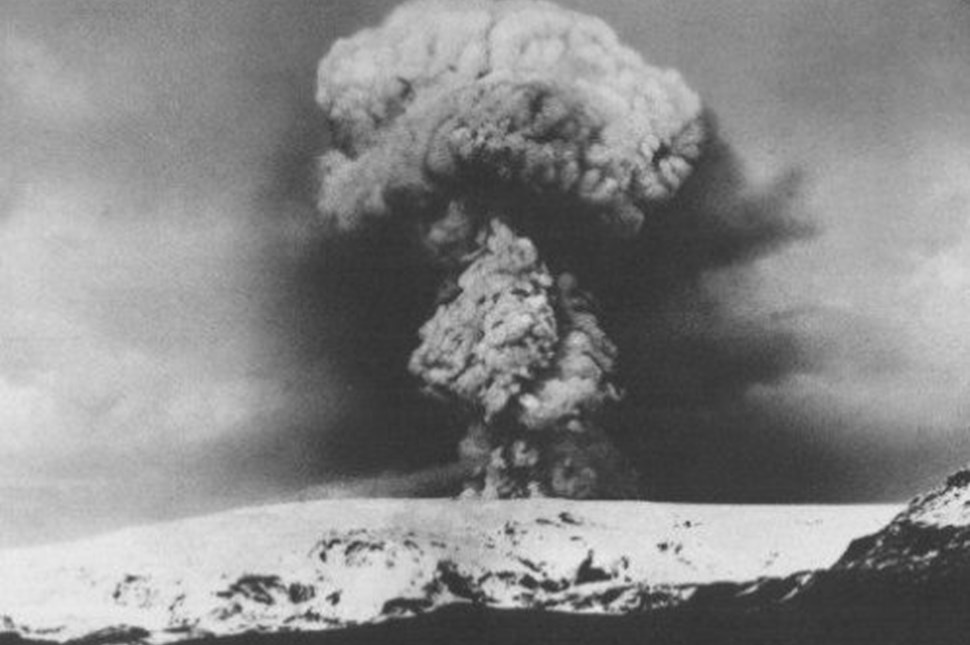
Katla Volcano Eruption in Iceland
Starting out in one of Arctic Adventures’ action-seeking super jeeps, the tour brings you to Myrdalsjokull Glacier , where all sorts of frozen wonders await, including an awe-inspiring ice cave. Here, an expert guide will show you around and regale your crew with all sorts of fascinating facts about this unusual and majestic natural wonder.
Of course, in Iceland, fire is never too far from the ice. In this case, the fire is provided by Katla Volcano, one of Iceland’s biggest. Since Katla is considered to be an active volcano, there will be no climbing around inside this one, unfortunately! There is little to fear, however, as the volcano has not erupted properly in over 100 years.
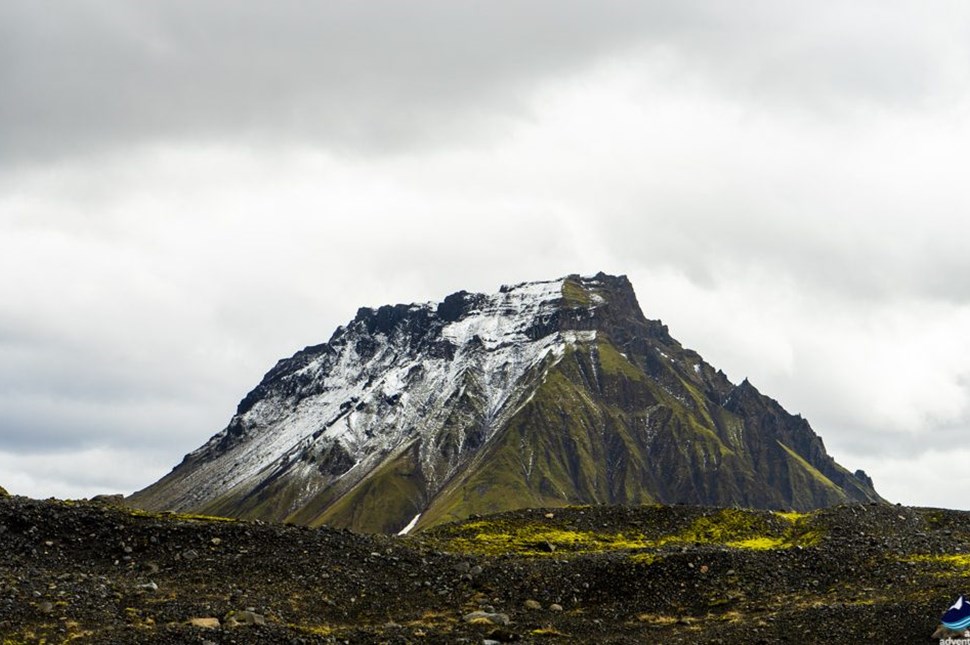
Katla Volcano
While Katla is unlikely to be at its explosive worst when you come to visit, it remains a magnificent sight, standing nearly 5,000 feet tall. It does rumble from time to time though, which makes for a very intimidating experience indeed!
1. ACTIVE VOLCANO HIKE ON THE REYKJANES PENINSULA

Man Watching Active Volcano
The Reykjanes Peninsula has experienced three eruptions in the Fagradalsfjall volcano region over the past three years, with no prior disruptions to lives, infrastructure, or flights. Find out more about the newest volcano eruption in Iceland and stay updated on the latest news!

Volcano Eruption
The volcano is waiting. Whether you get there by helicopter , a minibus, with a bigger group of like-minded travelers, or on a private tour , we have the right guided tour for you.
Ready to see the volcano in real life? Make your dream a reality with our volcano tours .
Still unsure as to which Icelandic volcano tour is for you? Be sure to contact us and we’ll help you choose.
If you are ready to see the volcanoes in real life, check out our volcano tours .
Best Seller
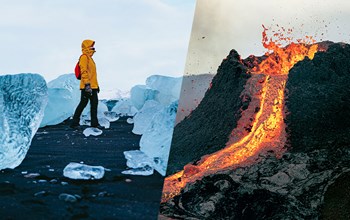
4 Day - Golden Circle, South Coast, Ice Cave & Recently Erupted Volcano

Helicopter tour to recently erupted volcano

3 Day - Iceland’s Highlands and Volcano Adventure

Your Ultimate Guide to Iceland in July

Guide To Westman Islands: Iceland's Explosive Pearl
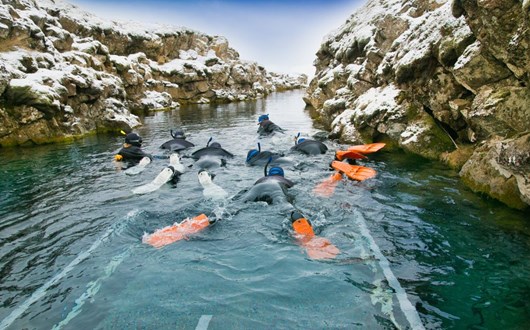
What to Wear Snorkeling
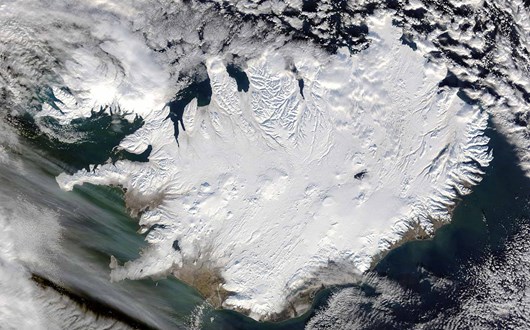
What to Wear in Iceland
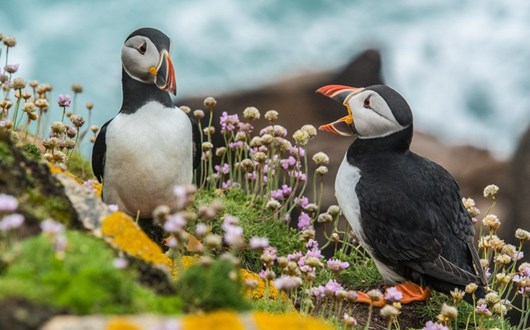
Puffins in Iceland - Everything You Need to Know

Icelandic food
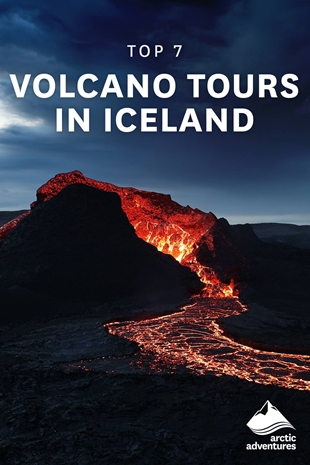
9 Day - Around Iceland, Highlands and Volcano Adventure
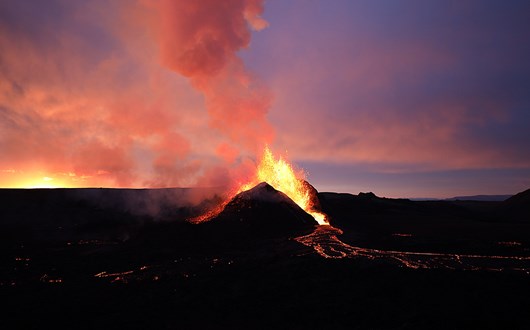
Top 15 Icelandic Volcanoes
List of volcanic eruptions in iceland.
Iceland is nicknamed the land of ice and fire. The fire represents the abundance of volcanoes and volcanic systems tucked away in the colorful landscape. Here are the top 15 Iceland Volcanoes!

All About Bardarbunga Volcano and What is Going On
Bardabunga Icelandic Volcano is always showing some activity. Last erupted in 2014 but where does the volcano stand today? Here you will get a chance to learn all about this beautiful Volcano and where it stands today. Will it be the next I...

Godafoss, Mývatn and Askja Volcano Tour
The North of Iceland is a whole new planet to discover. The Volcanic activity, the colorful mountains, and dramatic mountains make the most beautiful landscapes which Kay visited on the Goðafoss, Mývatn and Askja Volcano tour. Here she tell...
Share our passion for Iceland, get top travel stories & special offers to your inbox
National Geographic content straight to your inbox—sign up for our popular newsletters here

What you need to know about volcano tourism in Iceland
As seen in recent eruptions, seismic activity in the country is hotting up. From travel advice to ‘volcano tourism’, here’s what you need to know about visiting Iceland.
Volcanic activity in Iceland has been rumbling on for months, centred around the Reykjanes Peninsula near Reykjavík, in the southwest of the country. After multiple earthquakes, the most recent series of eruptions kicked off at the end of 2023, when an explosion along a 2.5-mile fissure sent lava into the air a couple of miles northeast of the fishing village of Grindavík; another followed shortly afterwards.
Now, a new fissure near Sýlingarfell, northeast of Grindavík, has begun spewing lava and smoke.
What’s the background?
In 2021, after 6,000 years lying dormant, the Fagradalsfjall volcanic system on the Reykjanes Peninsula sprang back into life with the appearance of a 600ft-long fissure. Until that moment, the region hadn’t seen an eruption for over 800 years. Three small blasts followed (in 2021, 2022 and the summer of 2023), each producing fountains of fire.
A nine-mile dike (an underground pathway that allows magma to travel towards the surface) on the Reykjanes Peninsula was discovered to be the underlying cause, and since then there have been further eruptions that have reached the town of Grindavík. If additional volcanic activity occurs, it’s likely to take place in this region.
What does it mean for travellers?
So far, the greatest disruption has been to the residents of Grindavík, who were evacuated prior to the December eruption. Following recent blasts, some homes here have been destroyed by lava. The nearby Blue Lagoon, the country’s most popular attraction, has briefly closed, on and off, as a precautionary response to the eruptions, but has not been otherwise impacted. Reykjavík and the international airport, meanwhile, were unaffected.
Some passengers on flights that have flown over eruption sites have been treated to spectacular scenes from their window seats.
‘Volcano tourists’ have since converged on the area, hoping for a glimpse of the lava. However, Icelandic police warned people to “think four times” before attempting to get close to the sites, after an exhausted hiker had to be rescued by helicopter.
What happens next?
As volcanoes can be unpredictable, it’s hard to say with 100% certainty. “Most volcanologists seem to agree that this period of volcanic activity is going to go on for many years, if not decades,” says Dr Robin Andrews, a volcanologist. But, “it’s difficult to study the systems where there’s no central volcano.”
Is there likely to be a repeat of the 2010 ash cloud?
Experts in the fields of volcanology and aviation agree that a repeat of the events that followed the Eyjafjallajökull eruption likely won’t happen again. Back then, a six-day shutdown of European airspace, due to the presence of ash in quantities sufficient to cause engine failure in planes, caused the cancellation of some 100,000 flights.
The fact that the volcanoes involved in the most recent eruptions don't open onto a large ice sheet, as Eyjafjallajökull does, minimises the amount of ash likely to be ejected — when ice melts into a volcano, the magma cools rapidly and forms fine ash particles. Additionally, the world of aviation has seen advancements in technology since 2010, and the European Union Aviation Safety Agency has confirmed it’s better prepared for a volcanic ash event.

Is it safe to go to Iceland?
Volcanic activity is currently largely isolated to the Reykjanes Peninsula. Beyond this region, Iceland is safe and its main tourist sites remain open.
Dr Andrews recommends that anyone planning to travel to the country monitors the advice of the Icelandic Meteorological Office , which shares comprehensive data on the latest activity. The Foreign, Commonwealth & Development Office travel pages are also updated as conditions change. While in Iceland, monitor local news and heed local authority guidance.
“There’s a lot of uncertainty,” says Snorri Valsson, of the Icelandic Tourist Board. “It’s a localised seismic event limited to the area around Grindavík — in the rest of the island, it’s business as usual. But it’s understandable that some people might be disturbed by the news.”
What about insurance?
Always make sure you take out comprehensive insurance when booking a trip to ensure you’re covered before departure. At least £2,500 is a good level of protection for short-haul trips. Ensure the policy covers repatriation in the event you need to head home early.
Introducing Nat Geo Kids Book Bundle!
Related topics.
- VOLCANIC ERUPTIONS
- EXPLORATION
- SUSTAINABLE TOURISM
You May Also Like

Bears, wolves and rewilding in Romania's Southern Carpathian mountains

Why visit Annecy, gateway to the shores and summits of the French Alps

10 whimsical ways to experience Scotland

The essential guide to visiting Scotland
_4x3.jpg)
The ‘Yosemite of South America’ is an adventure playground in Patagonia
- Environment
- Paid Content
- Photography
- Perpetual Planet
History & Culture
- History & Culture
- History Magazine
- Mind, Body, Wonder
- Destination Guide
- Terms of Use
- Privacy Policy
- Your US State Privacy Rights
- Children's Online Privacy Policy
- Interest-Based Ads
- About Nielsen Measurement
- Do Not Sell or Share My Personal Information
- Nat Geo Home
- Attend a Live Event
- Book a Trip
- Inspire Your Kids
- Shop Nat Geo
- Visit the D.C. Museum
- Learn About Our Impact
- Support Our Mission
- Advertise With Us
- Customer Service
- Renew Subscription
- Manage Your Subscription
- Work at Nat Geo
- Sign Up for Our Newsletters
- Contribute to Protect the Planet
Copyright © 1996-2015 National Geographic Society Copyright © 2015-2024 National Geographic Partners, LLC. All rights reserved
Visit a Volcano in Iceland
The Geldingadalur volcano is a rare opportunity to experience Iceland’s powerful natural forces yourself. Here are some ways you can work a hike to the volcano into your self-drive holiday/road trip.
Difficulty level:
Route A (currently closed to recent lava flow): Moderate. You should be in reasonable physical condition and have some hiking experience.
Route B: Moderate to Difficult. You should be in good physical shape and have some hiking experience. This is longer, uneven terrain and more difficult to walk than Route A. There is one very steep slope where there is a rope to hold on to. Hiking shoes and hiking poles are essential.
Hiking Distance :
Route A: 8 km (5 miles)
Route B: More than 8 km (5 miles) through steep terrain
Elevation: 300 m (985 feet)
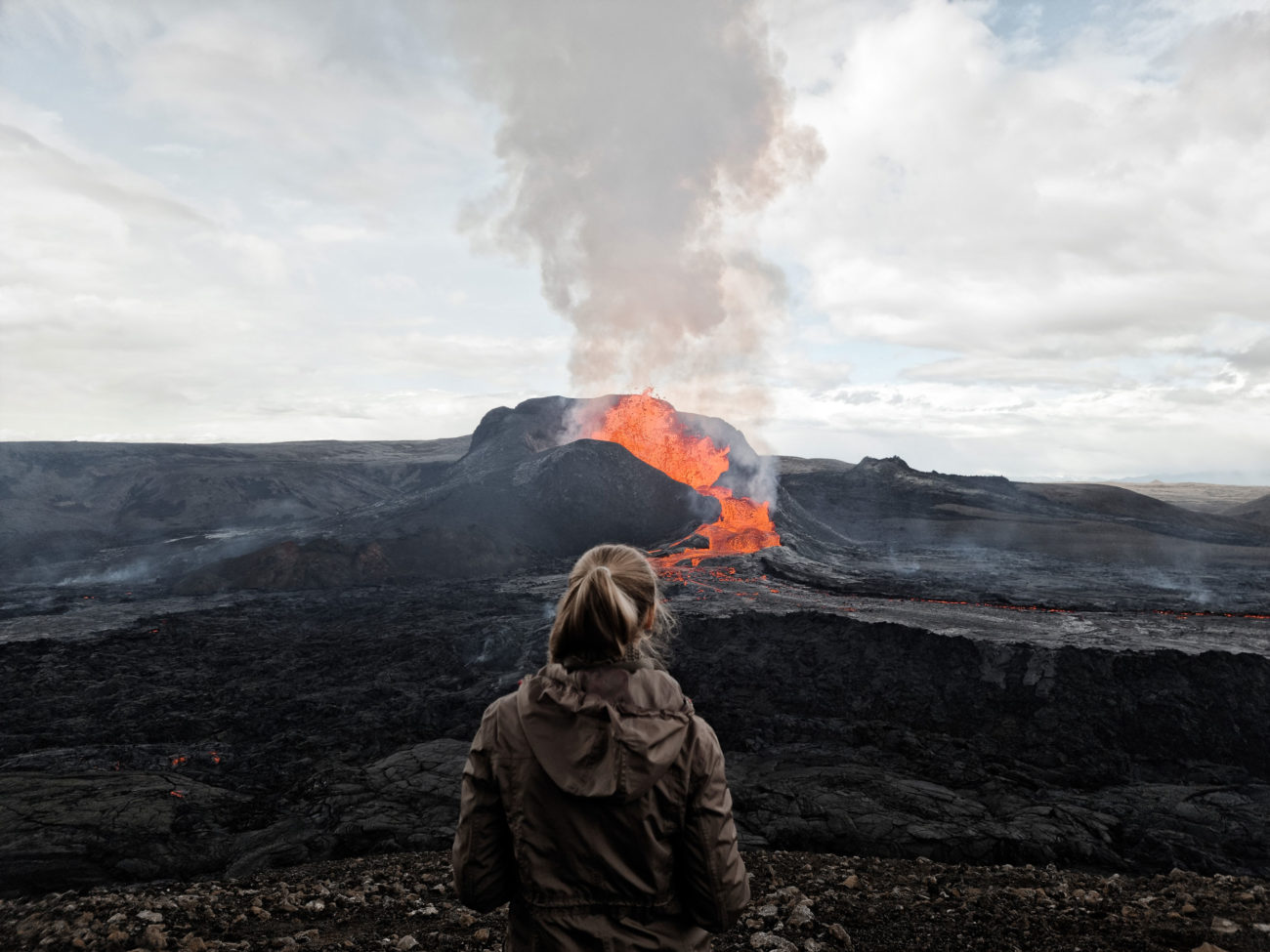
Option 1: Enjoy a guided tour and extra day in Reykjavík
Add an extra day after your tour in Reykjavík and take the Guided Geldingadalur Volcano Hike – Enjoy a convenient coach transfer to the Geldingadalur Volcano Trail Head. Join your expert guide for an informative, interesting hike through scenic lava landscapes to the volcano. You’ll learn about the volcano and the fascinating Reykjanes Peninsula. The tour is offered on Mon, Wed, Sat, Sun.
Option 2: Make it a self-guided hiking tour
Are you experienced with hiking? With a little preparation you can visit the volcano yourself. Drive to the trail head and follow the easily marked hiking trail to the volcano viewing site.

- Pace your day. Route A: Expect to spend about 2 – 3 hours of walking round-trip and about 1 – 2 hours viewing the volcano. Route B: Expect to take 3 – 4 hours round-trip hiking
- You are always responsible for your own safety when you hike unaccompanied in Iceland.
- Expect the unexpected: the weather in Iceland changes quickly.
- Treat the landscape – and the volcano – with respect. Please don’t litter the area; pack your trash with you.
- Make sure you are dressed for hiking. Essential: hiking boots, suitable wind and waterproof clothing for hiking in cold weather. Bring raincoat and pants.
- Bring a packed lunch, snacks and bottled water.
Arrival Day: Visit the Volcano from the airport – Is your flight arriving in the morning or early afternoon? Do you like to start right off with action as soon as your flight arrives? The hiking trail head is about 30 minutes’ drive from the airport.
- Check the latest volcano trail conditions at safetravel.is before you start hiking.
- Make sure you are dressed for hiking when you arrive in Iceland.
- Bring a packed lunch, snacks and bottled water. You can for example purchase supplies at the airport’s Mathús self-service kiosk or at grocery stores/ shops in Grindavík town.
Arrival Day: Afternoon or Evening volcano hike – During the summer months daylight hours are long. Grab some rest at your accommodation and then head to the trail for a volcano hike. Staying in Hveragerði? – It’s about a 50-minute drive on Road 427 to the volcano trail head. Staying in Reykjavík? – It’s about an hour’s drive on Roads 41 and 43 to the volcano trail head.
Check the latest volcano trail conditions at safetravel.is before you start.
Note- Arrival day suggestions are subject to current COVID travel and testing policies . Please check covid.is website for the latest information.
Departure day
If your flight is leaving in the late afternoon or early evening you might have the opportunity for hike to the volcano earlier in the day. Make sure you leave enough time to drop off your car and check-in for your flight no later than 2.5 hours before your flight.
- It is your responsibility to make sure you give yourself enough time to make flight check-in.
Useful Information
Packing list prepared by a landowner near the volcano (Volcano in Iceland)
Icelandic Weather
Who Should (or Shouldn’t) Hike to the Volcano
Daily Geldingadalur Trail Conditions
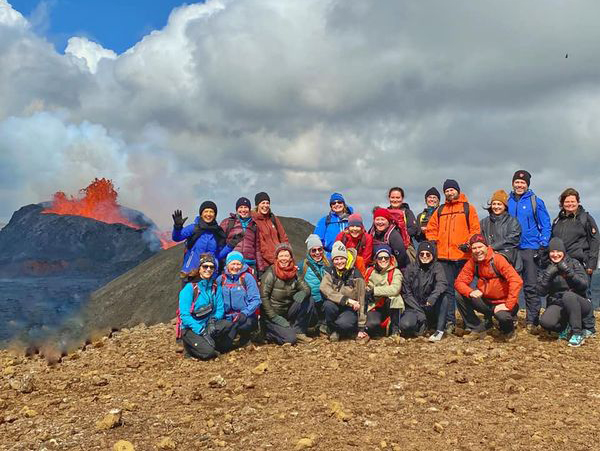

Travel Blog | Travel Inspiration
Witness An Eruption: How To See The Volcano In Iceland

In March 2021, something special happened in Iceland. A volcano started erupting and it created a brand new – and spectacular! – attraction for people to visit. It is one of those rare chances to see a volcano erupting right in front of you! At the time of writing, the eruption at Fagradalsfjall is still going – so read on for information on how you can see the volcano erupting with your own eyes.
I’ve always been fascinated by volcanoes, ever since learning about them at school. I’ve visited volcanoes in New Zealand, Greece and the Canary Islands, and I’ve dreamed of seeing one erupt – but I knew it was a long shot, as the opportunities to do that safely are rare. Therefore, when news broke of the erupting volcano in Iceland, I was super keen to go there as soon as it was safe and possible for me to do so. I visited it twice in early August 2021 after driving the Ring Road , so in this post, I’ll share my experience of both visits.
The eruption is changing all the time… The info I’m sharing is correct at the time of publishing (August 2021). However, in case things change, I’ll share some links on where you can get the most recent information on the eruption.
Table of Contents
History of the eruption at Fagradalsfjall
Fagradalsfjall is a system of volcanoes in the Reykjanes peninsular, near the capital of Iceland, Reykjavik. It formed more than 11,000 years ago, but it had been dormant for an estimated 6,000 years until 2021. In fact, there hadn’t been an eruption in the whole of the Reykjanes peninsula for 800 years.
Fagradalsfjall sits at the divergent boundary between the Eurasian and North American tectonic plates, meaning it is one of the points where these two plates of the earth’s crust are pulling apart. And when tectonic plates pull apart, hot magma bursts out!
As with most volcanic eruptions, the Fagradalsfjall eruption was preceded by a series of earthquakes, which let scientists (and nearby residents!) know that something was moving below the surface. These earthquakes went on for more than a year, and then, on 19 March 2021, a fissure opened in the Geldingadalir valley and the eruption began.
Almost immediately, people hiked out to see the eruption and the lava flows – and I followed their pictures and stories keenly via social media. It has attracted huge numbers of people ever since.
The eruption has evolved over time: fissures turned into craters (at one time, there were seven craters spurting lava; when I saw it, there was one main crater, and shortly after that, it had evolved again into twin craters), and lava started to fill the Nátthagi valley. After a firey start, activity slowed and the volcano went through a period of stopping and starting in June & July 2021. And then it came back in full force in late August 2021. The lava flow has overrun several barriers built to contain it, and there are fears it will cross the main road on the south side of the peninsula soon.

Is it safe to visit the erupting volcano in Iceland?
Aren’t volcanoes, like, dangerous? Well, yes…
It is possible to visit the Fagradalsfjall eruption because it is less dangerous than many other kinds of eruptions. It isn’t the explosive kind of volcano that produces explosive volcanic bombs, huge ash clouds nor pyroclastic flows (like the kind that wiped out Pompeii in Italy). That’s why people have been able to get right up close to the lava flows. In fact, in the early days, people were cooking pizza and sausages on the hot rocks!
But there are dangers, of course: there’s a danger from gases emitted from the volcano and as such, there is continual monitoring of the site. You can check volcanoweather.is to see what the gas pollution is like before you visit.
There’s also a danger from walking on the lava. Even black, solid-looking lava could be a thin crust over 1,000°C molten lava below, so it’s a terrible idea to walk on the lava (although I did see some idiots doing that when I visited).

How to see the volcano erupting in Iceland
If you want to get up close and personal with a real live erupting volcano in Iceland, you have two options: 1) hike there by foot or 2) fly over it.
I tried both options, and I can say that the first option is definitely cheaper! But the second option gave better views. I’ll give you an overview of both options.
Seeing the eruption by foot
Unsurprisingly, most people choose the option to hike to the volcano in Iceland. It is way, way cheaper than taking a plane or a helicopter! And if you like hiking, then there’s an added bonus.
For official information on the safety of visiting the eruption on foot, check out these websites:
- VisitReykjanes.is gives an overview of visiting the site
- Volcanoweather.is where you can see weather and gas pollution forecasts
- Safetravel.is , for current safety information and where you can log your journey if you wish.
Where does the hike to the volcano start?
The hiking route is fairly close to the volcano along route 427, approx 10 min drive east of Grindavík.
There are three car parks, which you can find using the map on VisitReykjanes.is (unfortunately GoogleMaps isn’t updated with the volcano and car parks at the time of writing). It is free to do the hike to the volcano, but the car parks aren’t free. They cost 1000ISK for the day, which you can pay online by entering your car registration number and payment card details (there’s a sign with the info in the car park).
What is the hiking route like?
There are several hiking walks that have been established since the volcano started erupting. One of them (route A) stopped being viable when the lava flowed right across it (!), so when I visited, most people used route C instead.
A map of the routes is available on Safetravel.is .

Route C takes you first to the lava pool that has formed in the Nátthagi valley, and then you have the option to continue up a hillside to the right-hand side of it, to get a better view over the crater itself (which is not visible from the lava pool).
The stretch of route C to the Nátthagi valley was fairly easy – a few ups and downs, but mainly flat.
The path up the hillside to see the crater, however, was more challenging. The first incline is fairly steep and the ground is gravelly, so it is quite slippery. There’s also not a properly marked path, and people have clearly tried to take a number of routes up the hillside, turning it into a wide, gravelly slide.
Going up was hard work, and coming down was a bit treacherous, to be honest. I saw a few people fall over – and I was one of them (embarrassing, but I wasn’t hurt)! I also saw a man with a small child going down on his bottom, I guess to avoid the risk of falling over. And as I was leaving, I saw the search & rescue people on their way to help someone who was in difficulty on that slope. So it is not for the faint-hearted!

What views are possible from the ground?
In Nátthagi valley, the main sight to see is the pool of lava that has gathered there, and the flows of lava down the hillside from the area where the crater is. When I visited, these were all black, with no sign of red hot liquid lava – though the lava was still emitting smoke and gas, so I knew it was hot.

If you go up the hillside route, you will be able to see the main crater itself – and if you’re lucky, you will see it erupting red hot lava into the air!
On my visit by foot, however, it was quiet – some smoke, but no visible eruption. I waited around a while, in case it started erupting again, but I didn’t get lucky on that day.

Based on other people’s photographs after I visited, there has been a lot to see at the eruption recently: lava spurting from the craters and many flows of red hot lava along the ground, which people seem to be able to get quite close to. I would have loved to have been able to see these lava flows and to get some close up photographs of them, but it just didn’t work out that way for me.
But don’t feel too bad for me because I did get to see the volcano erupting the day after my hike!
Seeing the erupting volcano in Iceland from the air
What options are there to see the eruption by air.
The more expensive, but more spectacular, option for seeing the erupting volcano in Iceland is from the air. Both small plane and helicopter tours are available, departing from Reykjavik domestic airport. Based on my research, most last 40 – 50 minutes and cost up to 57,000ISK (approx £330).
I was very interested in a helicopter tour. However, in the end, I flew over the eruption on a privately organised photography flight over Iceland .

My flight with Volcano Pilot
If you’re a regular reader of this blog or follow me on Instagram, you’ll know I’m not a stranger to aerial sight-seeing. I’ve flown over spectacular landscapes in the USA, Peru and Namibia . So, when I planned a trip to Iceland for the second time, I was keen to see Iceland from the air . And with the eruption still going, I was even more determined to get that aerial view!
I arranged a photography flight with an Icelandic pilot and photographer, best known on Instagram, as Volcano Pilot . I arranged a bespoke route to cover all the things I was interested in seeing – including the eruption, of course.
The day we had planned to fly over Iceland was actually overcast with poor visibility, so we postponed it to the next day. 10 minutes after we took off from Reykjavik airport, we saw the smoke from the eruption. And ten minutes after that, we were circling the crater as it erupted!
It was really stunning – overwhelming, really… I couldn’t quite believe what my eyes were seeing. I’d been fascinated by volcanoes since I was a child at school, and here I was seeing one erupt right in front of me. It took my breath away.
As it was a photography flight, I was able to open the window to take photos – and I’ve never experienced anything as visceral and intense as leaning out of an open window at 70-80 knots (130-150 kph), pointing my camera down towards a huge crater spurting red hot lava!

As well as the phenomenal eruption, I also saw lots of other stunning things on this flight. I will write more on this topic asap, but in the meantime, check out my Instagram, where I’ve started sharing pictures: Instagram.com/marthaknight .
The risks with booking an aerial sight-seeing tour
Regardless of the flying option you choose, there are a couple of risks to consider when booking a flight.
One risk is that the weather will prevent you from taking off, as it did for me the day I had originally planned to fly. This is a big risk in Iceland, which can be cloudy, rainy or stormy, even in summer. I believe that most aerial tour providers will not charge you if the flight is cancelled due to bad weather, but I’d suggest you check the terms & conditions before you book.
Another risk, specific to visiting the eruption, is that it might not be erupting at all on the day you fly over it! Like the day I hiked to the eruption, some days there is no visible activity. Now, I would say it is still very cool to see the black lava, even if there is no molten lava flowing – but it is not quite the same as seeing an actual eruption. So, you should be aware this is a risk when you book.
How to keep track of activity at the volcano in Iceland
Whether you’re planning to hike to the eruption or to fly over it, you will probably be hoping and/or praying that it is actually erupting when you go there.
There’s no way to accurately predict what the volcano will be doing when you visit ahead of time, but there is a way you can keep an eye on what it is doing in real-time. There’s a volcano webcam continually filming the eruption, so you can see what is going on at any time of day or night.
In addition, you could check the pattern of tremors , which show a pattern of activity, followed by rest – I’m not sure how easy it is to use this to predict what will be happening when you visit, but you could try!
REMINDER: The eruption is continually changing
As I’ve already said, the eruption is changing every day, so do use the links I’ve included above to find the most up to date information. In particular, check Safetravel.is , which is updated every day or two.
If you go to Iceland, I really hope you manage to see the eruption. It was truly one of the most exciting travel experiences I’ve had!
And if you do go, make sure you check out my guides to travelling to Iceland during Covid , exploring Iceland on a budget and also the best things to see in South Iceland .
If you like this article, I'd be delighted if you shared it!
About The Author
Martha Knight
Related posts.

Iceland In Summer: Why It’s Amazing, What To Expect & Things To Do In 2024

16 Great Iceland Ring Road Hotels For 2024

Iceland Super Jeep Tour Review: Highlands & Landmannalaugar

Perfect Iceland Ring Road Itinerary – 7 Days Or 10 Days

Iceland From Above: 20 Photographs That Will Make You Take A Scenic Flight Over Iceland

Things I Wish I Knew Before My Iceland Camper Van Trip
Leave a comment cancel reply.
Your email address will not be published. Required fields are marked *
Save my name, email, and website in this browser for the next time I comment.
This site uses Akismet to reduce spam. Learn how your comment data is processed .
Privacy Overview
⚠ Eruption in Reykjanes. Read updates here !
- Explore other regions:
Or try searching by Category and/or Location
Eruption Information
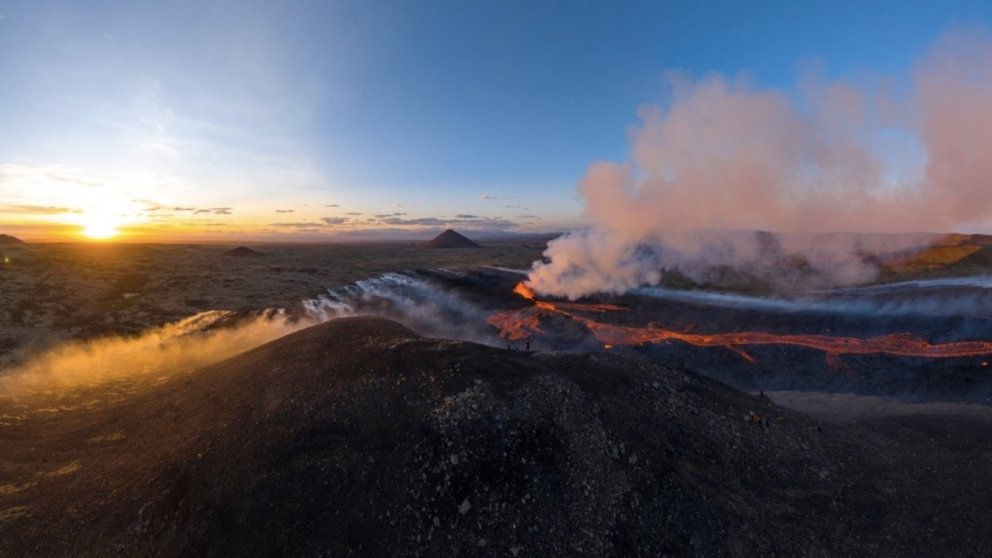
All active webcams from the eruption by Sundhnúksgígar in one place.
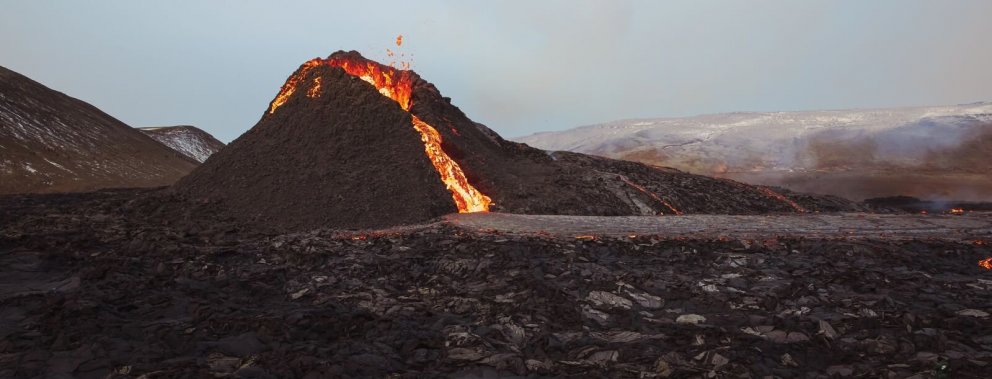
Here you can find images from the eruption site that we combined in a gallery

CHARLIES WANDERINGS
THE TRAVEL BLOG FOR HIKING LOVERS AND EFFICIENT TRAVEL ITINERARIES

Adventure Travel · August 23, 2021
2022 Fagradalsfjall Hiking Trail – How To Visit The Active Volcano in Grindavik Iceland
The floor is lava!!! That’s pretty much what went through my mind while starting our hike towards Fagradalsfjall. Besides that some other things also flashed through the back of my mind.
First of all… Why was I feeling so damn excited about walking towards something so dangerous and deadly? I also regretted not bringing any marsh-mellows and somehow I got stuck with the tune of “Dumb ways to die”.

But, in contrary of what I just said, the hiking trail towards Fagradalsfjall is actually very safe and at all times you’ll be at a distance of approximately 3km from the actual lava spewing crater.
In this guide I will tell you exactly how to reach the best viewpoint over the active volcano near Grindavik and how to prepare your hike. The volcano isn’t always visible and at times it’s also not spewing lava. But with this guide you’ll never end up disappointed at the end of your hike . Instead you’ll leave with an incredible and once in a lifetime experience!
A day hike to the Fagradalsfjall Volcano should definitely be on your itinerary if you’re doing a Summer road trip in Iceland !
Needless to say, this is one of the most impressive and best one day hikes in entire Iceland at the moment!
The Fagradalsfjall Volcano in Reykjanes is currently erupting again, after 8 months of being dormant.
Keep on reading for all the latest info on how to reach the new eruption site from August 3rd.
🎫 WITH A TOUR
Fagradalsfjall hiking trail – how to visit the active volcano in grindavik iceland.
Let’s be honest, it’s not every day that you get to see an actual lava spewing volcano right? One would think that in most cases actually you would run as fast away as possible from it. But that’s not the case with the Fagradalsfjall volcano. Ever since its eruption in March 2021 it has been attracting adventurous and curious locals and tourists. And now it’s actually one of the top attractions and top things to do in Iceland!
And it’s not the first time either that an active volcano puts Iceland even more on the tourist map. Iceland used to be a rather unknown country, one that wasn’t frequently visited and often ignored when planning a holiday. All until 2010 when the absolutely unpronounceable Eyjafjallajökull erupted. The eruption of Eyjafjallajökull, also referred to as the E15, caused absolute mayhem for air travel across Northern and Western Europe. But it also put Iceland on the tourist map all over the world.
Over time more and more movies and tv-shows were recorded in the otherworldly landscapes of Iceland , one of the last ones being Game of Thrones. And so over time Iceland became a bucket list destination for people all around the world .
And honestly, I can’t even blame them. I’ve visited Iceland now 3 times and I would still go back in a heartbeat. Every time that I leave I already start dreaming about my next journey through the land of ice and fire.
But enough of that, let’s start with giving you all of the information you’ll need to visit the Fagradalsfjall volcano.

Planning your trip to Iceland
🏨 Find the best accommodations on Booking.com 💰 Get reliable travel insurance from World Nomads 👩 Find a reliable tour guide, such as this 5 hour guided tour to Fagradalsfjall from Reykjavik
🚘 Rent a car to travel around Iceland with SunnyCars.com 🎒 Pack a power bank , hiking shoes and trekking poles . 📚 Read How Iceland changed the world , Lonely Planet’s Iceland and Nordic Islands by Stefan Forster

🗓 When to visit the Fagradalsfjall volcano in Geldingadalur
The Fagradalsfjall volcano has been active ever since its eruption in March 2021 until September of that same year. But on August 3rd 2022 a new volcanic eruption could be seen in the Reykjanes peninsula.
For the first time since September 2021, when lava stopped running from Fagradalsfjall, the tension has given a way for the magma to burst through.
However, there are a few things to keep in mind and to look at before you start your hike.
First of all, Iceland is a very temperamental country when it comes to its weather. One day it can be sunny and the next day it be entirely covered in clouds. So it might be possible that when you reach the end of the hiking trail that there is zero visibility . Since the hiking trail towards Fagradalsfjall isn’t the easiest it’s better to avoid such disappointment.
Preparation is definitely key when it comes to visiting this volcano!
Another website to check is volcanoweather.is . This one will give you a more general idea of the current weather circumstances.

🚘 How to reach the Fagradalsfjall Hiking Trail
The start of the Fagradalsfjall hike is close to Grindavik on the Reykjanes Peninsula . This is the same peninsula where the international airport is located so it’s most convenient to combine your visit to the volcano with your arrival or departure to Iceland.
There are actually 3 different trails that lead to the volcano but only one of them has a good view over the active crater. While at the start of the eruption in March 2021 you had to follow hiking trail B, now you have to follow hiking trail C which will lead you to two different viewpoints .
One of them is viewpoint N which offers a view over the massive lava field in the valley, the other one is viewpoint L which is higher up the mountain and will grant you a spectacular view over the crater.

🚗 BY CAR/ CAMPER VAN
If you’re coming from the airport you’ll first drive through the centre of Grindavik after which you make a left onto the 427. Keep on following this road for a couple of minutes and after a while you’ll see a first parking lot but that’s not the one you want. Instead keep on driving down the road until you see another large parking lot on your left! This is the one where hiking trail C starts.
There’s a small parking fee of 1000IKR since to parking is located on private property.
There’s a bus that leaves from the centre of Grindavik to the eruption site. It operates daily and the first bus leaves at 8am and the last one returns at 10pm.
There are several tours that will take you to the Fagradalsfjall eruption site and I’ve listed my favorite ones below:
- A 5 hour guided tour to Fagradalsfjall from Reykjavik
- A guided hike to the active volcano from Reykjavik
- Hike to the active volcano and a tour of the Reykjanes Peninsula from Reykjavik
- From Reykjavik: Active volcano hike and Blue Lagoon

🥾 Fagradalsfjall Hike Details
Hike Distance – The total hike distance to the viewpoint of the crater and back to the parking lot is 9km (or 5.6 miles).
Hike Duration – In total you’ll probably spend 2 to 3 hours , depending on how many time you’ll stop to take photos. As a reference for me it definitely was 3 hours.
Hike Difficulty – The start of the hike is easy and flat but after passing the lava field it becomes more and more strenuous. You’ll have to climb several hills and at times the incline will be very steep. The trail consists of loose gravel, rocks and small boulders. If you have trekking poles with you they will for sure come in handy and make sure to wear proper hiking shoes , preferably with ankle support.
Hike Incline – The total incline of the hike to the Fagradalsfjall viewpoint is 300 meters .

🌋 How to reach the new Meradalir volcano eruption site
So the most recent eruption that started on August 3rd 2022 actually occurred in a lava field created by last year’s eruption in the neighboring valley.
But compared to the Fagradalsfjall eruption site, the Meradalir eruption site is a lot harder to get to . Whatever you do, DO NOT TAKE A SHORTCUT ACROSS THE OLD LAVA FIELD ! Although the sides of it may seem completely hard, it sometimes happens that it transforms again in a sea of molten lava and this phenomenon can happen in just a few seconds.
The hike to the new eruption site is 7km one way and has an elevation of a 300 meters . The route is on very hard terrain and up very steep hills close to the crater. The hike itself can take around 4-5 hours at least.
The hike to the sightseeing platform where the crater is visible is about 5 km (3 miles) one way, it is best to park your car at parking lot #1 and hike route A and continue over the terrain, towards the new eruption site.

Follow instructions from the local authorities and the ICE-SAR members on site . The area could be closed with short notice.

🙋🏼♀️My Experience on the “Fagradalsfjall Hiking Trail”
After weeks of stalking the live cam on Youtube the day had finally arrived! We landed in Iceland around 3pm and after picking up our 4×4 camper van from Happy Campers we set off on our first adventure in Iceland.
I quickly checked the live cam and the seismograph one last time and everything looked good to make it an unforgettable evening! We parked our van, jumped out of the car, forgot our water bottle out of pure excitement and started walking along the trail.
Out of the corner of my right eye I had already spotted a small food truck and I could already taste my first Icelandic hot dog of this trip. But first things first: hiking up to see the active volcano with my very own eyes.
The trail started on a dirt road made of gravel and yellow sand but we couldn’t see anything yet in the distance. The only thing we saw were the stars in the eyes of the people returning from their visit of the crater. They looked like they had the time of their life and I started to accelerate my pace.

After 15 to 20 minutes walking my mouth fell to the floor for the very first time. We had arrived at viewpoint N and the floor was actually lava ! To reach the valley of cold lava we would have to make a small detour so I decided not to risk it and visit it after witnessing the crater. According to the seismograph the volcano would remain active for a while longer but nevertheless I wasn’t going to take any chances!

After admiring the lava field from afar we started hiking up the first hill. The gravel was slippery at times and the incline steep. At one side there was a rope where people were holding onto when shuffling back down. Needless to say that you’ll need proper hiking shoes when starting this hike ! Besides our water bottle I had also left my trekking poles in the car. Something I would later on come to regret a lot, especially when hiking back down.
But after reaching the first top we could already see the crater in the distance. Bright orange lava was being sprayed into to dark grey air leaving a hazy glow behind. I immediately took out my camera and started taking photos.

I felt the adrenaline rushing through my veins and didn’t even care about my throat that now started to feel like dried up parchment. We had a couple more hills to climb but every single one brought us closer to this fiery wonder. After every incline the crater came closer and the lava glow became intenser. Until we finally reached viewpoint L and our mouths literally fell open.
There it was, in all of its glory. I had been staring at it through a screen for the past weeks but nothing and I really mean nothing could have prepared me for this very moment. I felt so small and insignificant but at the same time also very grateful that I was lucky enough to see it with my very own eyes.
You can imagine that what happened next was a very elaborate photoshoot!

After spending at least an hour admiring the crater from all possible angles we decided to hike back down. I didn’t fly my drone at the time because the wind gusts felt too strong and after crashing my previous one I didn’t want to risk it ending up in the lava on its very first international flight.
In hindsight I truly regret it but oh well, so be it!
We started hiking back down and decided to now take that short detour to the lava field. It was only when we came closer to it that we realized its magnitude. This wasn’t just a layer of dried up and cold lava. This was a massive thick layer of nearly 2 meters and it looked like something that didn’t even belong on planet earth.
Realizing all of this magma came streaming down only a couple of months ago completely blew my mind and the textures it left behind were incredible.

After our adventure it was time to head back to our camper van and to my surprise the food truck was still very much open! Time for that first Icelandic hot dog, followed by chugging down a gallon of water and heading towards our campsite nearby in Grindavik.
In the far distance I could still see the orange glow in the sky and with a heart filled with utter joy I fell sound a sleep after only 5 minutes.
🏨 Where to stay when visiting the active volcano in Iceland
If you’re traveling by camper van the closest campsite is the one in Grindavik . The facilities are clean and it’s only 15 minutes driving from the eruption site.
Another option is to already drive towards the capital Reykjavik . The campsite here is a little more expensive but does have more facilities. The only downside is that if you arrive after opening hours you have to have your tickets booked in advance or you can’t enter anymore.
If you prefer staying at a hotel these are my personal favorites:
- Northern Light Inn – This cute cottage style hotel is located in Grindavik and only 15 minutes away from both the eruption site as the Blue Lagoon.
- Eyja Guldsmeden Hote l – This stunning and originally decorated hotel is located right in the heart of Reykjavik and right next to its main shopping street.
- Hotel Borg by Keahotels – This hotel screams lavish luxury but is also understated with it’s black, white and grey design. It’s the perfect place to stay if you want a more luxurious start or end of your trip.

DON’T WANT TO DO THIS HIKE ON YOUR OWN?
You can join a tour to see the Fagradallsfjall volcano and admire its beauty without having to plan anything yourself. Embark on a magical afternoon or evening tour through Geldingaladur Valley and see the eruption site in Meradalir Valley next to Fagradalsfjall Volcano alongside a licensed guide.
🧳 Iceland Hiking Packing List
A lot of people come to Iceland unprepared for the cold, especially during the Summer months. While it can get warm on a sunny day you also need to be prepared for the cold and typical Icelandic wind. For instance, when we were hiking up this mountain I was sweating a lot but the wind was so cold and so harsh that I had to wear a bonnet to keep my ears warm and pain free.
Below are some items that you definitely want to bring with you if you’re planning an adventurous trip to Iceland .
Hiking shoes – You will definitely need a pair of these. Even that some attractions are located right next to a parking lot you’ll pretty much always have to hike over a rocky terrain. I love my Meindl Mountain Trail Boots for longer hikes and my Danner Mountain Light Boots for daily wear and shorter distances.
Trekking poles – These will especially come in handy cause a lot of the hikes in these guide can be rather strenuous on the joints. I used the Leki Adventure Light trekking poles for all of my hikes in Iceland!
Back Pack – You’ll want to bring a back pack with you to carry your camera, some snacks and your refillable water bottle. I love the Kanken No. 2 back pack from Fjallraven and pretty much take it with me everywhere I go.
Refillable Water Bottle – The water in Iceland is some of the freshet in the entire world so there’s no need at all to buy plastic bottles. Simply find the nearest stream to fill up your bottle and you’re good to go.
Another option is to use a back pack which has a water reservoir built inside of it. For instance this 3L Hydration Bladder is leak proof and can be stored inside a back pack.
Trail Leggings – I love hiking in leggings and have lately been loving the Abisko Trail Tights from Fjallraven.
Fast Drying Shirt – When hiking you tend to sweat, especially when climbing a mountain. One of the best things to wear is a shirt that quickly dries so you don’t get cold high up the mountain.
Insulating Jacket – Depending on the temperature you’ll either want a thicker or lighter jacket. If it’s pretty cold outside I always go for my Fjallraven Vidda Jacket . Otherwise I go for their High Coast Light Jacket which is super light weight.
Woolen cap – The perfect accessory to protect your ears from the cold and to cover your hair after a few days without a shower.
Protein Bars – Make sure you have a couple of these stowed a way in your back pack to boost up your energy level during the hike.
Sunscreen – Make sure to re apply to your face regularly cause pretty much all of the hikes that we did in Iceland were exposed most of the time. I love this one by Neutrogena which feels like a face mist but also provides SPF 50 protection!
Merino Wool Socks – My go to brand has always been Falke and I love how fast they drive after a long day of hiking. Plus since they’re made of merino wool they don’t smell and can be worn for a couple of days.

❗️Essential tips for hiking in Iceland
- Wear sturdy hiking shoes , preferably mountain trail shoes. A lot of the trails can be rocky and uneven and you don’t want to loose your balance. For longer hikes I always wear my Meindl Borneo Lady Boots and for shorter ones I switch to the Danner Mountain Light .
- Pack for 4 seasons : even in the Summer months it can be very cold if you start hiking in the early morning. Make sure you’re wearing layers so you can easily take something off or put on an extra layer if you’re taking a break.
📖 CLICK HERE FOR MY COMPLETE CAMPER PACKING LIST
- Make sure to arrive early at the most popular hiking trails to ensure you have the best experience.
- Bring a small first aid kit with you. You can always hurt yourself during a hike and it’s important that you’re able to disinfect wounds as fast as possible.
- Almost all of the hiking trails are well marked but make sure to plan your route on maps.me as well .
💸Iceland Travel Insurance
I highly recommend you to get a travel insurance before your trip cause the risks are never worth the costs. If you’re going on a more adventurous trip you can always get yourself injured! So far I have sprained my ankle in Jordan, got food poisoning in India, turned snow blind in the Dolomites and have fallen multiple times during many hikes. It’s always best to be safe than sorry in such cases and with a good travel insurance you don’t have to worry about medical bills piling up.
I personally love World Nomads , their prices are affordable, their coverage is great, and they also offer 24/7 on-call customer service! When I got super sick in India they even covered an extra night for me at the hotel that I was staying it and rearranged my flight home at no extra cost!
📸 My Iceland Camera Gear
- Canon EOS 6D Mark II – My go to camera body for the past 3 years
- Main Lens – Canon EF 24-70mm f/2.8L II
- Zoom Lens – Tamron AF 70-300mm f/4.0-5.6
- Wide Angle Lens – Canon EF 16–35mm f/2.8L III
- Tripod – Manfrotto Tripod
- Drone – DJI Mavic Mini 2 Fly More Combo
You can find my complete list of photography gear here
📚 More Iceland Blog Posts
I have visited the land of ice and fire 3 times in 3 years and I loved adventuring and driving around the country. On my blog you can find a ton of free resources to help you plan the perfect trip to this beautiful c ountry.
Below are some of my favorite articles and there’s a lot more to come so keep an eye on this space!
- The Most Beautiful Waterfalls in Iceland – A list of the most beautiful waterfalls in Iceland that I visited myself, divided by region.
- The perfect winter road trip in Iceland – A day by day guide and retelling of my first time visiting this beautiful country.
- Hidden Gems in Iceland – Of the beaten path places that haven’t been discovered by mass tourism.
- Fagradalsfjall Hiking Trail – How To Visit The Active Volcano in Grindavik Iceland
- 1 Day in Landmannalaugar – The Mount Blahnukur Trail
- Discover Thakgil – A hidden gem in southern Iceland
- Mulagljufur Canyon – Discover a true hidden gem in South Iceland
- 7 Best Places To See in The Highlands in Iceland
- Kerlingarfjöll Hiking Trail – How To See The Hveradalir Geothermal Area in a couple of hours.

Charlotte Lint is the founder, main photographer and writer of Charlies Wanderings . She has traveled all over the world and is based in Belgium where she also owns her very own dental practice. She is an expert on writing insightful hiking guides and creating unique and efficient travel itineraries . Every month she helps over 134.000 people discover the most beautiful places in the world through her detailed travel guides.
You’ll Also Love

Leave a Reply
You must be logged in to post a comment.
DESTINATIONS
TRAVEL ITINERARIES
TRAVEL WITH KIDS
Charlies Wanderings is a travel blog for unique travel itineraries and hiking guides with colorful photos and insightful travel info.
COPYRIGHT ©2024 CHARLIES WANDERINGS
Copyright © 2024 CHARLIES WANDERINGS Theme by 17th Avenue
Copyright © 2024 · Charlotte on Genesis Framework · WordPress · Log in
About Iceland
Visa information, geography of iceland, general information, the northern lights, volcanic eruptions, sustainable travel, iceland academy, plan your trip, how to get there, accommodation, things to do, map your journey, getting around, visitor numbers, carbon footprint, destinations, the regions, scenic routes, national parks, trip suggestions, towns & villages, inspiration, food and beverages, lbgt+ travel.
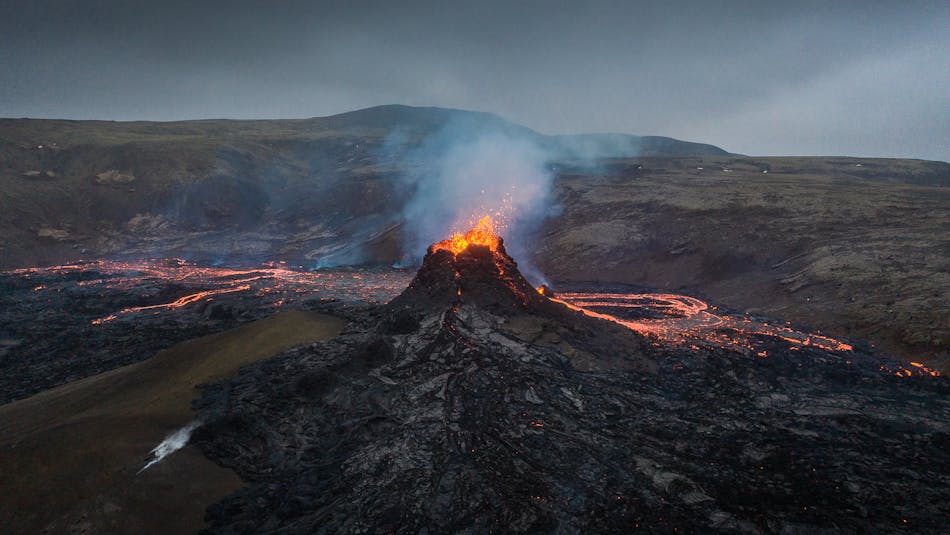
Fagradalsfjall volcano in Iceland started erupting on March 19, 2021 and erupted for six months. Although the eruption is finished, it's still stunning to see the new lava fields and craters created by the eruption up close.
Fagradalsfjall in Iceland erupted in 2021 - revealing its deep roots
The restrained Icelandic volcano Fagradalsfjall on the Reykjanes peninsula stepped into the spotlight on the evening of March 19, 2021, when an eruptive fissure opened in the Geldingadalir valleys.
It had been quiet for over six thousand years and is the first active volcano in the Reykjanes UNESCO Global Geopark area for 800 years.
Some frequently asked questions are: Did it come as a surprise, or did scientists see any precursors? When did the eruption start and how long did it last? Why was it called a tourist eruption? Is it possible to come and see the eruption site? What are the latest developments of the Fagradalsfjall volcano?
Here we try to answer those questions and discuss the geological history and characteristics of the Faradalsfjall eruption and the likelihood of continuation of events in the near future.
Three weeks of shaking

The Icelandic musician Eliza Newman who lives close to the Fagradalsfjall volcano wrote a song about the eruption.
Three weeks prior to the volcanic outbreak, an intense earthquake episode began on the Reykjanes peninsula near Fagradalsfjall mountain. It started with an M5,7 earthquake that stirred people in large parts of Iceland.
In the following three weeks, we had more than 40.000 earthquakes. However, most of them were small and unnoticed, but several were large enough to leave people in the neighboring town Grindavík and the Reykjavík capital area sleepless. One of them was the musician Eliza Newman , and as expected, she wrote a song about it Fagradalsfjall (you're so pretty) , just as she did when the notorious volcano Eyjafjallajökull erupted in 2010.
Waiting with anticipation
Our most experienced geoscientists from the University of Iceland and the Icelandic Met Office interpreted geophysical data from seismometers, GPS stations, and satellites. They concluded that a rapid crustal uplift produced the earthquakes.
Furthermore, it was clear to them that a magma dike intrusion was the cause. During the three weeks of shaking, the dike was steadily propagating at both ends, and the magma intruded further up in the crust.
The question everyone was asking was: Will it erupt?
As the dike grew, anticipation increased, but it was impossible to predict whether the 8 km long dike would manage to touch the surface and end in an outbreak or by freezing in the crust as most basalt magma intrusions do.
It’s Oh So Quiet - And so peaceful until
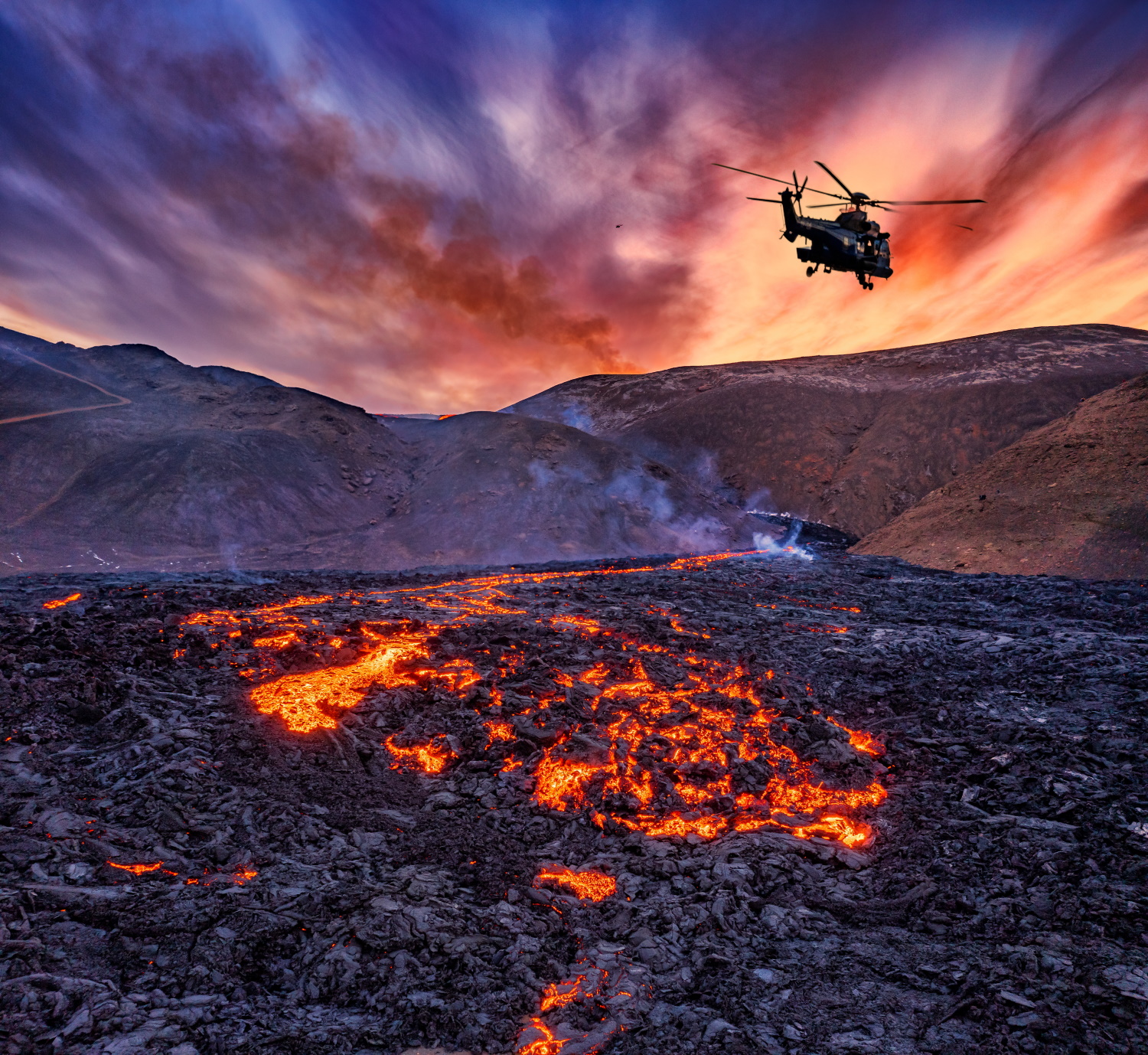
Helicopter hovering over the flowing lava from Fagradalsfjall eruption in 2021
The earthquakes finally stopped, and everything was quiet for three days. But on a Friday evening, at 20:45 on March 19, 2021, people in Grindavík town and elsewhere on the Reykjanes peninsula reported a glowing light in the sky. No eruption tremor was detected, so the only way to confirm if an eruption had started was to have a look.
Later in the evening, scientists onboard a Coast guard helicopter confirmed that an eruptive fissure had opened in Geldingadalir valleys. However, they described it as a tiny eruption, far from populated areas, and not expected to threaten people or properties.
A typical "tourist" eruption
The eruption has been described as a "tourist eruption," a term commonly used by Icelanders for minor eruptions that can easily be accessed. Of course, the usual thing to do when a volcano erupts is to get as far away as possible. But in Iceland, the "usual" response is the opposite. So Icelanders started flocking to the eruption site to look at the spectacular show nature was offering.
The eruption site turned out to be pretty safe with the proper precautions of avoiding the hot lava and gas. The Icelandic voluntary search and rescue teams also immediately showed up to ensure safety at the site, and their valuable work continues while the eruption is ongoing.
So how big is the "tiny" eruption?
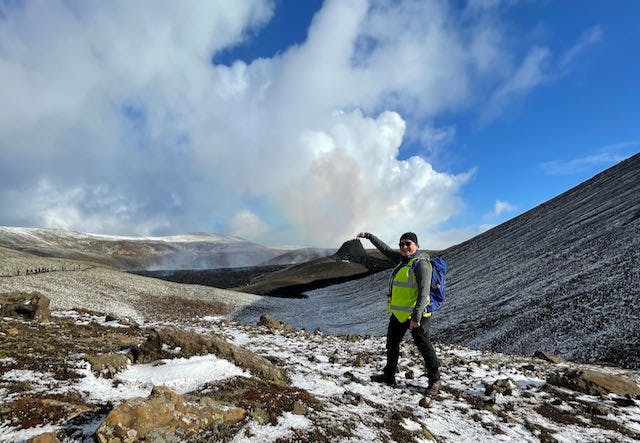
The fissure that first opened was estimated to be 180 m (600 ft) long. The lava flow was soon concentrated in two craters that erupted continuously. There was no explosive activity producing ash plumes, as happened in the Eyjafjallajökull 2010 eruption, causing a shutdown in air traffic over Europe. In this case, the eruption turned out to be an effusive fissure eruption, producing a steady outflow of basaltic lava of about 6 m3 and releasing volcanic gases.
After a few weeks, new fissures formed and new vents started to open while others became inactive. At one point, six craters were erupting simultaneously.
The three faces of Fagradalsfjall
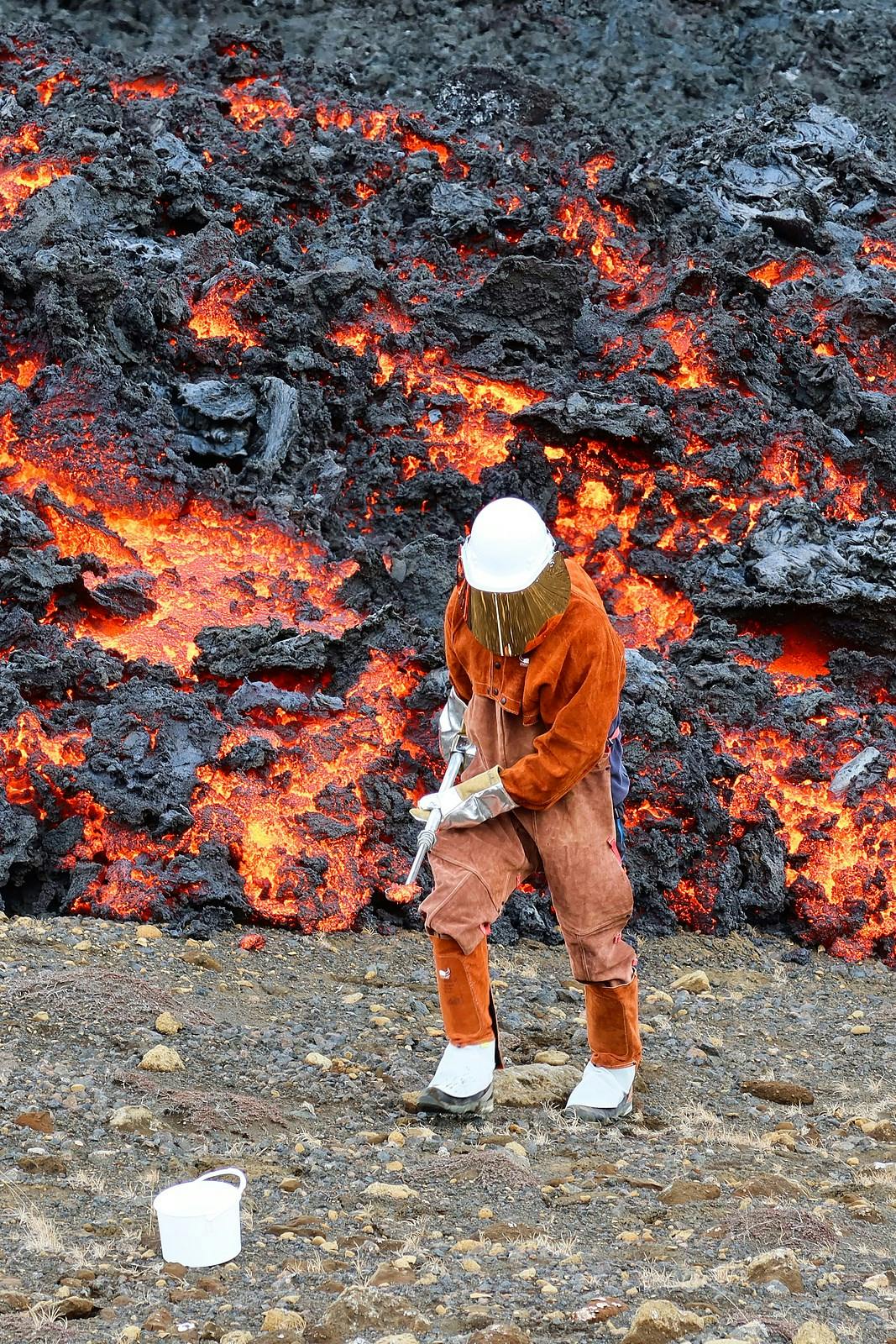
A geologist sampling magma for geochemical analysis
The eruption changed phases regularly for most of the time it has was ongoing. The activity was characterized by periods of (1) pulsating activity with fire fountains, (2) steady outflow of lava, and (3) quiet periods where no activity was seen on the surface or the tremor graphs.
The timespan of each phase varied from hours to days. It is unclear what was happening in the quiet periods; if the eruption was paused or continued below the surface in lava tunnels, but the former is thought to be more likely. Now there has been a pause since September 18, 2021 and the eruption has been officially declared finished by authorities.
Updated figures and maps
The Institute of Earth Sciences at the University of Iceland regularly updated data from the monitoring of the Fagradalsfjall eruption . On September 18, after six months of eruptive activity, the volcanic activity was concentrated in one large crater with a periodic outflow of lava of about 10-12 m3/s. But the day after it paused and has been in a quiet phase since but continues some emission of volcanic gasses.
The eruption built up a small lava shield that covers 4,85 km2 and the volume is estimated to be about 0,15 km3. *
The Icelandic Institute of Natural History has created a 3D map of the Fagradalsfjall area .
* Numbers from October 1, 2021
Latest developments - Will an eruption break out again?
The eruption paused on its six-month anniversary on September 18, 2021, but 9 days later, on September 27, a new earthquake episode began at the northern end of the magma dike that formed in February-March, about 5 km north of Fagradalsfjall.
Most scientists believed that the magma was trying to find a new way out since the former feeding vent collapsed. Geophysical data indicated that a new magma dyke formed beside the old one, but this time didn't manage to reach the surface and the episode ended after three weeks.
The area is still thought to be active and magma may be accumulating at depths without being detected, so it will be exciting to see if and when the next dyke starts to form and if we will witness another outbreak in the area in the near future.
Visiting the volcano
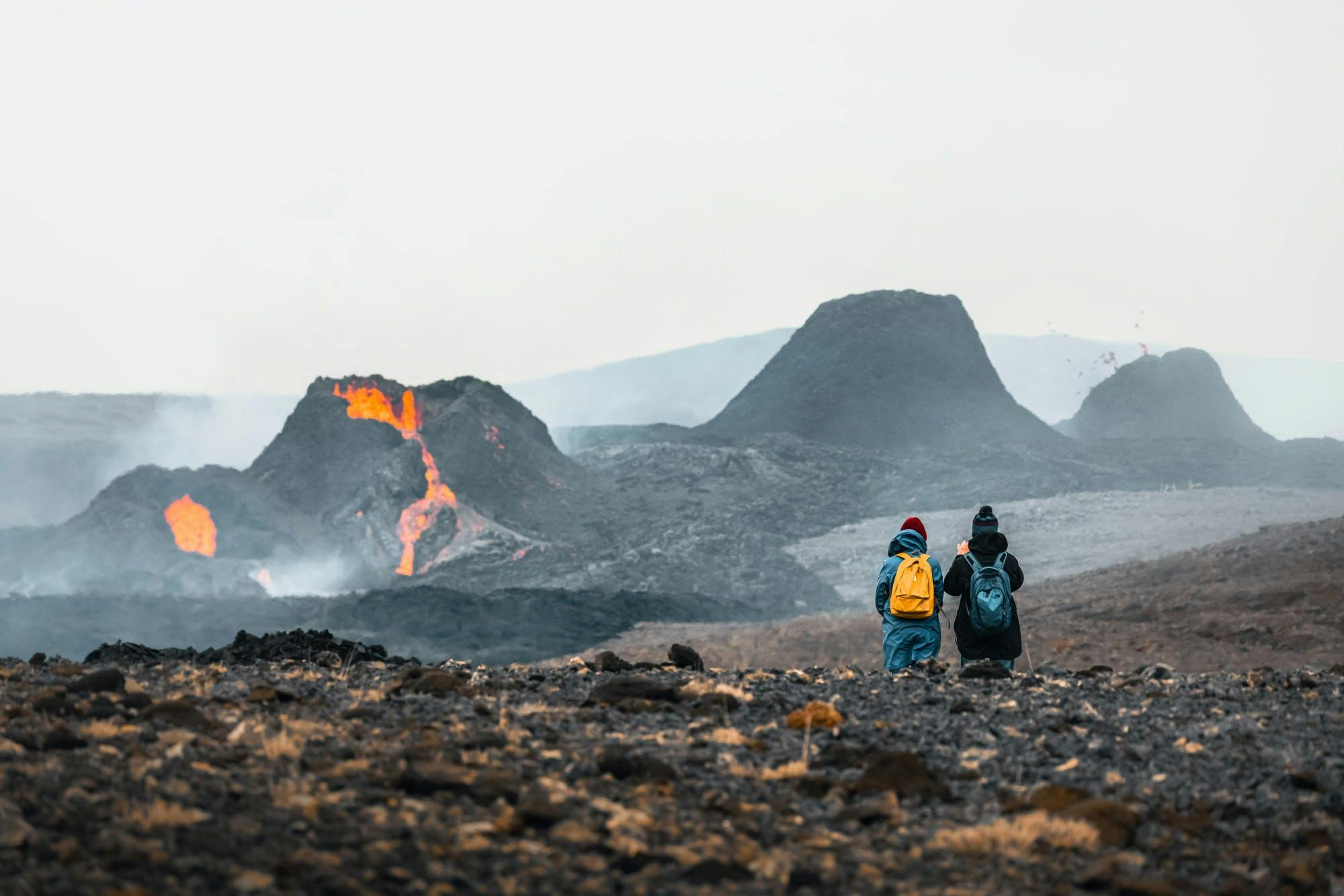
Icelanders started flocking to the eruption site to witness the spectacular show nature was offering.
If you are interested in coming to Iceland to visit the volcano, you might want to stay for a few days to improve your chances of good weather and visibility.
Even though the volcano is quiet, the magnificent crater and the freshly made lava formations are a spectacular sight on their own and a popular destination. Below you can find links to articles on preparation and how to get there.
And even though you miss this one, one of Iceland's other active volcanoes and volcanic systems that show signs of unrest, is likely to erupt within the following couple of years.
Get inspired
You might also be interested in:
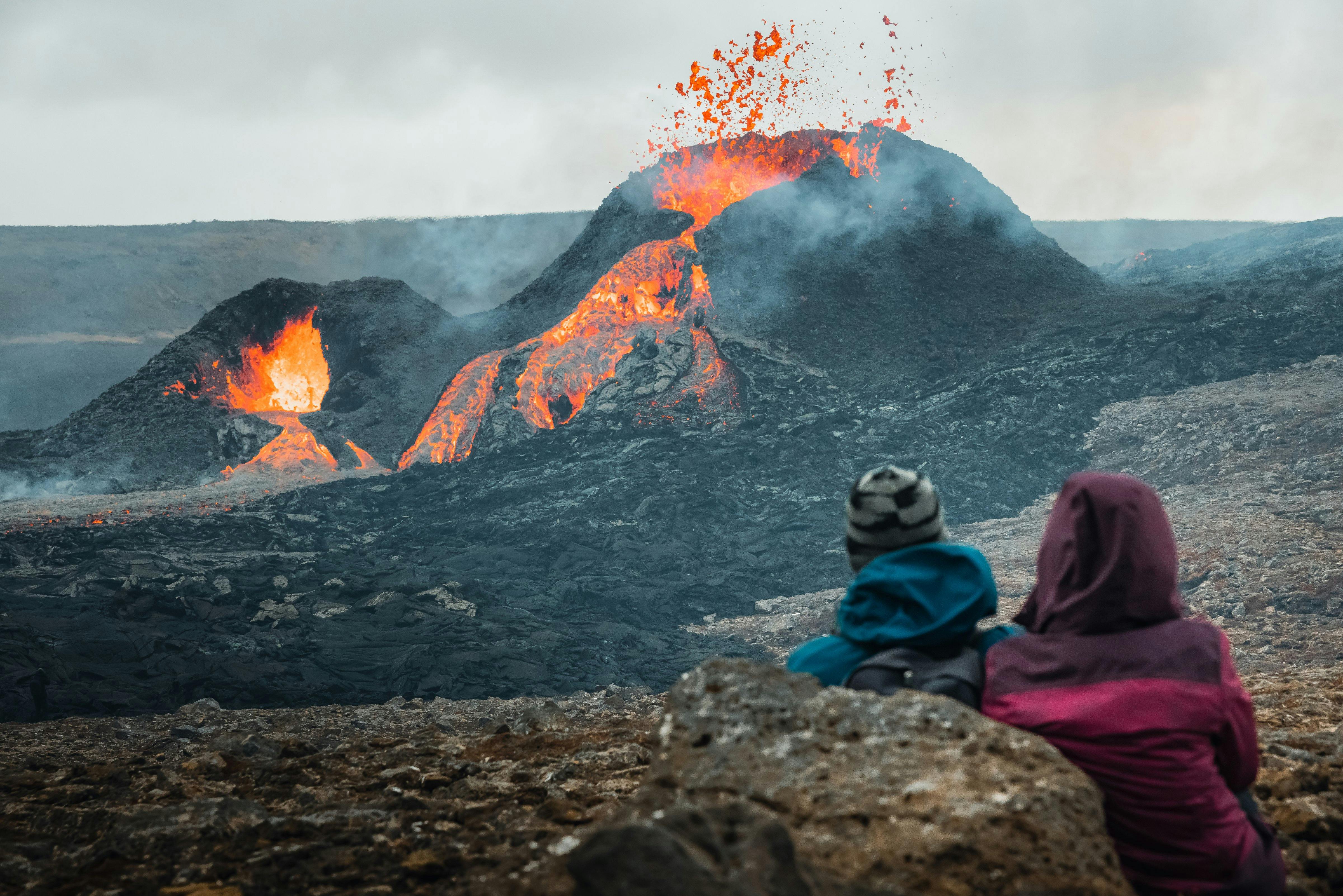
Safety at Fagradalsfjall eruption site
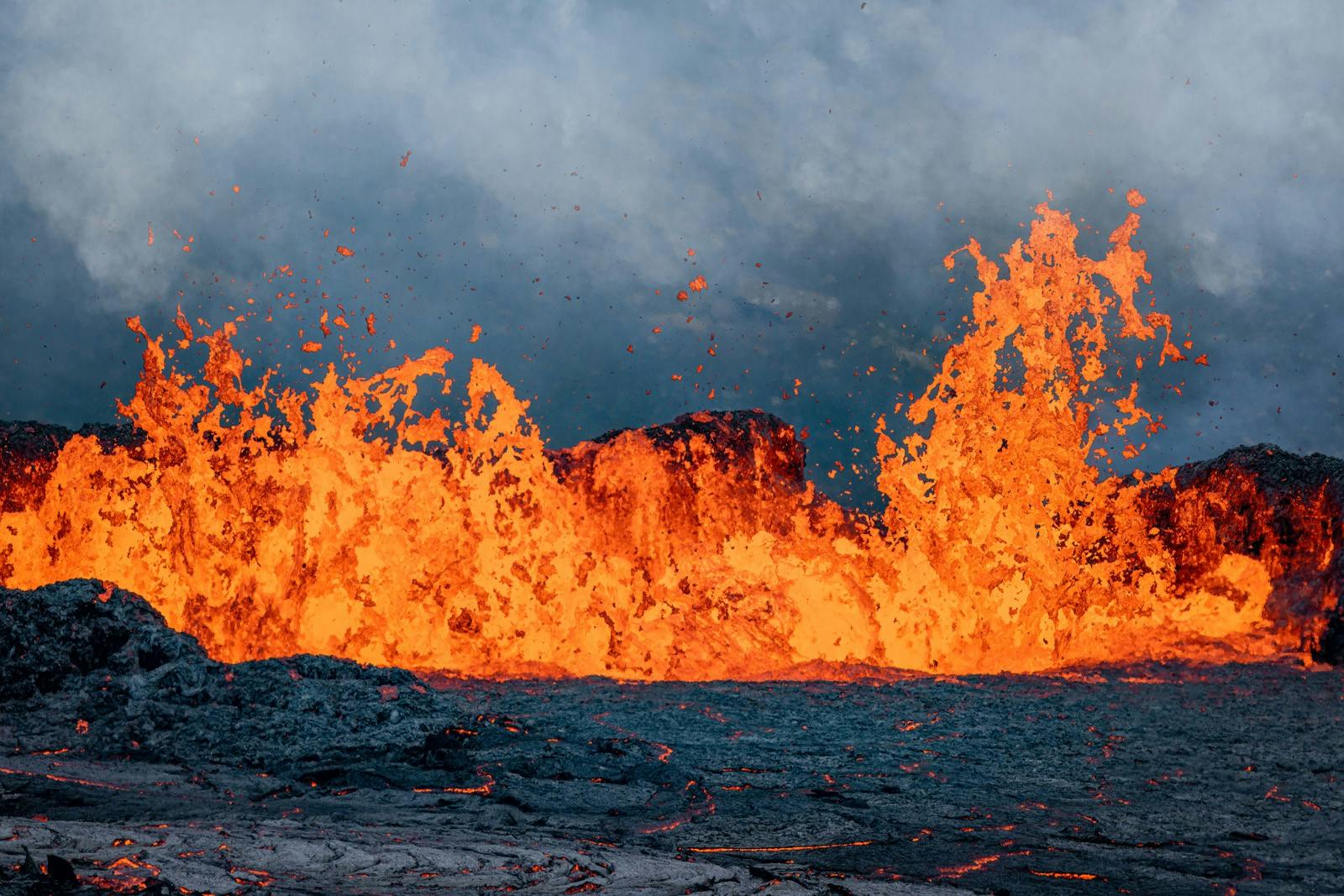
2022 Fagradalsfjall Volcano guide for hikers
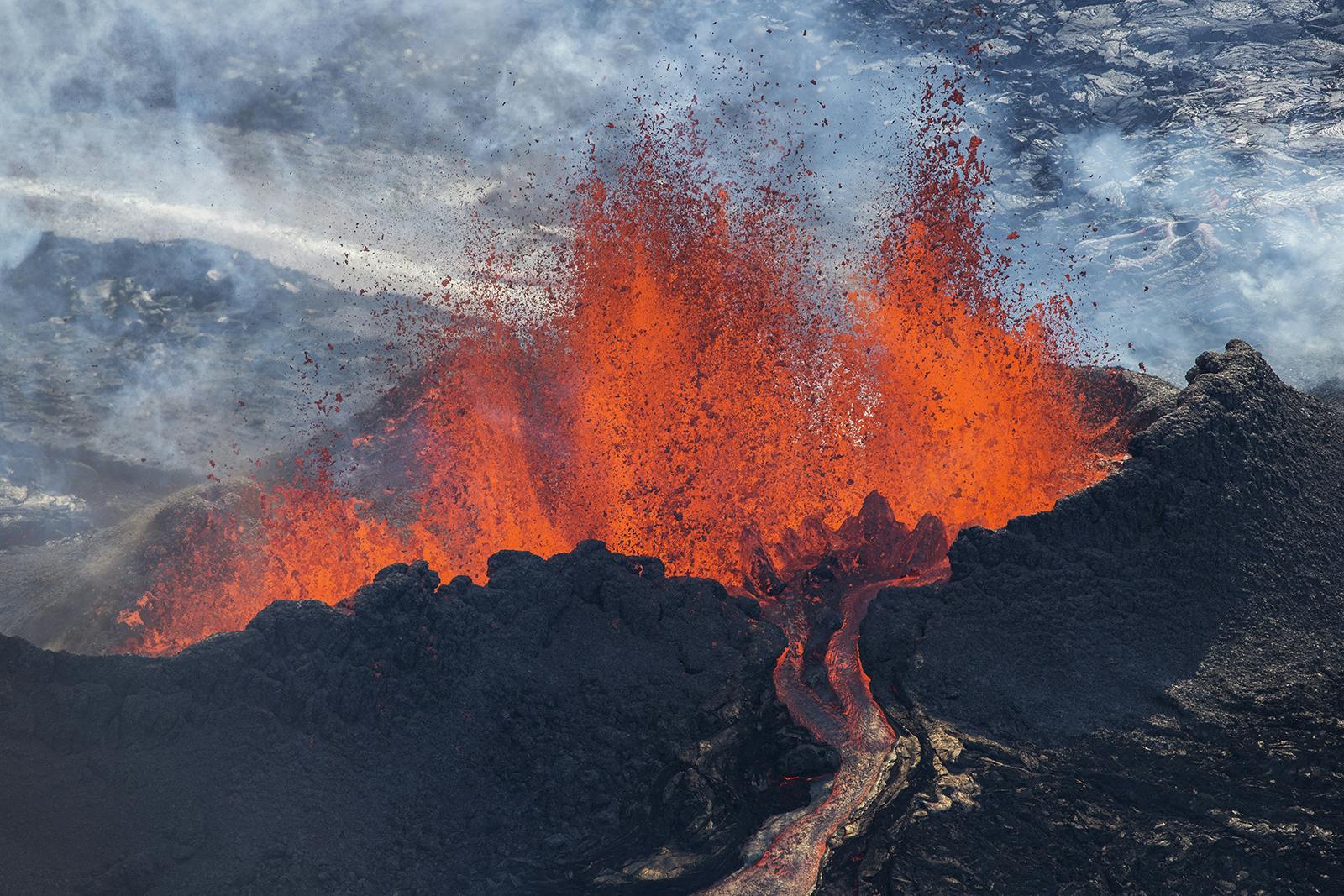
Volcanos of Iceland
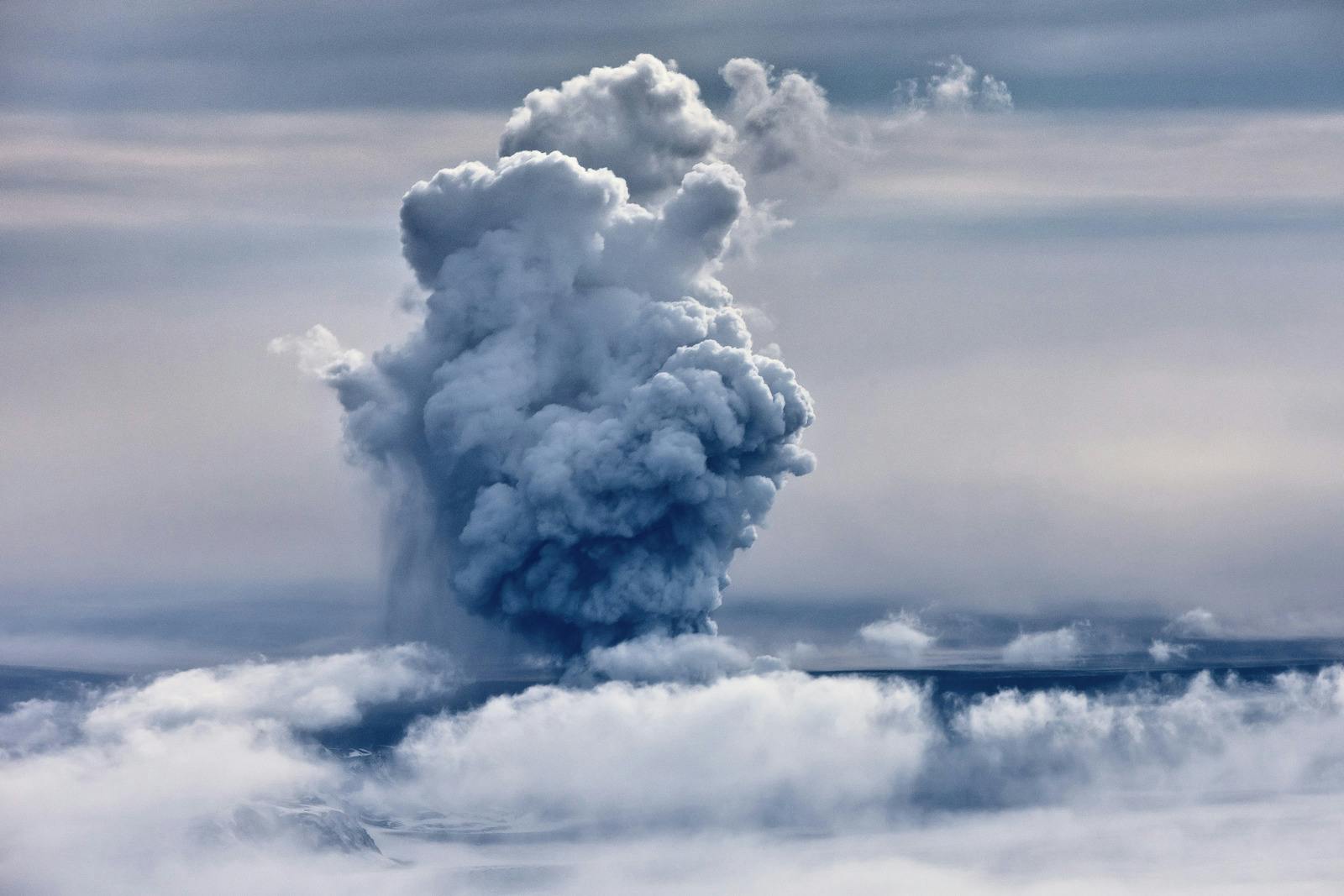
The 2011 and 2004 Grímsvötn eruptions
The 2014 holuhraun eruption.
- Share full article
Advertisement
Supported by
Volcano Erupts in Iceland, Spewing Lava 150 Feet Into the Air
Guests staying at the Blue Lagoon spa and surrounding hotels were ordered to evacuate hours before the eruption occurred.

By Egill Bjarnason
Reporting from Husavik, Iceland
A volcano in southwestern Iceland erupted on Wednesday for the fifth time since December, cracking the Sundhnjukar mountain ridge open with spectacular force and sending lava spewing 150 feet into the air.
The meteorological office said it received indications of a possible eruption about two hours before it occurred at 1 p.m. local time in Grindavik, prompting the civil defense agency to immediately urge guests at the Blue Lagoon — the geothermal spa that is one of Iceland’s most popular tourist destinations — to evacuate.
“Evacuate, Evacuate!” read a text message sent to the nearly 800 guests staying at the Blue Lagoon and surrounding hotels. Civil defense sirens installed in February rang out as visitors scrambled to leave.
Within minutes of the eruption, drivers traveling the highway to Keflavik Airport posted pictures of the nearly two-mile-long fissure at Sundhnjukar. A large column of smoke was visible from Reykjavik, the capital.
Helga Arnadottir, a spokeswoman, said that this was the fifth evacuation order since the volcano first roared back to life last year. The evacuation went as “smoothly as the ones before,” Ms. Arnadottir added. Hotel guests took about half an hour to evacuate, she said.
Another 300 people had to move from Grindavik, a fishing town that has largely been abandoned since January after lava and earthquakes from previous eruptions destroyed parts of it. The government has offered to buy all residential homes in Grindavik to allow residents to resettle elsewhere. Nearly all property owners in the area have opted to sell.
Iceland’s tourism board urged people not to try to get close to the eruption and was quick to note that the country remained a safe destination. The island nation’s economy relies heavily on tourism; airlines and travel agencies have reported a drop in sales since the eruptions began in December. Keflavik Airport reported no disruptions to flights on Wednesday.
While the eruption occurred with little notice, scientists had predicted that another volcanic event would happen after the last eruption three weeks ago.
Magnus Gudmundsson, who was among the first volcanologists to fly over the site, told The New York Times that the fissure at Sundhnjukar appeared to have grown. By Wednesday evening, lava had reached the barriers surrounding Grindavik that had been put in place to redirect the flow away from the town.
“We watched the fissure widen and a heavy stream of lava running south” toward Grindavik, Mr. Gudmundsson said. Parts of the main road were destroyed. The volcano has already produced 2.1 square miles of lava, Mr. Gudmundsson added, “a good amount.”
- EO Explorer

- Global Maps
Iceland Eruption Goes Another Round
June 2, 2024 JPEG
A volcanic fissure on Iceland’s Reykjanes peninsula reawakened in late May 2024. This eruption, the latest in a series that began in December 2023, was notable for its vigorous start. Some of the highest estimated lava flow rates of all the recent eruptions near Grindavík occurred in the first hours of the eruption.
The OLI (Operational Land Imager) on the Landsat 8 satellite captured this image of the ongoing eruption on June 2, 2024. The natural-color scene is overlaid with an infrared signal to help distinguish the lava’s heat signature. By this time, volcanic activity along a fissure extending up to 3.4 kilometers (2.1 miles) long had subsided after its initial burst. The most active areas, emitting the hottest thermal signals (light green), are near one of the craters that erupted in March 2024, according to the Icelandic Met Office (IMO). Much of the black area in the image is cooled lava, but note that dark shadows from clouds are also present.
Models indicated that 18 million cubic meters of magma had accumulated beneath the fissure since the March eruption, the IMO reported. This was the largest volume of magma to build up in the reservoir since the intrusion first formed in autumn 2023. And the lull in aboveground activity between March and May represented the longest period since late 2023 that magma had accumulated without erupting.
When lava did break through to the surface on May 29 at 12:46 p.m. local time, it gushed at an estimated 1,500 cubic meters per second for several hours. For comparison, lava discharged at an estimated 1,100-1,200 cubic meters per second in the early hours of the March eruption and 600 cubic meters per second at the start of the February eruption .
The flows again covered roads and threatened the town of Grindavík, which has largely remained empty since evacuations in late 2023. Human-built defensive walls along the northwest side of town diverted lava away from buildings. Flows also spurred renewed evacuations at the Blue Lagoon, a geothermal spa several kilometers north of Grindavík. When it reopened on June 2, visitors could see molten lava erupting in the distance.
As with previous bursts of activity, this eruption did not disrupt air travel; effusive eruptions such as these tend to emit minimal ash. However, the long daylight hours increased the likelihood for volcanic smog , or vog, to form, and this haze was observed in different parts of the country, the IMO reported . Vog, which consists primarily of very fine sulfate (SO 4 ) particles, forms when sulfur dioxide and other volcanic pollutants mix with oxygen and water vapor in the presence of sunlight.
NASA Earth Observatory image by Lauren Dauphin, using Landsat data from the U.S. Geological Survey . Story by Lindsey Doermann .
View this area in EO Explorer
A volcanic fissure on the Reykjanes peninsula came alive again with voluminous, vigorous flows.
Image of the Day for June 4, 2024
Image of the Day Volcanoes Remote Sensing
View more Images of the Day:
Eruption Near Grindavík
After weeks of warnings, a new fissure opened on the Reykjanes peninsula in southwestern Iceland near Grindavík in December 2023.
References & Resources
- Al Jazeera (2024, May 31) ’Jets of magma’: Lava spurts from Iceland volcano, forcing evacuations . Accessed June 3, 2024.
- Iceland Monitor (2024, May 31) Defense walls keeping the lava at bay . Accessed June 3, 2024.
- Icelandic Met Office (2024, May 31) The volcanic eruption has remained relatively stable over the past 24 hours . Accessed June 3, 2024.
- The Independent (2024, June 3) Tourists watch volcano erupt from spa as popular Iceland attraction reopens . Accessed June 3, 2024.
- NASA Earth Observatory Eruption Near Grindavík . Accessed June 3, 2024.
You might also be interested in ( view all )
Volcanic eruption lights up iceland.
In an eruption not far from Reykjavik, lava poured from spatter cones along a new fissure on Reykjanes peninsula.
Image of the Day Land Volcanoes Remote Sensing
Eruption in Fagradalsfjall, Iceland
In southwest Iceland, in early August 2022, another volcanic eruption began on a fissure swarm that last year awakened from nearly a millennia of quiet.
Image of the Day Land Volcanoes
Fresh Flows Spread Across Iceland
The latest fissure eruption on Iceland’s Reykjanes peninsula was the largest of four recent bouts of activity near the town of Grindavík.
Image of the Day Heat Volcanoes Remote Sensing
Another Eruption in Iceland
For the third time since December 2023, fresh lava has flowed across parts of the Reykjanes peninsula.
- My View My View
- Following Following
- Saved Saved
Volcano in Iceland erupts for fifth time since December
- Medium Text

Sign up here.
Reporting by Stine Jacobsen, editing by Terje Solsvik and Louise Rasmussen; Editing by Bernadette Baum and Aurora Ellis
Our Standards: The Thomson Reuters Trust Principles. New Tab , opens new tab
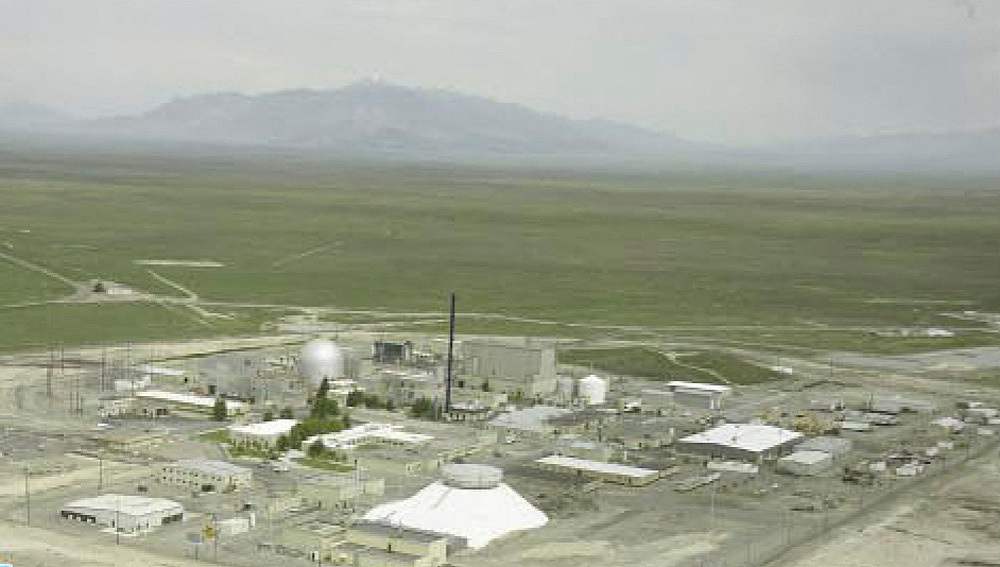
Business Chevron

Costco's Japan wages provide pathway to firing up nation's low pay, economy
When Costco Wholesale opened its warehouse in a rural Japanese town not far from Tokyo last year offering hundreds of jobs at eye-popping pay, a nearby noodle shop chain took a drastic step: it hiked hourly wages by a third.

Fresh volcanic eruption in Iceland triggers evacuation of town, Blue Lagoon spa
Eruption is the 5th since december.

Geologist explains the latest volcanic eruption in Iceland
Social sharing.
A volcano in southwestern Iceland erupted Wednesday for the fifth time since December, spewing red lava that again threatened the coastal town of Grindavik and led to the evacuation of the popular Blue Lagoon geothermal spa.
The eruption began in the early afternoon following a series of earthquakes north of the town of 3,800 people that was largely evacuated in December when the volcano came to life after centuries of dormancy and put on an impressive show of nature's power.
Although activity began to calm down by early evening, the eruption was estimated to be the area's most vigorous so far, as lava shot 50 metres into the sky from a fissure that grew to 3.5 kilometres in length, the Icelandic Meteorological Office said.
Barriers built to protect Grindavik deflected the flowing lava that cut off two of the three roads leading to town and was close to reaching the third.
"It's a much larger volume that's on the move right now headed for town," Grindavik Mayor Fannar Jónasson told national broadcaster RUV. "The lava has already conquered [a lot]."
Workers and anyone still in town were ordered to leave earlier in the day, police said. The Blue Lagoon thermal spa — one of Iceland's biggest tourist attractions — was evacuated before the eruption began, RUV said.

#TheMoment a photographer captured a 'surreal' Icelandic volcano eruption
At one point, a dark plume of ash boiled up over the crater from an explosive interaction of magma hitting groundwater, scientists said.
The cloud did not rise high enough to initially pose any threat to aviation, but scientists were closely monitoring the situation, Jóhanna Malen Skúladóttir, of the Met Office, told RUV.
Grindavik, located about 50 kilometres southwest of Iceland's capital, Reykjavik, has been threatened since a swarm of earthquakes in November forced an evacuation ahead of the initial Dec. 18 eruption . A subsequent eruption overwhelmed some defensive walls and consumed several buildings.
The area is part of the Svartsengi volcanic system that was dormant for nearly 800 years before reawakening.
The volcano erupted again in February and March . The Feb. 8 eruption engulfed a pipeline, cutting off heat and hot water to thousands of people.
- Analysis: Bob's blog What makes Iceland so volcanically active? Shifting plates below the island nation
- Iceland's erupting volcano an 'unforgettable' close encounter, says Alberta photographer
Iceland, which sits above a volcanic hot spot in the North Atlantic, sees regular eruptions and is experienced at dealing with them. The most disruptive in recent times was the 2010 eruption of the Eyjafjallajokull volcano, which spewed huge clouds of ash into the atmosphere and led to widespread airspace closures over Europe.
The latest eruption was unlikely to pose a risk to air travel, according to a report from national broadcaster RUV, quoting Guðjón Helgason, press officer with airport operator ISAVIA.
Related Stories
- Feb 24: Icelanders reap the costs and benefits of living on a volcanic island and more…
- Iceland's famous Blue Lagoon evacuated as volcano erupts for 3rd time
- Houses in Iceland 'split apart' by tremors as volcanic eruption looms

Complete Guide to the 2021 Volcanic Eruption in Geldingadalur Valley by Fagradalsfjall Volcano

2021 Eruption of Fagradalsfjall Volcano
Visiting fagradalsfjall volcano, photographing fagradalsfjall volcano, how does fagradalsfjall volcano compare to other icelandic volcanoes, formation of fagradalsfjall volcano, fagradalsfjall volcano since settlement, future of the fagradalsfjall volcano.
Discover all you need to know about the 2021 Geldingadalur volcano eruption in Iceland! Here, you can find many beautiful photographs and fascinating facts about one of Iceland's most recently active volcanoes!
- Learn more: Complete Guide to the 2024 Sundhnukagigar Volcanic Eruptions
- See also: Complete Guide to the 2024 Hagafell Volcanic Eruption
- Check out the Guide to the 2023 Sundhnukagigar Eruption and the Guide to the 2023 Eruption of Litli-Hrutur Volcano
- Read about the 2022 Volcanic Eruption of Fagradalsfjall Volcano
In 2021, the Land of Ice and Fire lived up to its name when a volcano erupted on Reykjanes peninsula! For nearly a year, within the Geldingadalur valley, gleaming lava spurted and flowed from Fagradalsfjall volcano, and in July 2023, another eruption took place close to the mountain Litli-Hrutur . The fourth eruption then burst from the ground by the Sundhnukagigar crater row in December 2023, after over a month of dramatic seismic activity. It was closely followed by the Hagafell eruption on January 14th, 2024, and another three eruptions in Sundhnukagigar in February, March, and May 2024.
Making this phenomenon even more exciting was its location. The Reykjanes peninsula is familiar to all travelers to Iceland, as it connects Keflavik International Airport with the country's capital, Reykjavik . The region is also home to the Blue Lagoon . It was the most accessible eruption in Iceland since the country has become a significant tourist destination. After the recent eruptions on the peninsula, tours of Reykjanes are becoming more popular among visitors.
Of course, whenever such an event happens in Iceland, questions arise as quickly as the magma from the earth. Was the volcano in Iceland dangerous? Will regular eruptions continue? Could you visit Fagradalsfjall and watch the eruption with your own eyes? Answer all your questions here with this complete guide to the Fagradalsfjall eruption in Iceland!
- Check out these 10 Insane Photographs of the Fagradalsfjall Volcanic Eruption in Geldingadalur
- Explore Iceland's volcanic landscapes with these Volcano Tours
- Discover this Ultimate Guide to Volcanoes in Iceland
Starting on March 19th at around 9:30 PM, the much anticipated volcanic eruption at Gelingdalur on the Reykjanes Peninsula began. Initially, it was reported as a fissure up to half a mile long (700 meters), with a lava field covering around a square mile (a square kilometer) before it soon formed into an increasingly tall crater.
Although no one knew quite where or when a volcanic eruption would happen, it was inevitable that one would after 53,000 tremors had shaken Reykjavik and its surroundings in the weeks prior. There were no significant injuries despite one of these tremors reaching 5.7 on the Richter Scale and several others getting close.
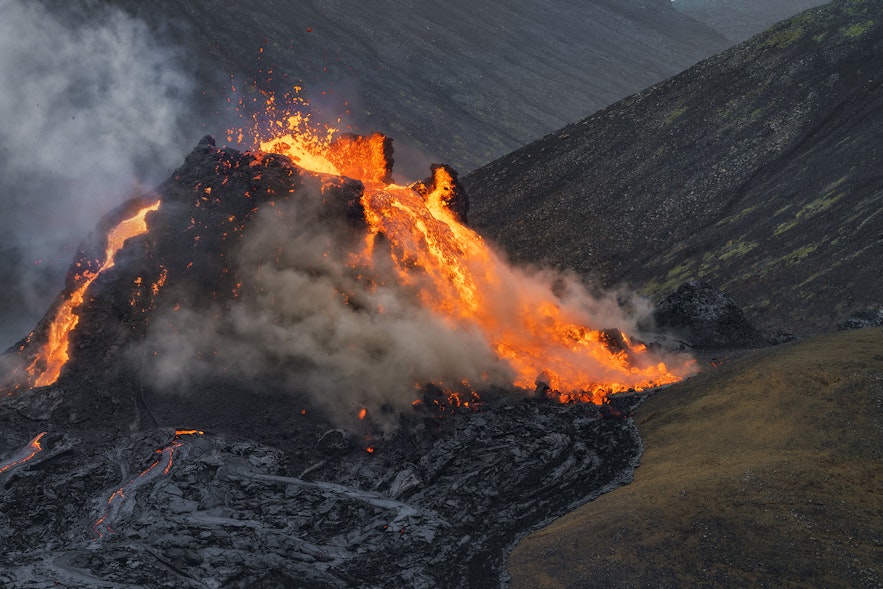
Thankfully, Fagradalsfjall went along the same course. Despite its primordial, terrifying presence, appearing more like Mordor than anywhere earthly, it posed little threat to life, infrastructure, or air travel for two notable reasons.
Firstly, it was an effusive eruption rather than an eruptive one. Lava did not burst from the earth in an explosion of ash, rock, and fire, as happened at Eyjafjallajokull in 2010. Instead, it emerged as an open fissure releasing much more gentle lava flows in the form of molten rivers.
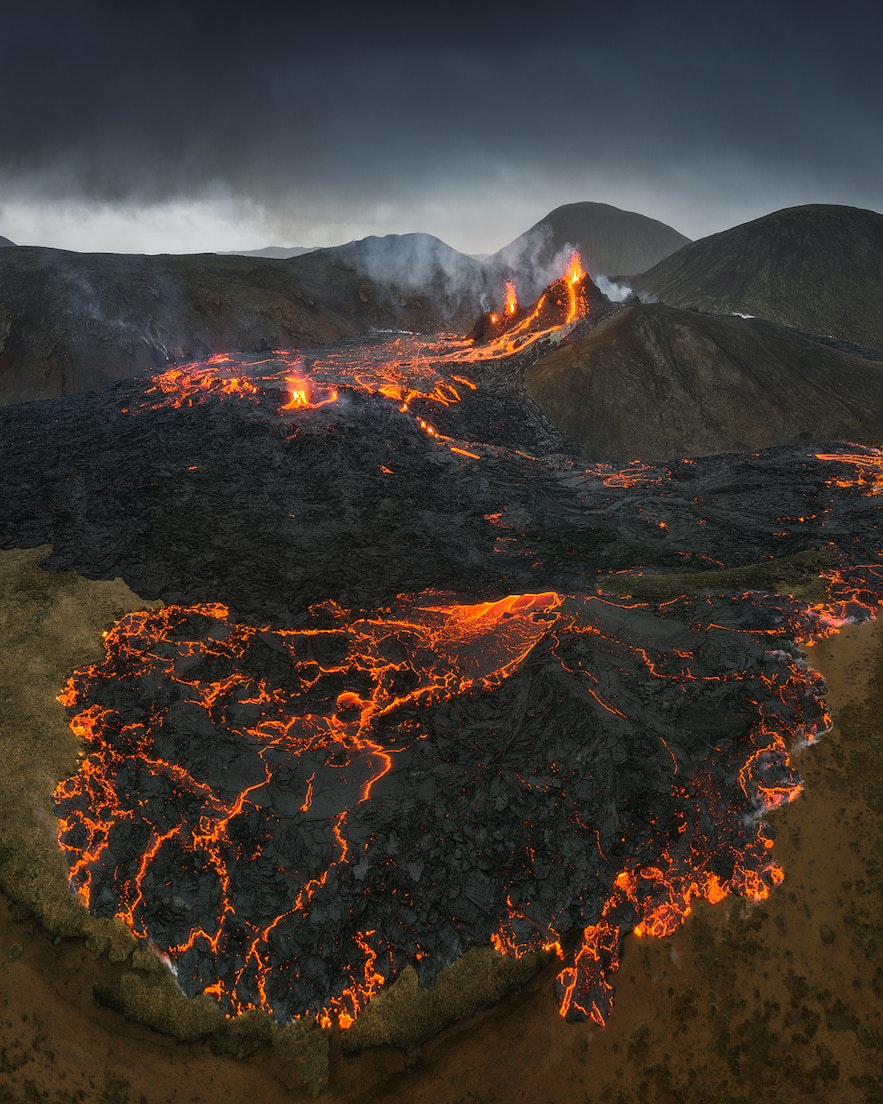
Secondly, the eruption occurred in a sheltered valley. Geldingadalur is mainly uninhabited and without significant infrastructure, making it one of the most convenient places it could have gone off in the region.
That is not to say, however, that it was predictable. Fagradalsfjall changed several times since it first opened, with new fissures and craters forming as the lava field developed. Furthermore, the fountains of fire significantly varied in their size, sometimes rising just a few meters in the air and sometimes shooting so high that they were visible from Reykjavik.
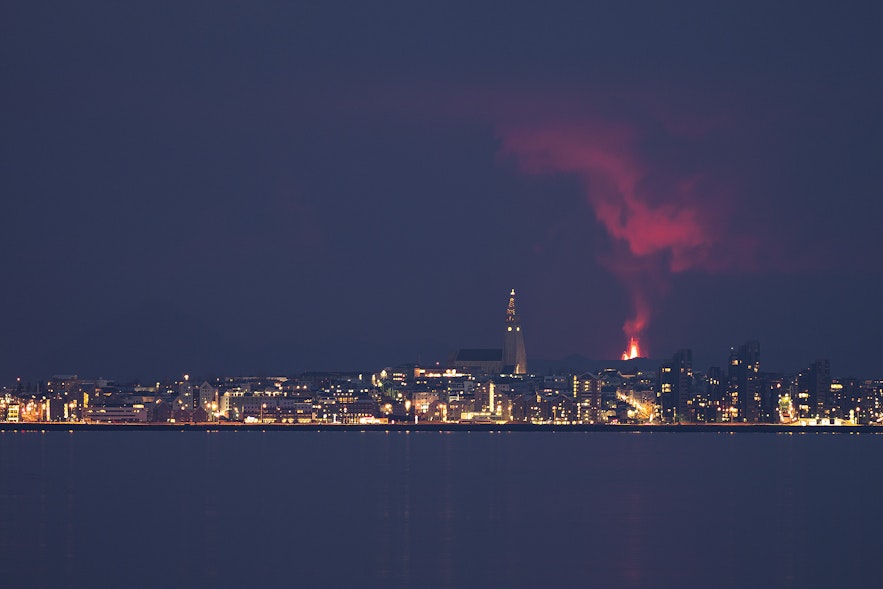
Those with respiratory conditions had to show caution if considering a visit, as the fumes coming from the volcano are by far their most dangerous quality. Even those living in the surrounding towns can exacerbate their symptoms if the winds blow from the eruption site's direction, carrying toxic gases such as sulfur dioxide, carbon dioxide, and hydrogen sulfide.
An interesting note about the Fagradalsfjall eruption - particularly to those fascinated by geology and volcanism - is the qualities of the lava that emerged from it. According to early data, this is the oldest lava that has occurred in Iceland for 7,000 years.
This can be attributed to the deep magma chamber beneath it, usually only found at the bottom of ocean rifts.
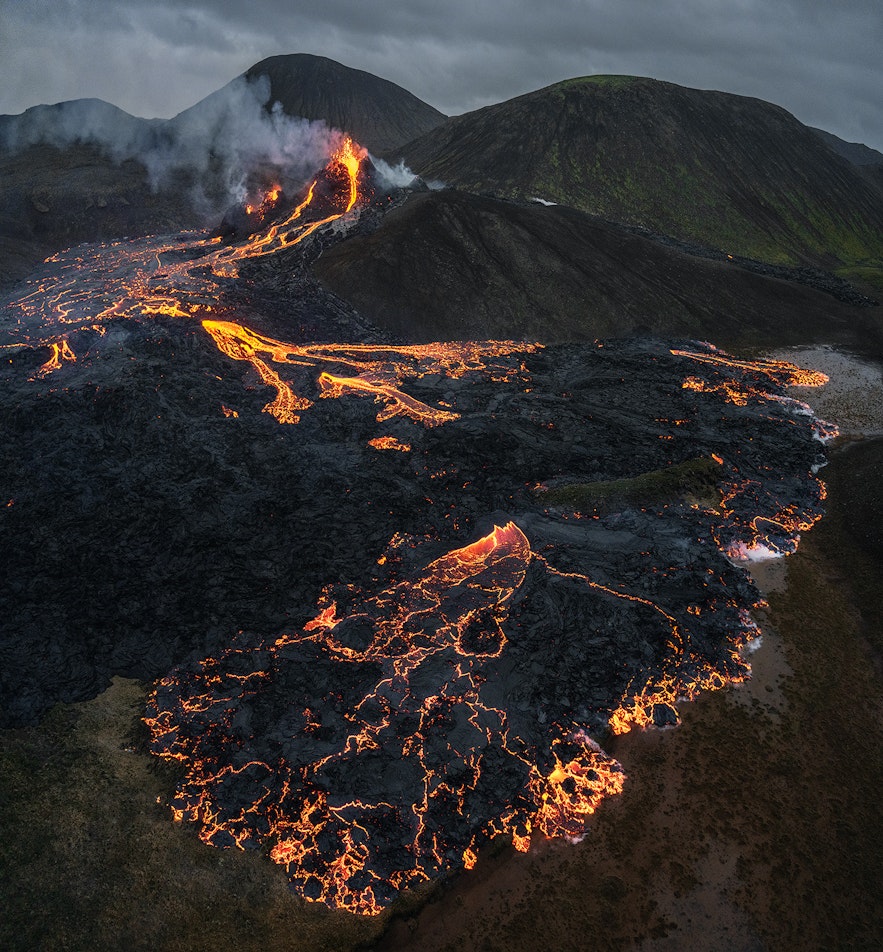
Fagradalsfjall has so far been a very visitor-friendly place to visit if travelers make sure to follow all safety precautions.
Currently, the whole area is closed off because of the recent December eruption by the Sundhnukagigar crater row, just outside Grindavik. It's only possible to visit the area up close with this volcano helicopter tour , letting you explore the aftermath of the eruption site from a birds-eye view. It remains to be seen if and when hiking paths will be created for the eruption site. Make sure to check the SafeTravel website for updates, and please respect the closure.
If the area is declared safe to enter, it's best to join volcano tours with a guide for optimal safety and convenience, as there are still many dangers in the area.
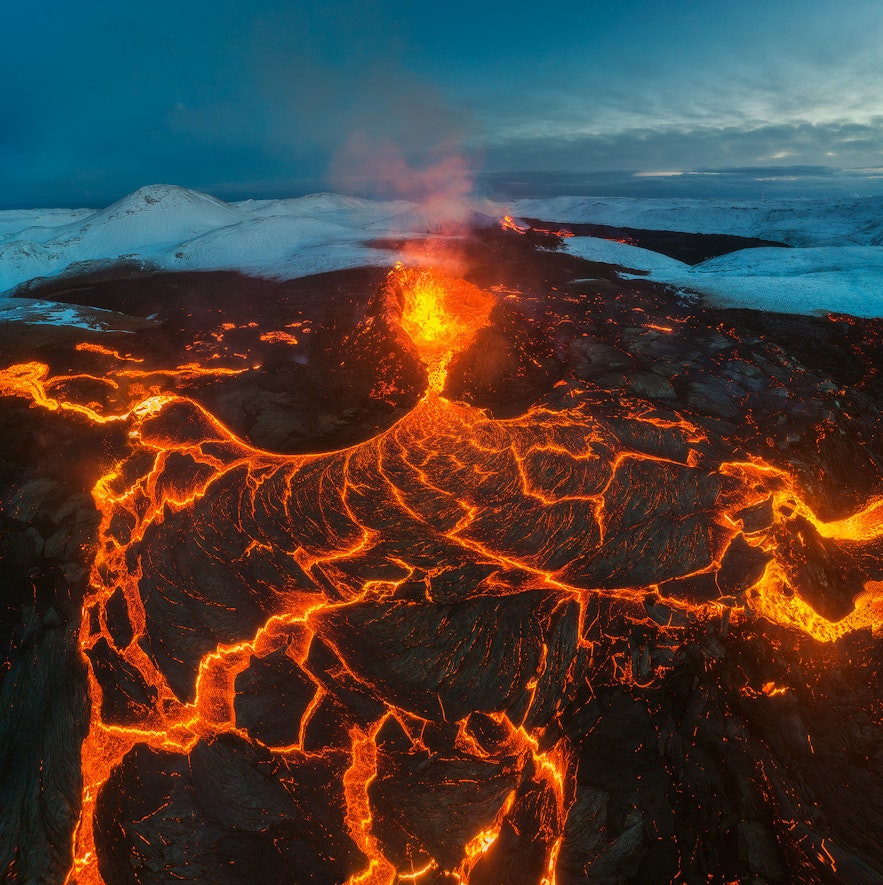
The original hiking trail to the previous eruption site of Litli-Hrutur volcano is around 12 miles (20 kilometers) in total and can be quite challenging.
While you will be able to visit without an experienced guide, it is not recommended, as no proper roads lead directly to the site. This is challenging for those not knowledgeable of the local area, particularly considering the rugged terrain and cold weather.
See also: Dumbest Things to Do in Iceland
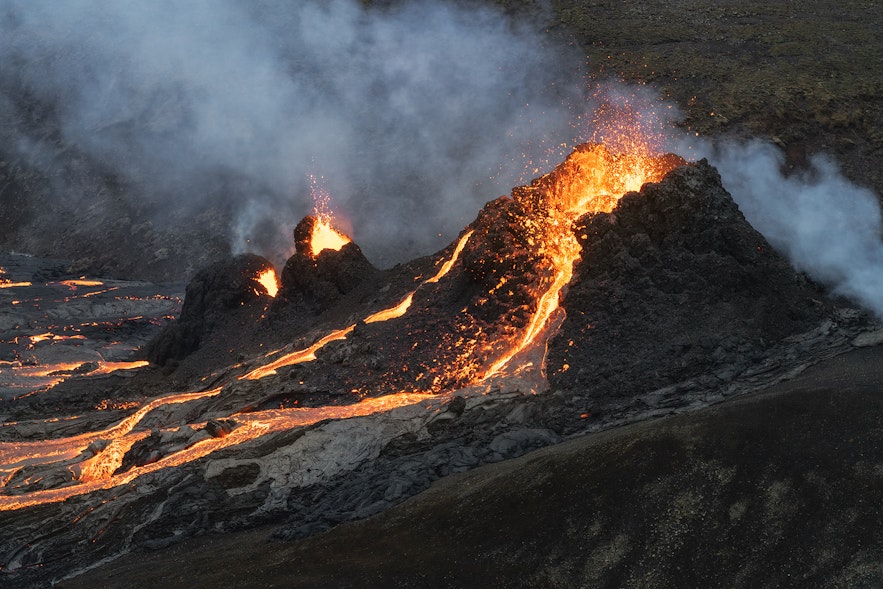
Furthermore, Iceland's tour guides are educated on the risks of the weak, new lava. They can allow you to get as close as safely possible without relying on oblivious and incredibly dangerous guesswork.
Top Helicopter Tours
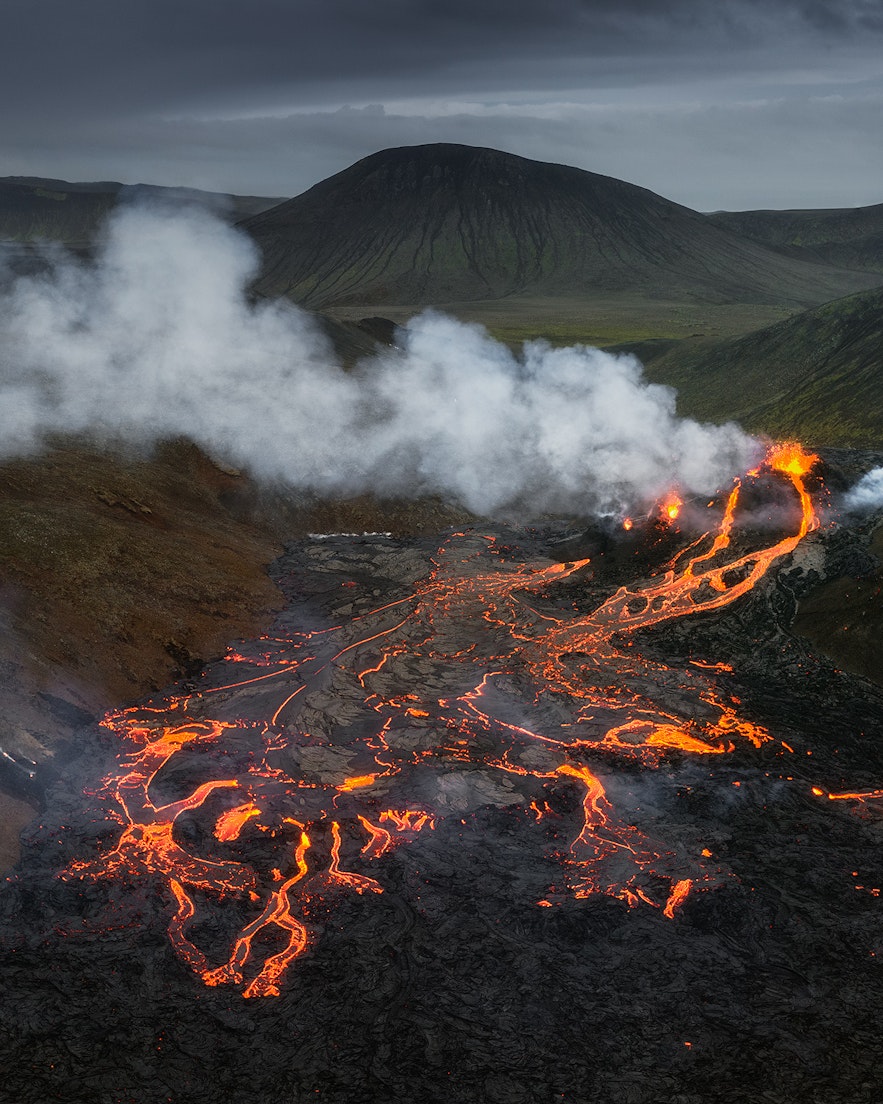
Visiting and marveling over the eruption at Fagradalsfjall was a breathtaking experience that many guests caught on camera. This phenomenon's videos and photographs inspire awe in anyone seeking them online and provide incredible mementos that lucky travelers can treasure for life.
Top Photo Tours
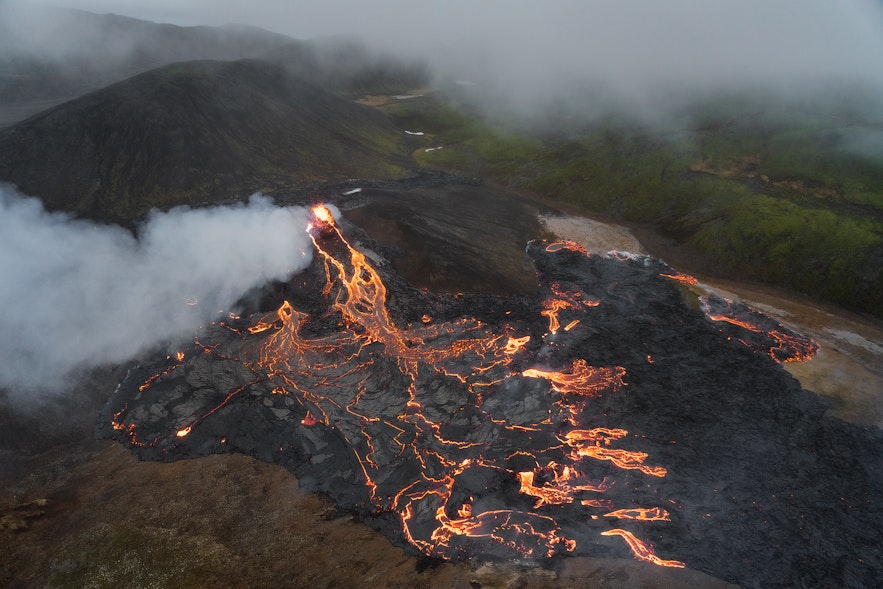
When visiting, you'll be able to capture the field of new lava fields with a good camera or by flying over with a drone.
Before rushing to the site with all your technical equipment, know the rules of flying drones in Iceland. While we have an article on flying drones in Iceland where you can learn about this in-depth, the main restrictions for their use at Fagradalsfjall are below:
- The drone must be marked with your name, address, and phone number
- The drone cannot exceed 25 kilograms
- Keep the drone below 250 meters
- Do not fly over the crowds
- Keep your drone away from other drones and far away from any crewed aircraft.
- See also: Photography in Iceland
Despite its epic beauty and awe-inspiring power, Fagradalsfjall was not just minor compared to Iceland's recent eruptions; it was practically minuscule.
Out of all the eruptions that have happened here since 2010, it most resembles Holuhraun . Both were effusive eruptions that opened in a lava landscape rather than beneath a glacier. Holuhraun produced the most extensive lava field that Iceland has seen since 1783, covering an area of over 9.1 square feet (85 square kilometers) and thus absolutely dwarfing this Fagradalsfjall eruption, which covered just 5.1 square miles (4.8 square kilometers).
- See also: 15 Incredible Photographs of the Holuhraun Volcano in Iceland
Eyjafjallajokull and Grimsvotn , meanwhile, have very little in common with Fagradalsfjall. Both of these were enormous, explosive eruptions that occurred under ice caps, producing a different range of much more severe dangers. They released vast ash clouds that grounded flights, poisoned crops, and triggered evacuations in the surrounding areas due to the risk of glacial floods and pyroclastic flows.
- See also: Volcanic Eruptions in Iceland: A History of Fire

Although the above eruptions were more extraordinary volcanic events than Fagradalsfjall, they lacked easy accessibility. Holuhraun and Grimsvotn are both in the central Highlands , and while Eyjafjallajokull's South Coast location isn't hard to reach, its ash cloud stopped many prospective admirers from getting to it!
Fagradalsfjall's eruption site, meanwhile, was less than an hour's drive from Reykjavik, less than half an hour from Keflavik International Airport, and around fifteen minutes from the Blue Lagoon.
- See also: Documentaries About Icelandic Volcanoes
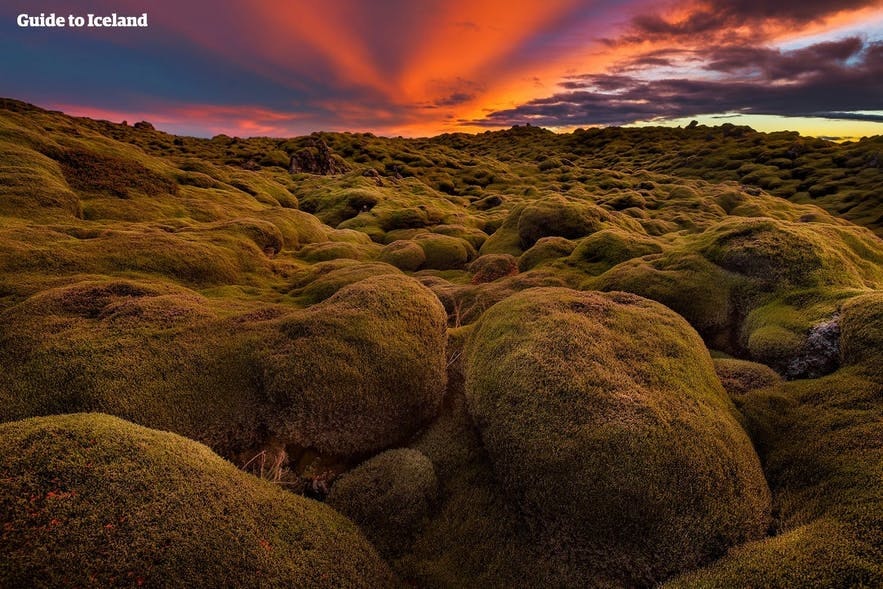
The Fagradalsfjall volcano is a relatively "young" part of Iceland; all of the Reykjanes peninsula is. This means that it was only formed by magma rising from the core of the earth recently - that is to say, over the past seven million years. The oldest parts of Iceland in the Westfjords are 16 million years old by comparison, and the oldest exposed land on earth in Australia dates back an incomprehensible four billion years.
This can be explained by the fact that Iceland was formed by a weakness in the Mid-Atlantic Rift, the separating divide between the North American and Eurasian tectonic plates. As these plates pull apart, magma rises to the surface and creates new land.
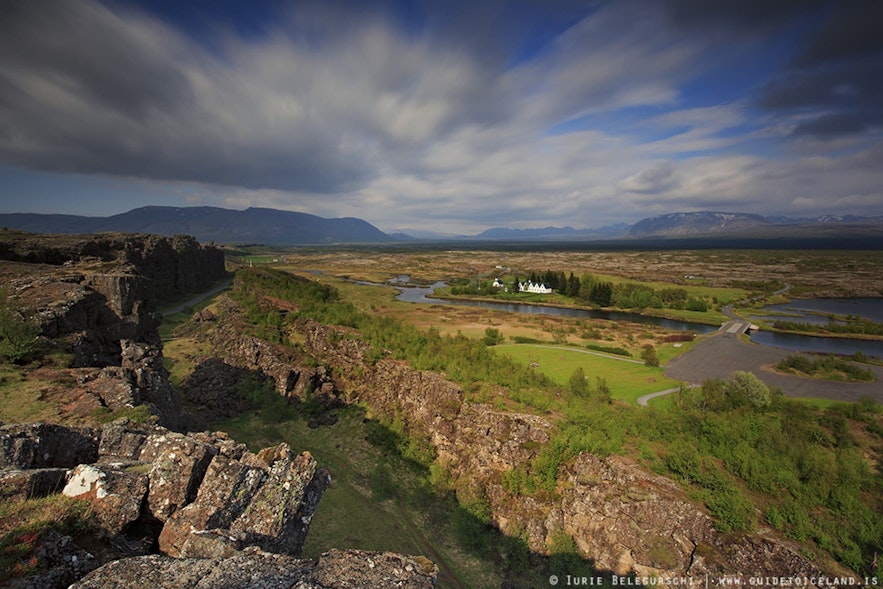
The closer to the Mid-Atlantic Rift, the newer the land, and this valley runs right along the length of the narrow Reykjanes Peninsula. The region is home to the Bridge Between the Continents , where you can walk from one plate to the other.
As such, Reykjanes is incredibly volcanic, and this activity is written all over its landscapes. Very little vegetation can grow on the endless plains of lava; geothermal areas seethe and bubble in many different spots, and cone-shaped volcanoes dominate the horizon. Eruptions occur very regularly - although, again, we are speaking in geological terms, as the last was 800 years ago.

Geldingadalur had not erupted for 800 years before 2021, although there had long been a magma chamber here. Many of Iceland's volcanoes exist this way, lying dormant until an unexpected fire and fumes are released.
The eruptions that have formed the Reykjanes peninsula landscapes have defined the region's way of life for centuries. It became a center of the country's fishing industry for early Icelanders as settlers could not grow food or feed livestock on the lifeless terrain.
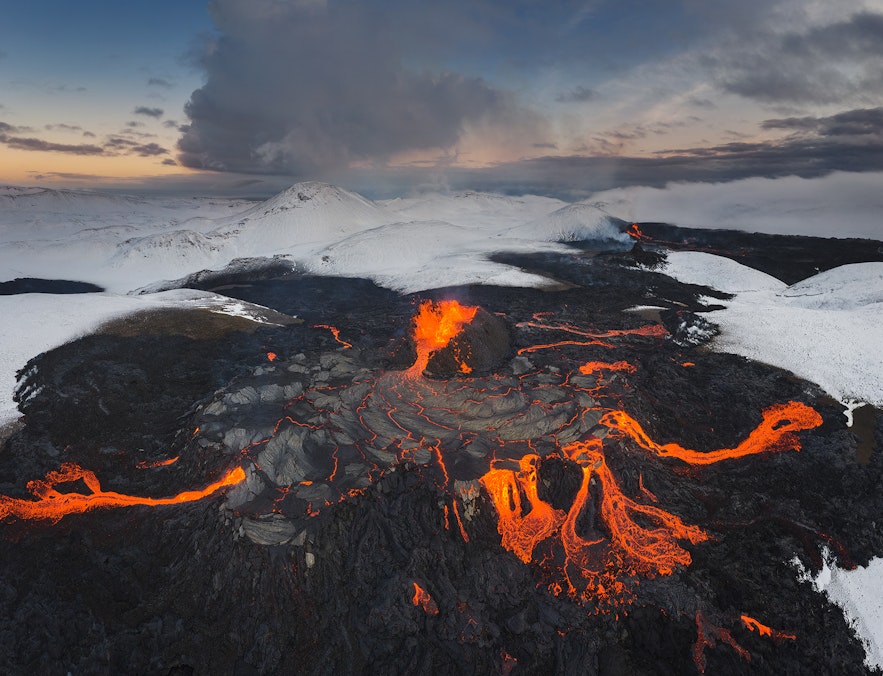
More recently, the volcanism of Reykjanes has led to a significant number of attractions for tourists to the area.
For example, you can embark on adventures into lava tunnels , quad bikes across black sand beaches , and enjoy relaxing, guided sightseeing tours !

Fagradalsfjall has mainly remained uninhabited since settlement; the nearest town is Grindavik, about seven kilometers away. This is because of steep-sloped valleys, which essentially prevent the area from being easily accessible. Furthermore, its inland location was useless to the fishing communities who relied on the seas to survive.
Little-explored places such as Geldingadalur, however, had an enormous impact on the history and culture of the Reykjanes Peninsula. The region's folklore of elves, ghosts, and witches is heavily inspired by the misty, desolate, and dangerous landscapes that the volcanoes have created.
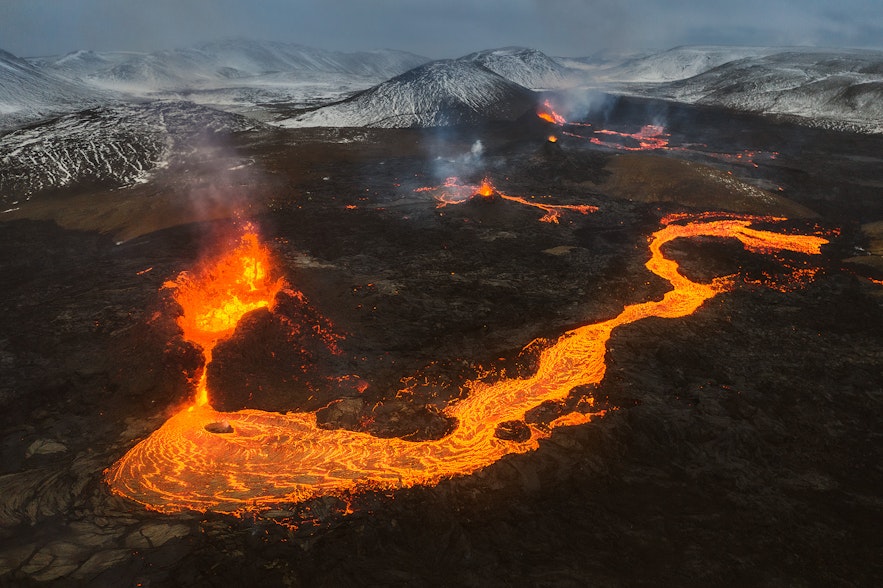
Places such as the ruins of Selatangar , the hot springs of Gunnuhver , and the troll pool of Brimketill are all steeped in fascinating fables.
Aside from its recent eruption, Fagradalsfjall has its own story in Iceland's history, although the tale is true and tragic. In 1943, during the Allied occupation of the country during World War Two, the famous bomber plane ' Hot Stuff ' was caught in bad weather during a mid-Atlantic fuelling stop and crashed into the mountainside.
- See also: Folklore in Iceland
Fourteen of the fifteen passengers on board died, including Frank Maxwell Andrews , the US Army Air Forces founder and a decorated Lieutenant General.
Andrews has plenty of monuments to his name across the world for his work in both World Wars, and there is one dedicated to him and the plane's other victims in Iceland. It was originally erected in 2018 by Fagradalsfjall, but in 2023, it was moved because of risk from the volcanic eruptions. It's now located at the intersection of the roads Reykjanesbraut and Grindavikurvegur .
- See also: The History of Iceland
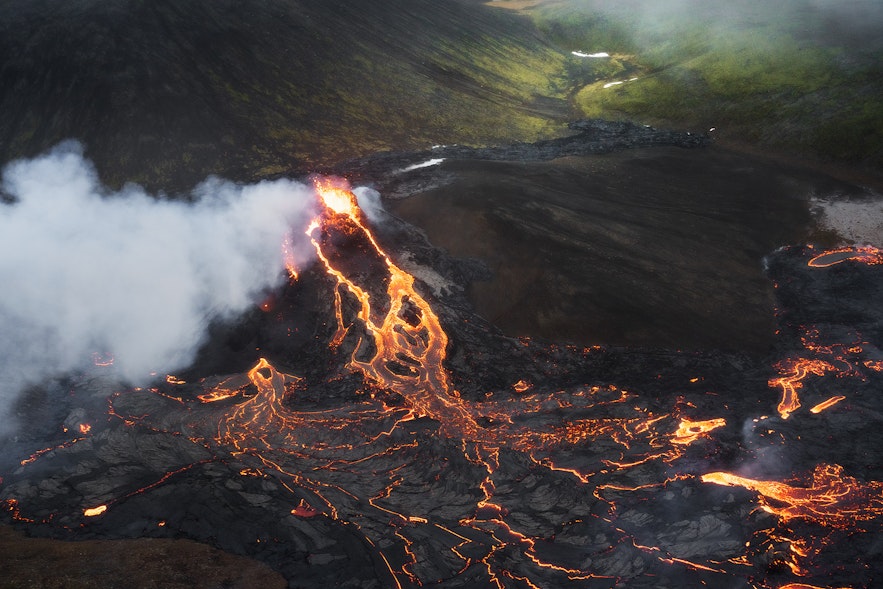
Due to the first and second eruptions' unfortunate overlap with the Covid-19 pandemic , many were unable to make the journey to witness the eruption. The 2023 eruption near Litli-Hrutur was as accessible and visitor-friendly as its predecessors, with many people taking the opportunity to see the eruption up close during the month that it lasted.
Because of reoccurring eruptions by Sundhnukagigar, it's not possible to let visitors in the area while this volcanic event develops. Some lucky ones have been able to see it from a distance from high points in the Capital Region and Keflavik. The area remains closed, and the only way to see the aftermath of the eruption up close is with helicopter tours .
The Fagradalsfjall area may erupt again in the future, though no one knows when. Experts continue monitoring the area closely. You never know when a new eruption will start, as there have already been seven eruptions in four years!
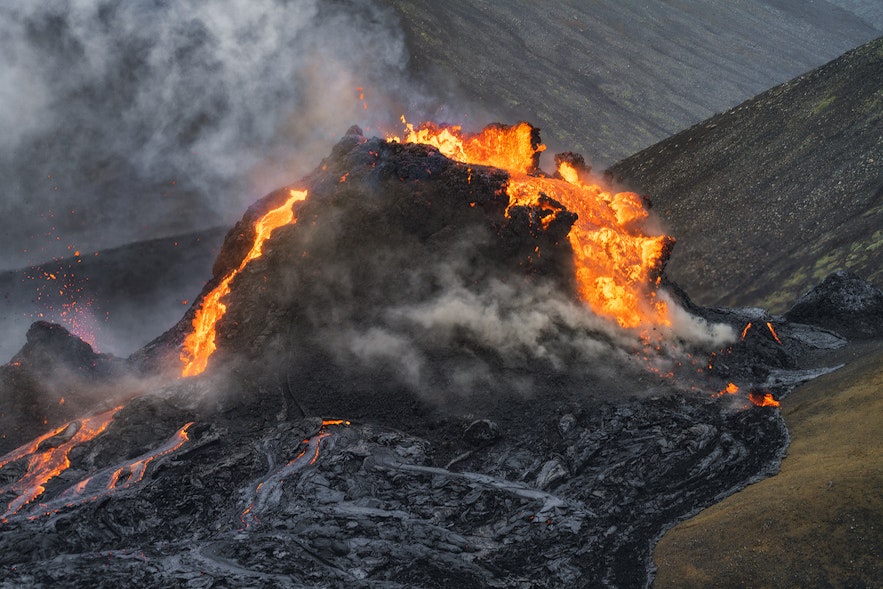
If seeing an erupting volcano is on your bucket list, it's always good to keep an eye on Iceland. The gap between this eruption and the country's last, at Holuhraun in 2014, was notably long, with new volcanic events usually occurring every few years. Grimsvotn's eruption, for example, was just three years before Holuhraun, and Eyjafjallajokull just a year before that.
Katla , Bardabunga , and Grimsvotn are all considered overdue and under constant surveillance.
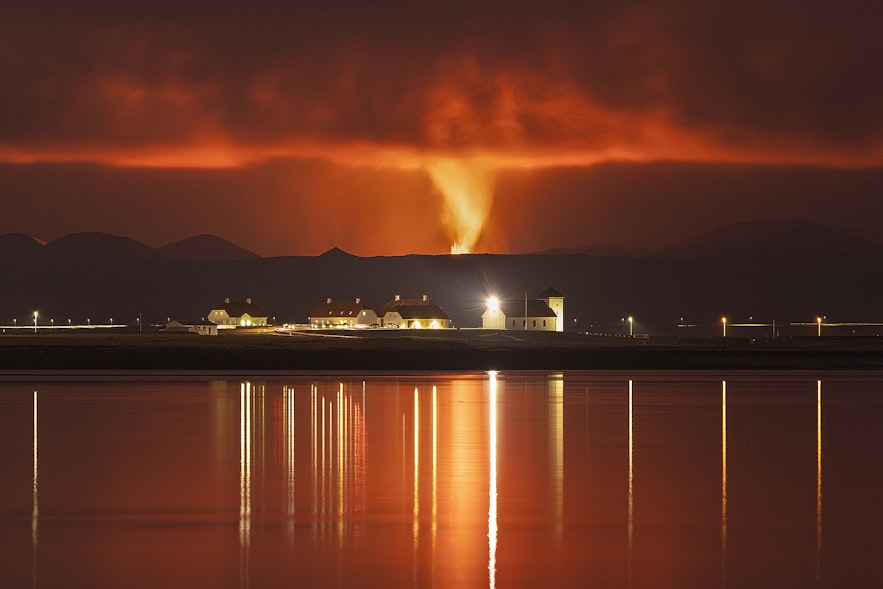
Do you have any more questions about the eruption at Geldingadalir? Did you go see the volcano for yourself? Let us know in the comments below!
Popular articles

Guide to Iceland | The Story of the Leading Travel Agency of Iceland

The Complete Guide to the Midnight Sun in Iceland

Top 20 Most Beautiful Waterfalls in Iceland

22 Photos of the Aurora in Iceland

Mountains in Iceland
Other interesting articles.
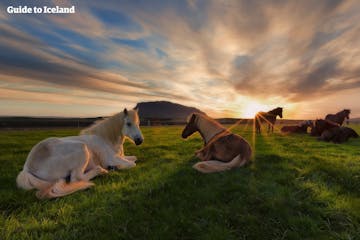
The Icelandic Horse | A Comprehensive Guide
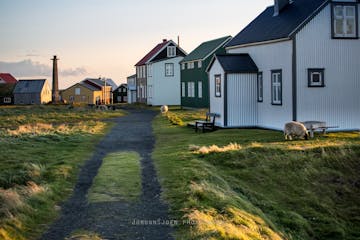
Top 5 Islands in Iceland
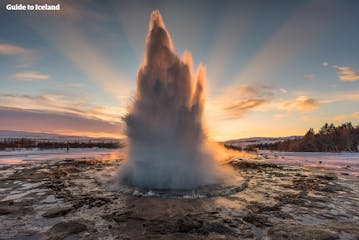
The Ultimate Guide to Iceland in March

Download Iceland’s biggest travel marketplace to your phone to manage your entire trip in one place
Scan this QR code with your phone camera and press the link that appears to add Iceland’s biggest travel marketplace into your pocket. Enter your phone number or email address to receive an SMS or email with the download link.
Top things to do in Iceland
Book your complete trip with the best companies only

Visit a Live Volcano

Visit the Blue Lagoon

Go on a Road Trip

Do the Golden Circle

See the Glacier Lagoon

South Coast Tours

Find the Northern Lights

Explore an Ice Cave
Icelandic volcano on Reykjanes Peninsula erupts for fifth time since December
A volcano in Iceland has erupted for the fifth time since December, shooting lava 50 metres into the air along a fissure that authorities say is more than 3 kilometres long.
Local media reported that a state of emergency had been declared by the Icelandic police force.
Icelandic authorities sent notices to locals and workers in the town of Grindavik, warning of an impending eruption Wednesday morning local time.
People were evacuated from the town and the nearby tourist hotspot Blue Lagoon geothermal pool just before midday, following an earthquake in the area.
The Icelandic Meteorological Office (IMO) said the lava "jets are reaching a height of at least 50 metres and the length of the fissure is about 3.4km long" in a statement on Wednesday afternoon, local time.
It said the coast guard helicopter was surveying the area to get a more accurate understanding of the eruption's size and location.
French tourist Maia Biegatch, had just arrived at the Blue Lagoon when the eruption occurred.
"We received alerts on our phones telling us to 'evacuate, evacuate', so we turned back," she told AFP.
"It was a total surprise."
Authorities had warned of the risk of renewed volcanic activity in the Reykjanes Peninsula, just south of the capital Reykjavik, as studies showed magma accumulated underground.
The IMO also recorded some 400 earthquakes in the area of the volcano's crater in the past week.
Iceland's Department of Civil Protection and Emergency Management said on social media that despite the call to leave, three residents remained in Grindavik — something it described as "not advisable".
The lava flow was heavy, estimated at between 1,500 and 2,000 cubic metres per second, the IMO said.
While authorities said that seismic activity had decreased significantly, it said lava had reached defences built to the west of Grindavik that were built to protect the town from eruptions.
Similar man-made barriers have been built to steer lava away from infrastructure including the Svartsengi geothermal power plant and the Blue Lagoon geothermal pool.
The latest event follows the end of another eight-week-long eruption on the peninsula that saw molten rock spew from the ground.
The fiery spectacle underlines the challenges the island nation of almost 400,000 people face as scientists have warned eruptions could happen over and over in Reykjanes for decades or even centuries.
The eruption was the eighth on the peninsula, home to some 30,000 people, since 2021 when geological systems that were dormant for some 800 years again became active.
Previous incidents had disrupted district heating, closed key roads and even razed several houses in Grindavik, where only a few residents have since returned.
Icelanders often refer to their country as the "Land of Fire and Ice" as a tribute to its otherworldly landscape forged by glaciers and volcanoes. Iceland is positioned between the Eurasian and North American tectonic plates, making it a seismic hotbed.
While a 2010 eruption in a different part of Iceland grounded some 100,000 flights internationally due to huge ash clouds, Reykjanes is typically home to fissure outbreaks which do not reach into the stratosphere.
ABC/Reuters
- X (formerly Twitter)
Related Stories
Lava shoots into sky as icelandic volcano erupts.
Iceland volcano erupts, spewing lava and hitting roads
Volcanic eruption sees Iceland fishing town evacuated for second time in a month
Eruption of Iceland volcano one of the most 'spectacular ever seen' say scientists
- Volcanic Eruptions

IMAGES
COMMENTS
See the Reykjanes Volcano Area. In recent years, one of the best volcanic experiences in Iceland, and possibly in the world, has been visiting the active volcanic eruptions on the Reykjanes peninsula. Lucky visitors to Iceland were able to watch real volcanic eruptions from a relatively safe distance, first by the Fagradalsfjall volcano in 2021 ...
The main active volcanoes in Iceland run along a curved central line roughly from northeast to southwest. From north to south, the volcanoes' names are Krafla, Askja, Laki-Fogrufjoll, Grimsvotn, Hekla, Vatnajokull, and Katla, followed by Heimaey and Surtsey on the Westman Islands. Grimsvotn is the most active volcano in Iceland. Iceland Volcano Map
Iceland has many active volcanoes, with the most recent eruption taking place by the Sundhnukagigar craters in 2023 and 2024. There have been seven eruptions in four consecutive years on the Reykjanes peninsula, the other most recent eruption being at Mt. Litli-Hrutur. It started on July 10th, 2023, and lasted for about a month.
Grímsvötn volcano. 🌋 Last eruption: 2021. 📍 Location: southeast Iceland ( map) Description: Grímsvötn, nestled under the Vatnajökull glacier, is Iceland's most active volcano, with about 65 known eruptions over the last 800 years. It's characterized by frequent, but relatively small eruptions. The heat of the volcano causes ...
4. The Lava Centre in Hvolsvöllur. If you came to Iceland to experience the Land of Fire and Ice, the Lava Centre museum in South Iceland is worth a visit. This innovative museum opened in 2017 not far from Mount Hekla, an active volcano that was considered to be the gateway to hell in the Middle Ages.
It's also one of the biggest and most active volcanoes in Iceland. The volcano has erupted 16-20 times in the last thousand years. The last eruption occurred in 1918. ... The best and safest way to visit a volcano is with a guided tour. Expert guides will be able to lead you to the eruption site, choosing the most secure paths and the optimal ...
2. New Volcanic Eruption Area: Helicopter Tour in Iceland. ⭐️ RATING: 4.5/5 Stars | ⏳ LENGTH: 30 to 40 min |📍 LOCATION: Fagradalsfjall | Book it! When you find yourself in Reykjavik, prepare for an extraordinary experience by taking a helicopter ride over the Fagradalsfjall Volcano.
The best active volcano to visit in Iceland is Fagradalsfjall. It was last seen erupting in August 2022, and there's a good chance it will spurt out more lava in future. Even if it doesn't erupt on your visit, you'll see fresh tracks of lava and brand new craters. ... Visit Iceland's volcanoes with Reykjavik Excursions.
The eruption in Fagradalsfjall is unparalleled to anything we've seen before. Rarely has an eruption been as accessible in Iceland as this ongoing eruption in Fagradalsfjall active volcano. It only takes about 50 minutes drive from Reykjavík to the parking lots. The parking lots mark the beginning of the walk to the eruption. From the.
Active Volcano Tours in Iceland. A new active volcano eruption started in Iceland on the Reykjanes Peninsula on July 10th, 2023! We are now booking tours to the eruption site! Don´t miss your chance to experience the amazing beauty of an active volcano in Iceland! Learn more about active volcanos on the Reykanes Peninsula .
With so much to choose from, it can be difficult to decide on which tours to go on. We're here to help though, with five of the best volcano day tours that Iceland has to offer, as chosen by our team of professional Arctic Adventurers! 6. The Mount Eyjafjallajökull Super Jeep Tour. Super Jeep Tour.
In 2021, after 6,000 years lying dormant, the Fagradalsfjall volcanic system on the Reykjanes Peninsula sprang back into life with the appearance of a 600ft-long fissure. Until that moment, the ...
Please note that there is a parking fee for both P1 and P2 and it is a different arrangement for each one of them. Further information on the parking is found below. The paths have challenging terrain with gravel, lava fields, uneven ground, and steep hills. The eruption site, hiking trails and views (2021, 2022 and 2023)
Drive to the trail head and follow the easily marked hiking trail to the volcano viewing site. Iceland Travel team hiking to the volcano site. Pace your day. Route A: Expect to spend about 2 - 3 hours of walking round-trip and about 1 - 2 hours viewing the volcano. Route B: Expect to take 3 - 4 hours round-trip hiking.
The more expensive, but more spectacular, option for seeing the erupting volcano in Iceland is from the air. Both small plane and helicopter tours are available, departing from Reykjavik domestic airport. Based on my research, most last 40 - 50 minutes and cost up to 57,000ISK (approx £330).
The Volcanic Way; Highlights; Towns; 360° Tour of Reykjanes Peninsula; Sundhnúkagígaröð & Eldvörp - 360° Aerial Panoramas ... Travel Info. Tours. Day Tour Provider; Northern Ligths Tour; Travel Agency; Luxury Tours; ... To Iceland by air; Things to know about Covid-19; Visitor Centres; News; Volcano news; Eruption Information.
How to Visit the Volcano in Iceland. An aerial view of lava pouring out of an erupting volcano in Iceland. If the volcano is erupting, the only way to visit the eruption is with a helicopter tour. The Reykjanes Peninsula has seen several eruptions in the last few years, and for the first few eruptions, hiking to the eruption site was possible.
Fagradalsfjall Hiking Trail - How To Visit The Active Volcano in Grindavik Iceland; 1 Day in Landmannalaugar - The Mount Blahnukur Trail; Discover Thakgil - A hidden gem in southern Iceland; Mulagljufur Canyon - Discover a true hidden gem in South Iceland; 7 Best Places To See in The Highlands in Iceland
On average, a volcano erupts in Iceland erupts every five years. Since 2021, however, the frequency has been closer to every 12 months! The area broadly known as Fagradalsfjall, some 35km from the capital Reykjavík, flared to life after a series of earthquakes on the Reykjanes Peninsula. The three eruptions - some consider one single eruption ...
Iceland is well-acquainted with volcanic activity, having experienced three previous eruptions nearby on the Reykjanes Peninsula in 2021, 2022, and 2023. Icelandic authorities and the public are thoroughly prepared for such events, and the country boasts some of the world's most sophisticated volcanic preparedness protocols.
The restrained Icelandic volcano Fagradalsfjall on the Reykjanes peninsula stepped into the spotlight on the evening of March 19, 2021, when an eruptive fissure opened in the Geldingadalir valleys. It had been quiet for over six thousand years and is the first active volcano in the Reykjanes UNESCO Global Geopark area for 800 years.
By Egill Bjarnason. Reporting from Husavik, Iceland. May 29, 2024 Updated 6:47 p.m. ET. A volcano in southwestern Iceland erupted on Wednesday for the fifth time since December, cracking the ...
Iceland Eruption Goes Another Round. A volcanic fissure on Iceland's Reykjanes peninsula reawakened in late May 2024. This eruption, the latest in a series that began in December 2023, was notable for its vigorous start. Some of the highest estimated lava flow rates of all the recent eruptions near Grindavík occurred in the first hours of ...
How the 2022 Fagradalsfjall Eruption Started. On August 3rd, 2022, the Fagradalsfjall volcano on the Reykjanes peninsula erupted. Weeks of earthquakes preceded the event, with the strongest tremors measuring above 5.0 on the Richter scale. Fortunately, no significant injuries or property damage were reported.
A volcano in southwestern Iceland sent glowing hot lava shooting more than 50 metres into the air on Wednesday, its fifth eruption since December and the most powerful one since its volcanic ...
A volcano in southwestern Iceland erupted Wednesday for the fifth time since December, spewing red streams of lava in the latest display of nature's power and triggering the evacuation of the ...
In 2021, the Land of Ice and Fire lived up to its name when a volcano erupted on Reykjanes peninsula! For nearly a year, within the Geldingadalur valley, gleaming lava spurted and flowed from Fagradalsfjall volcano, and in July 2023, another eruption took place close to the mountain Litli-Hrutur.The fourth eruption then burst from the ground by the Sundhnukagigar crater row in December 2023 ...
A volcano in Iceland has erupted for the fifth time since December, shooting lava 50 metres into the air along a fissure that authorities say is more than 3 kilometres long. Local media reported ...